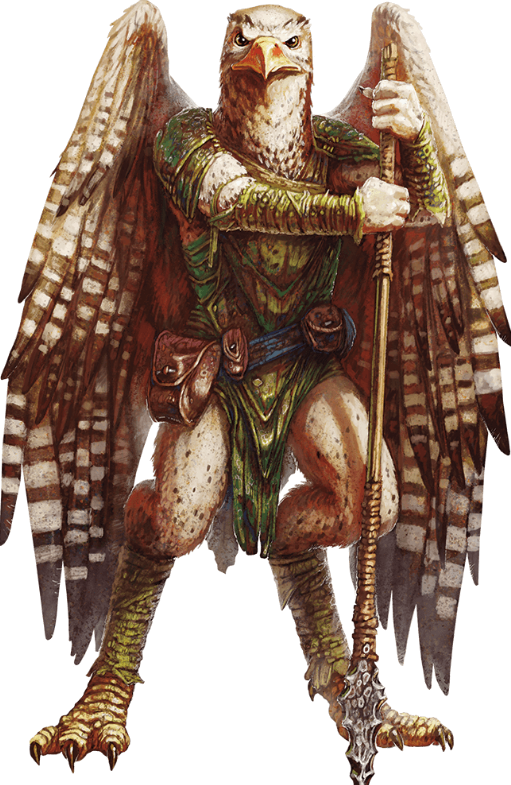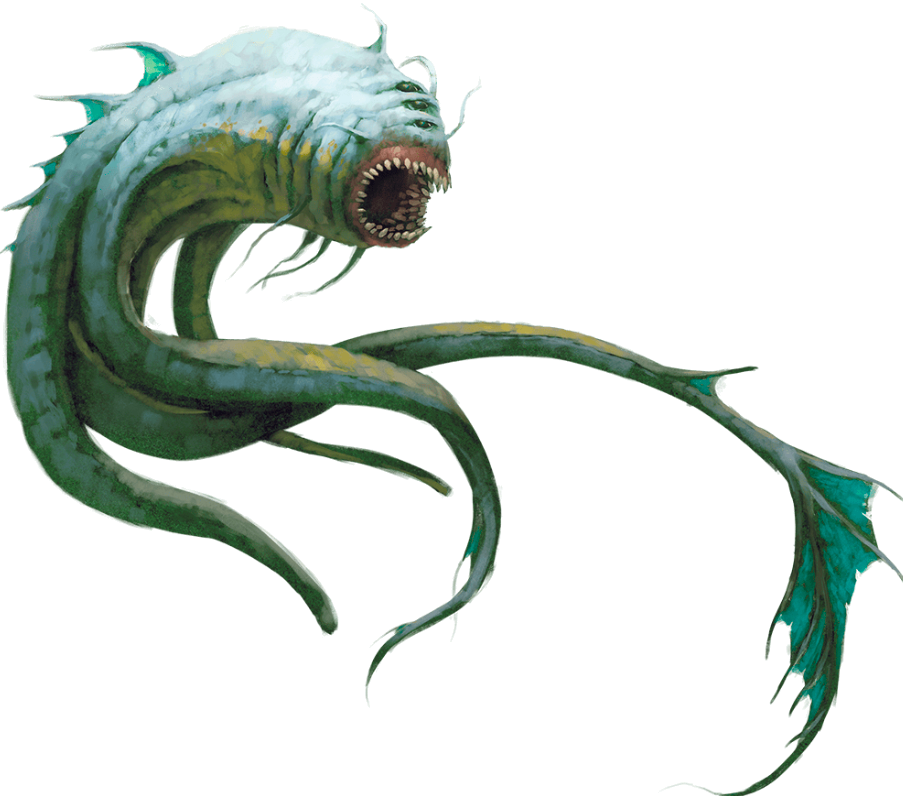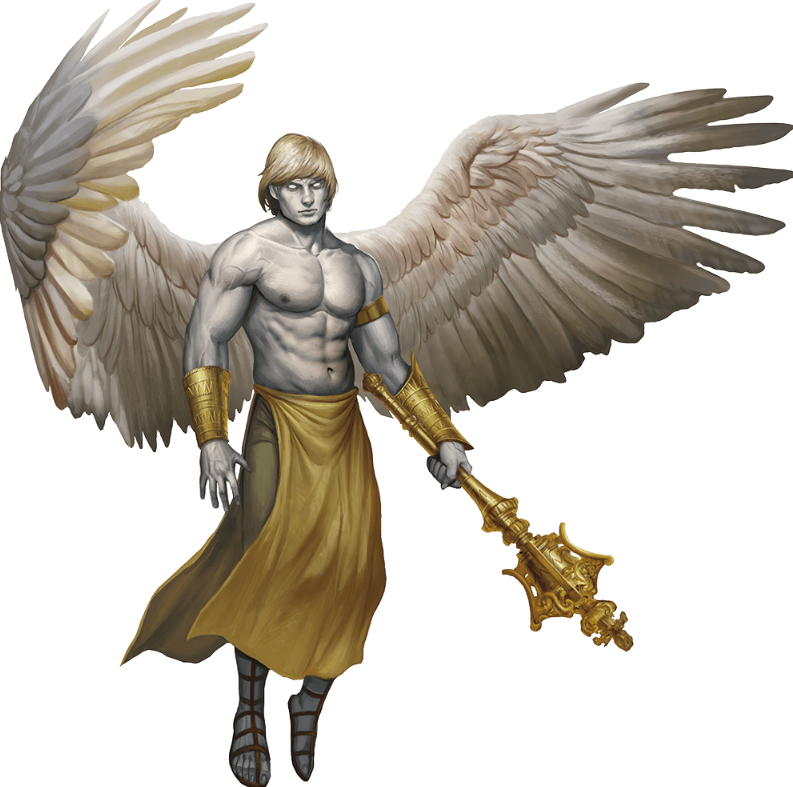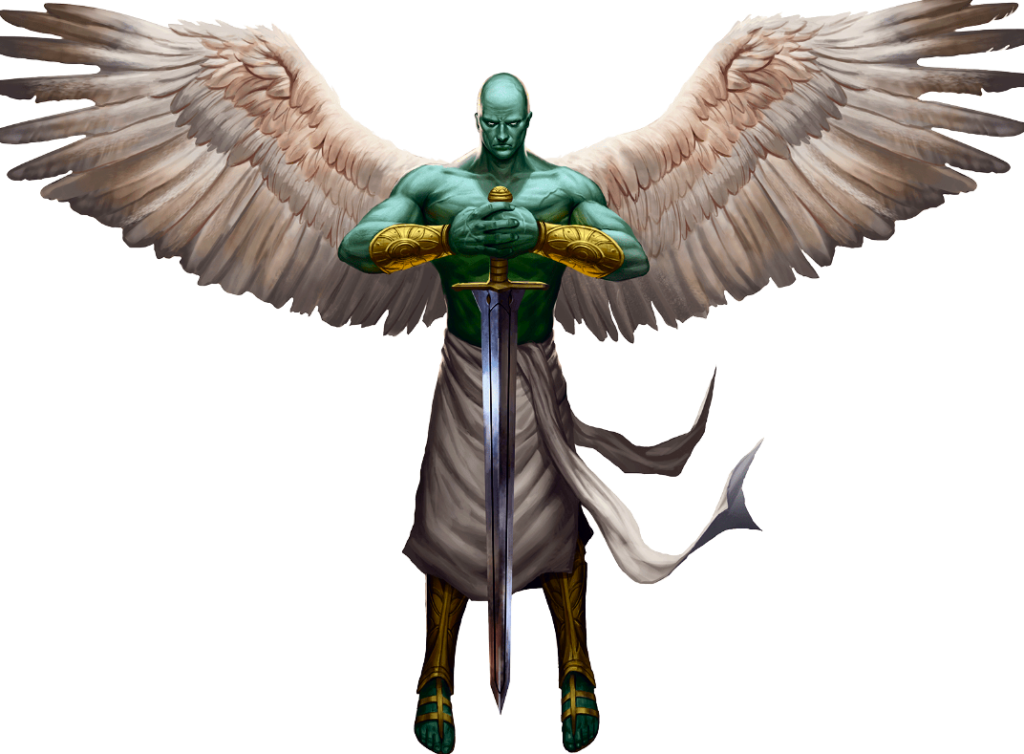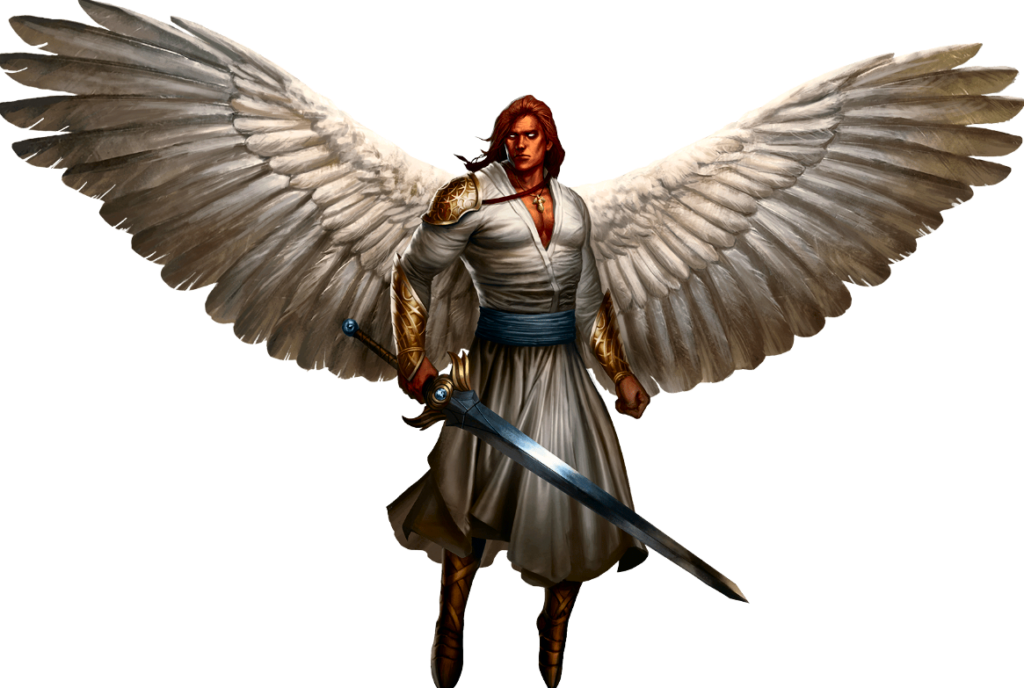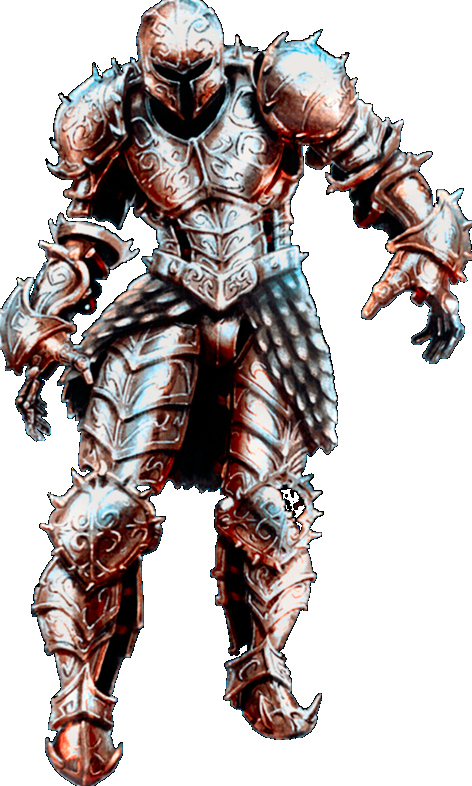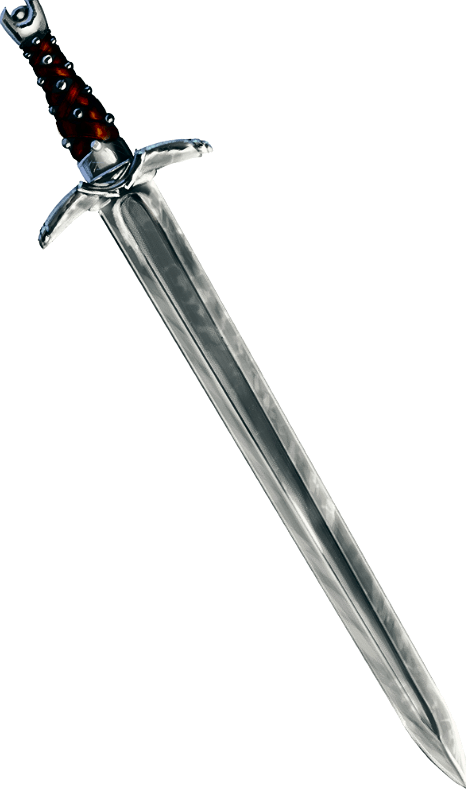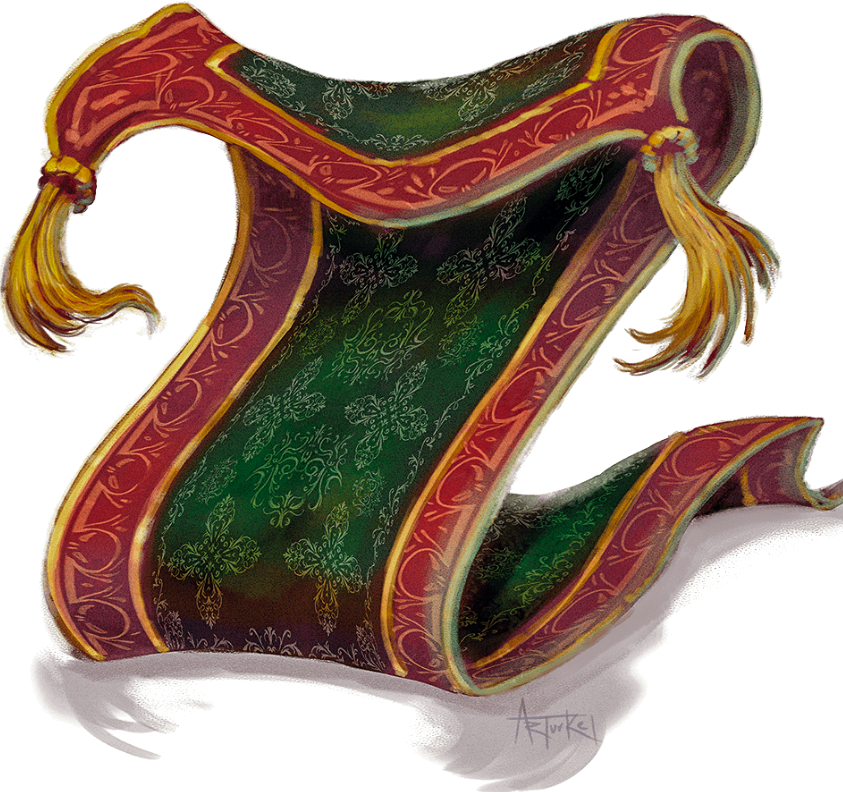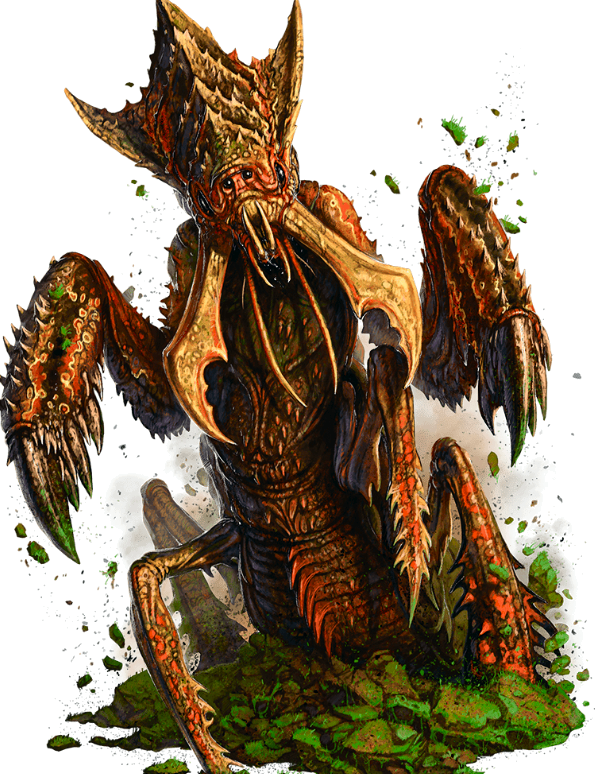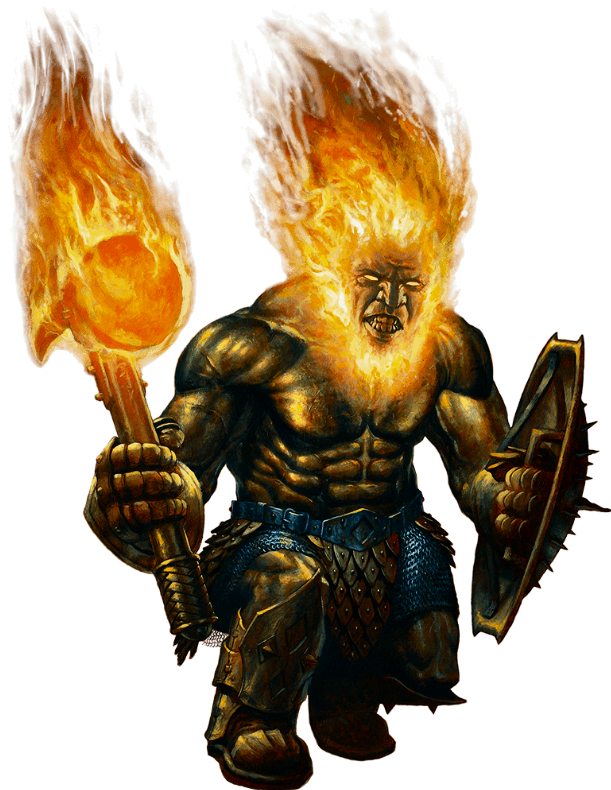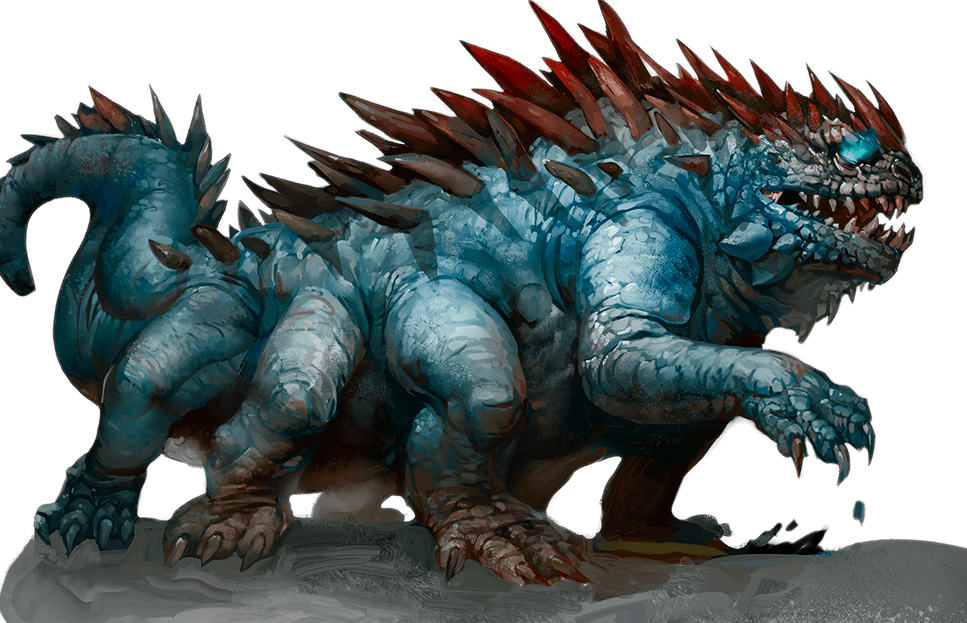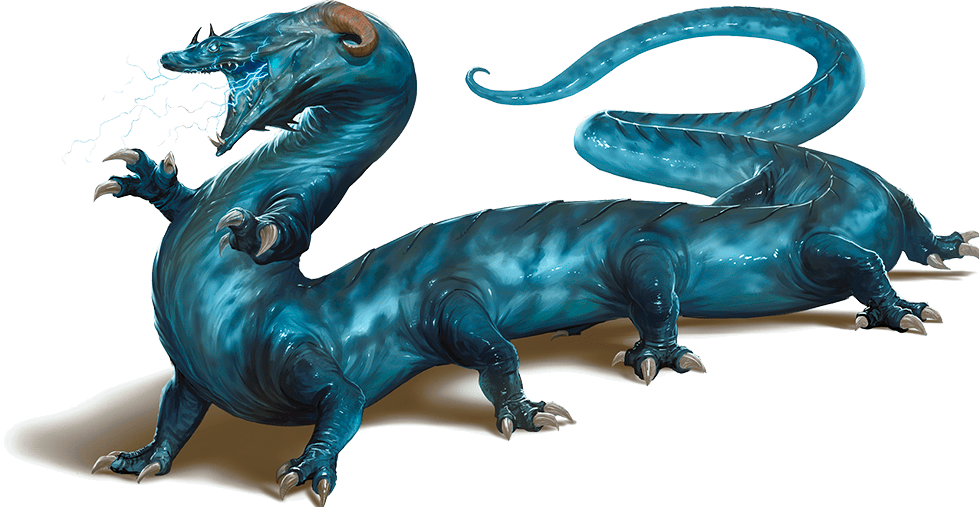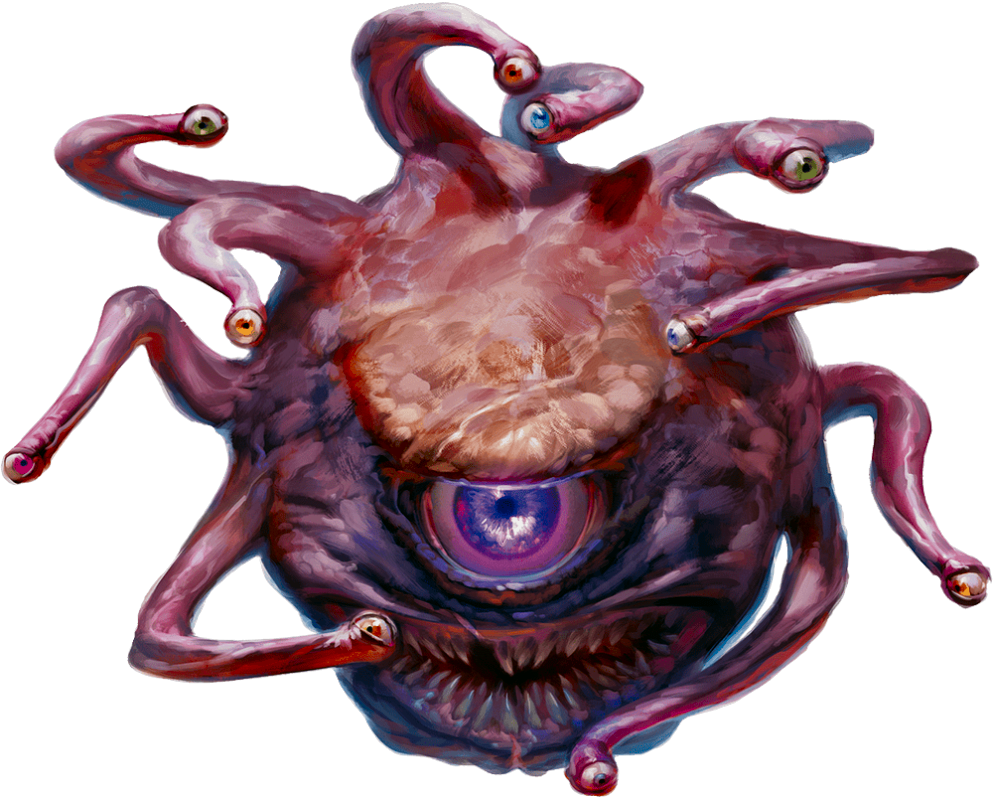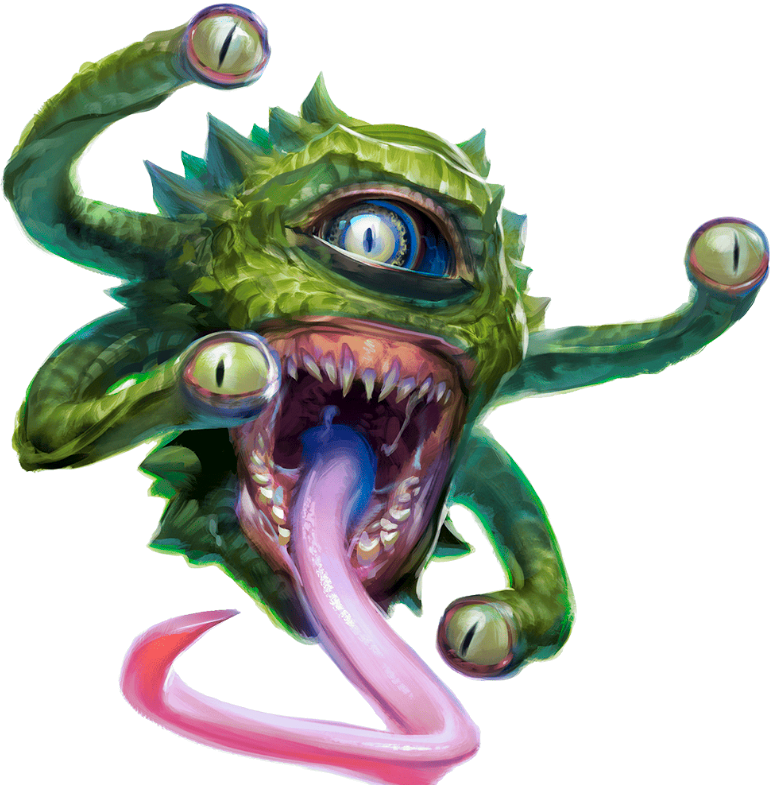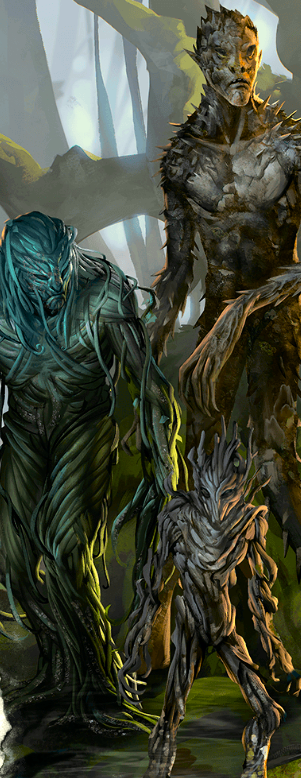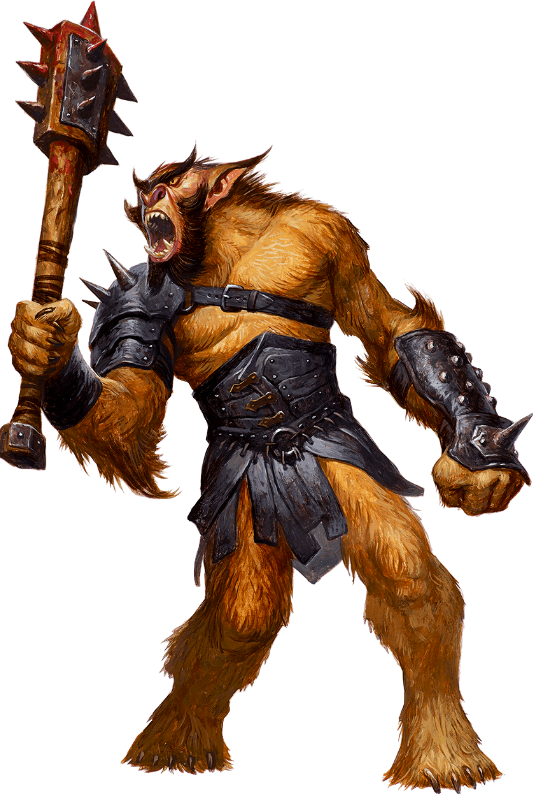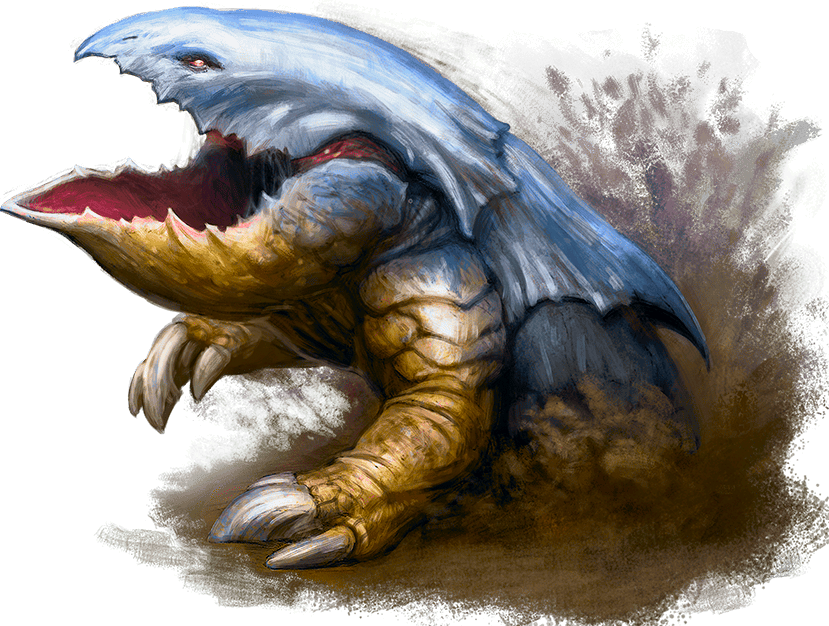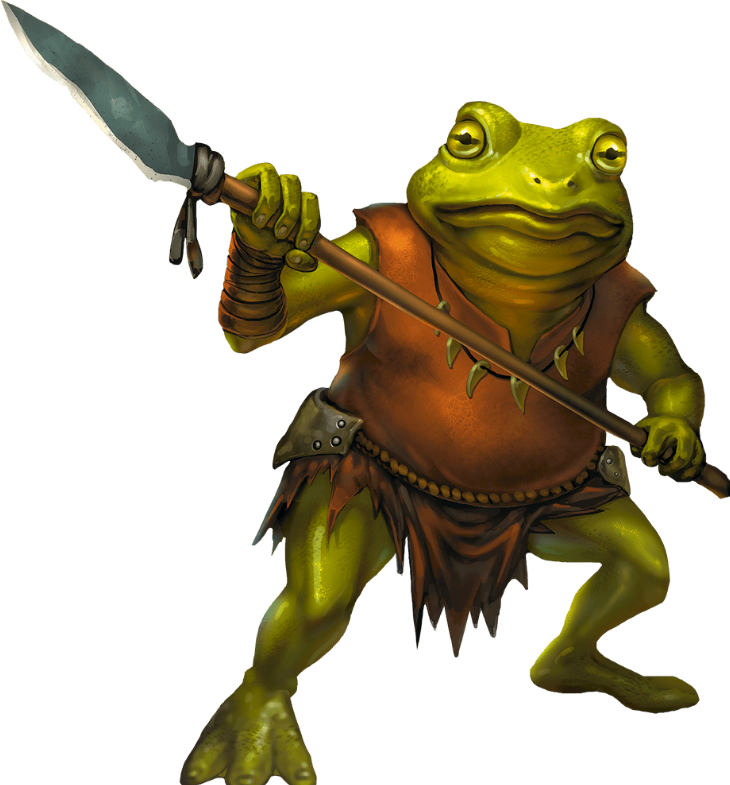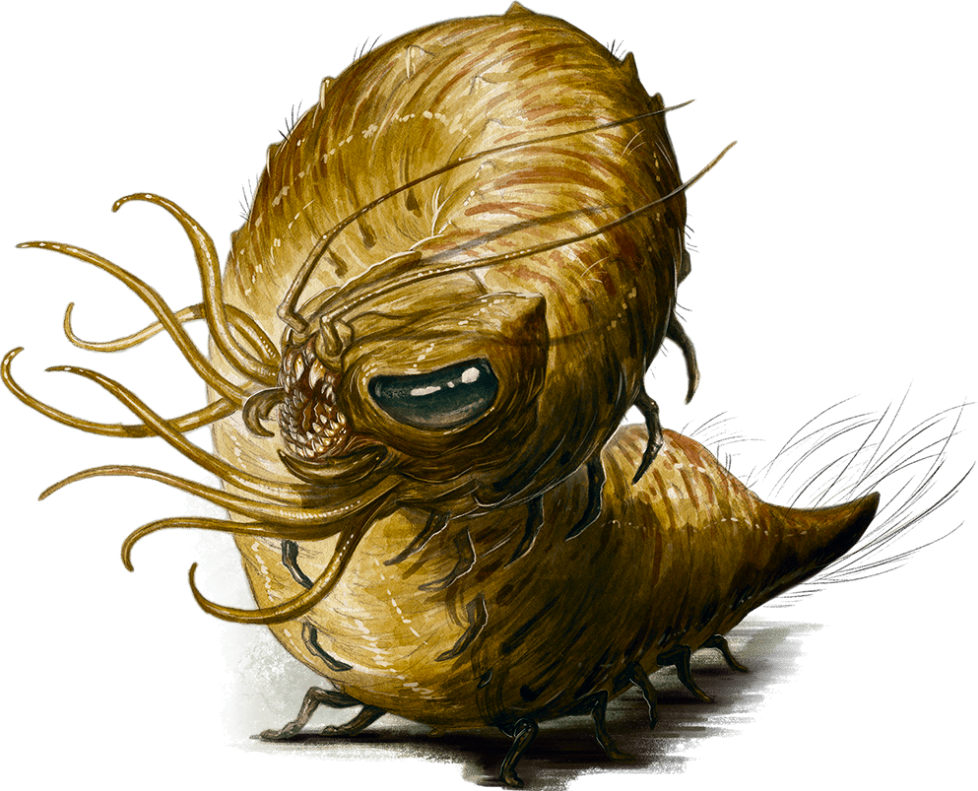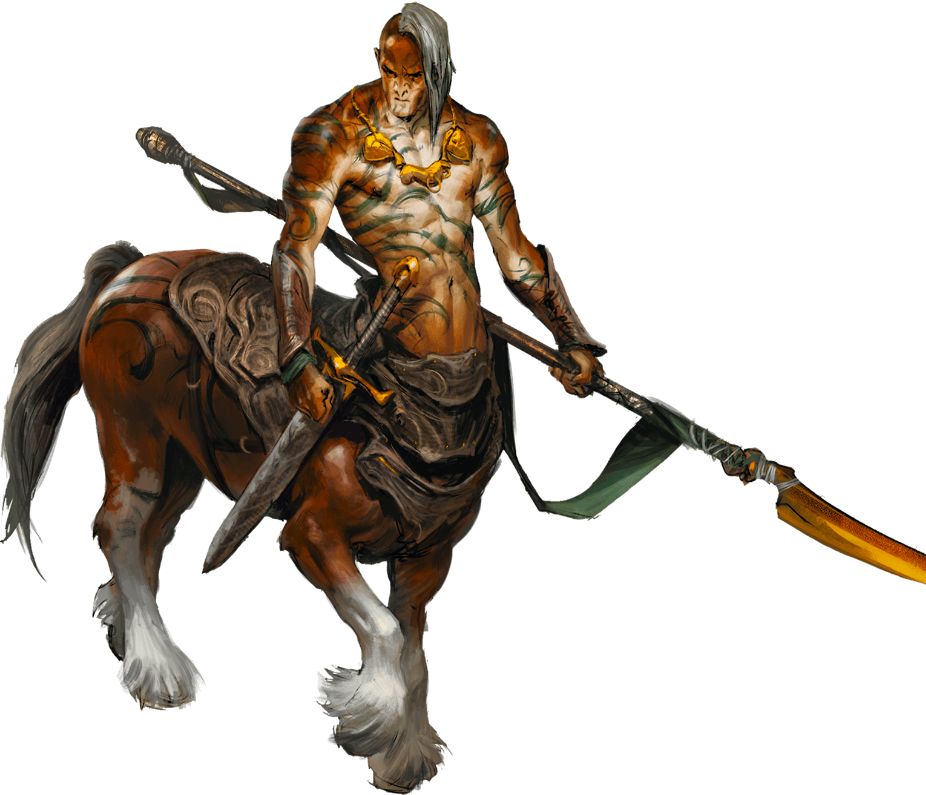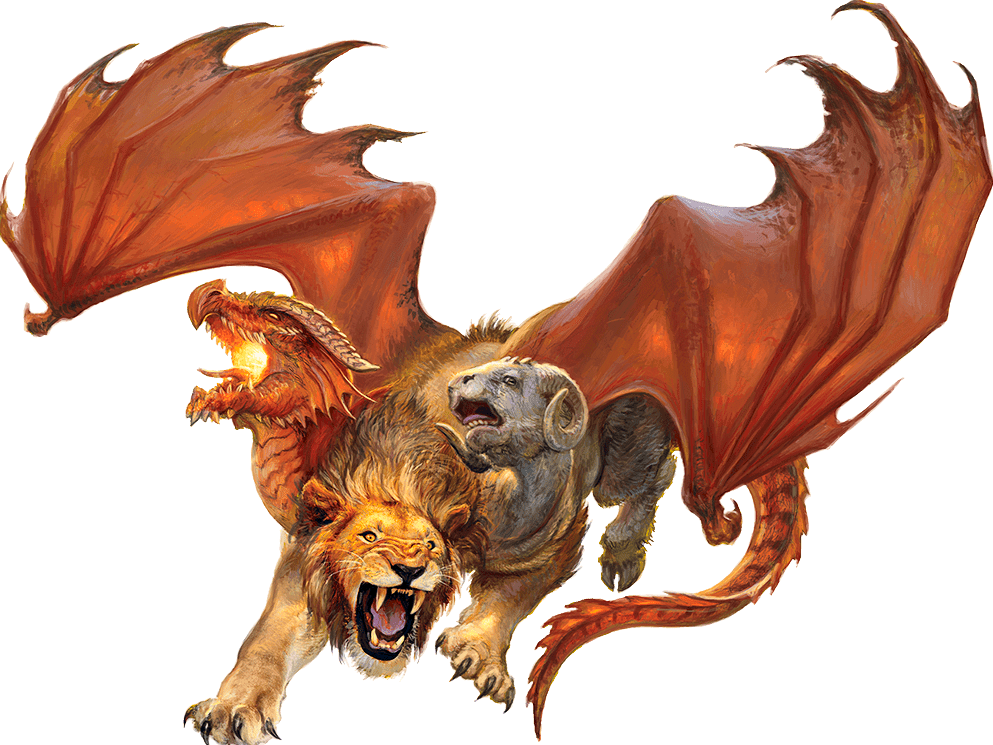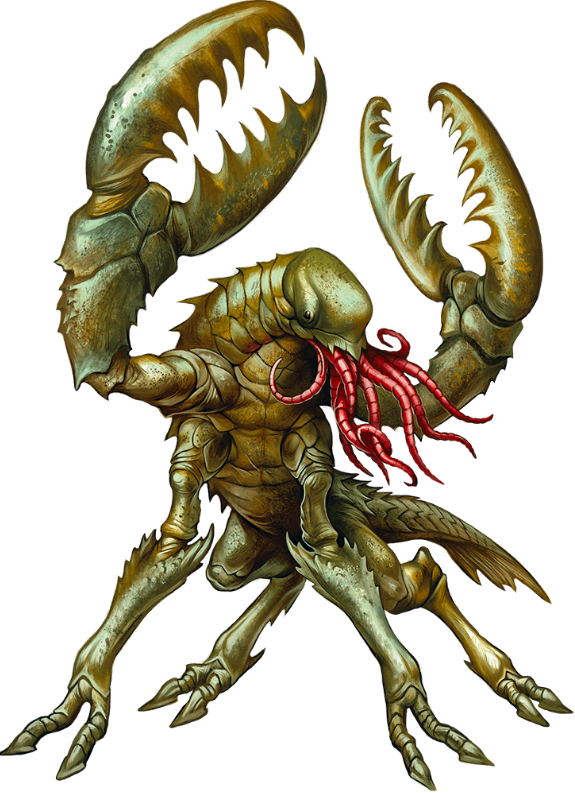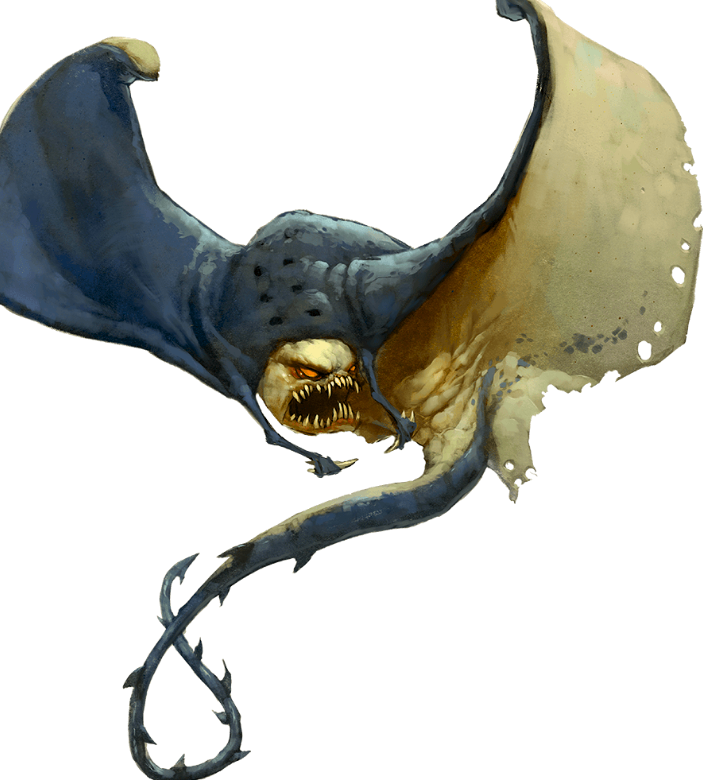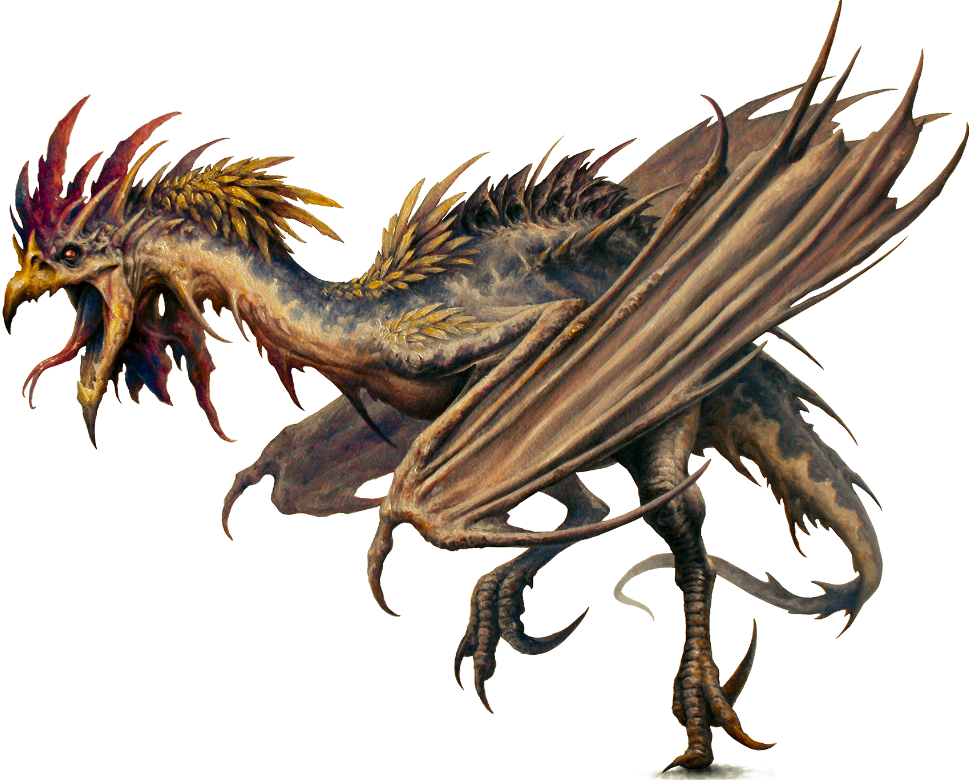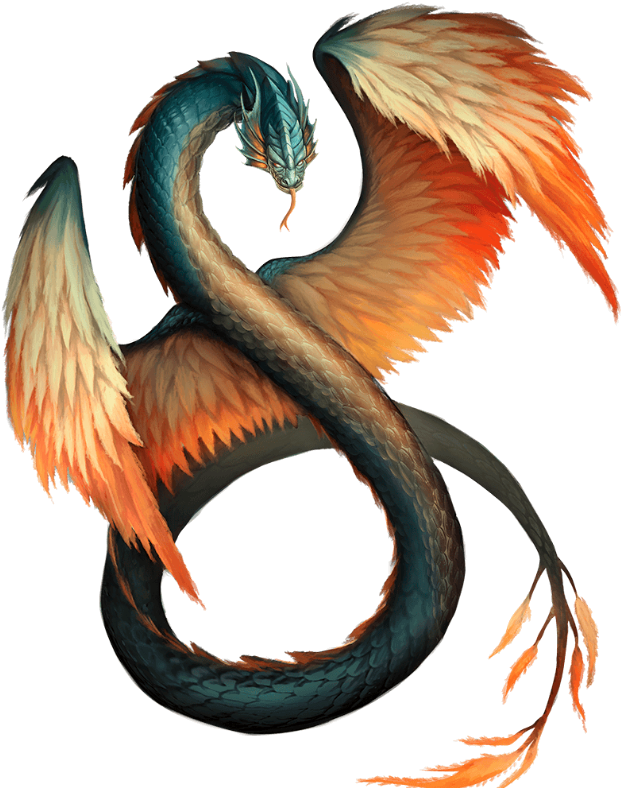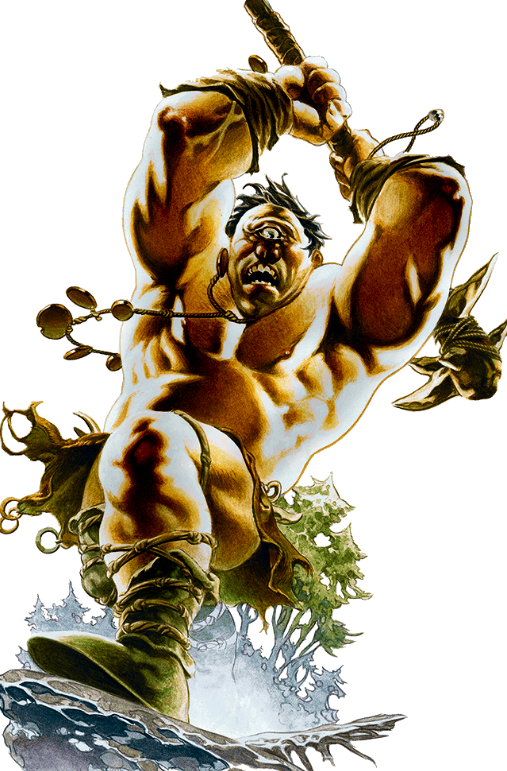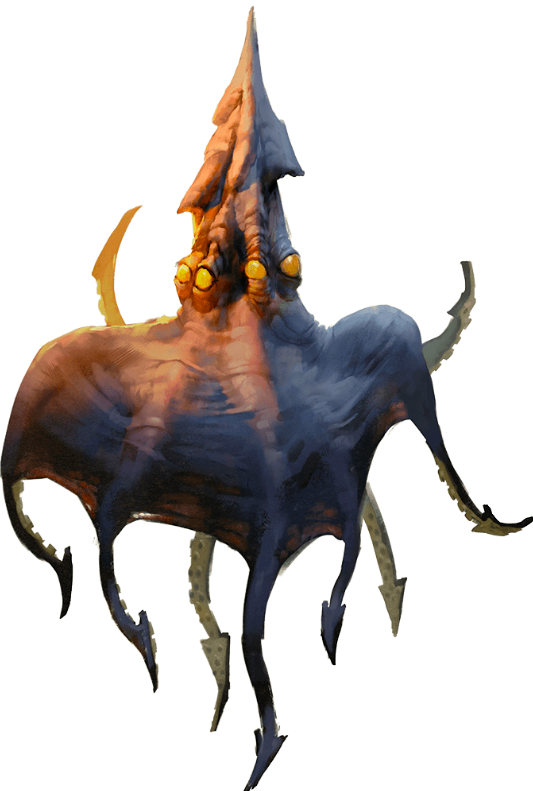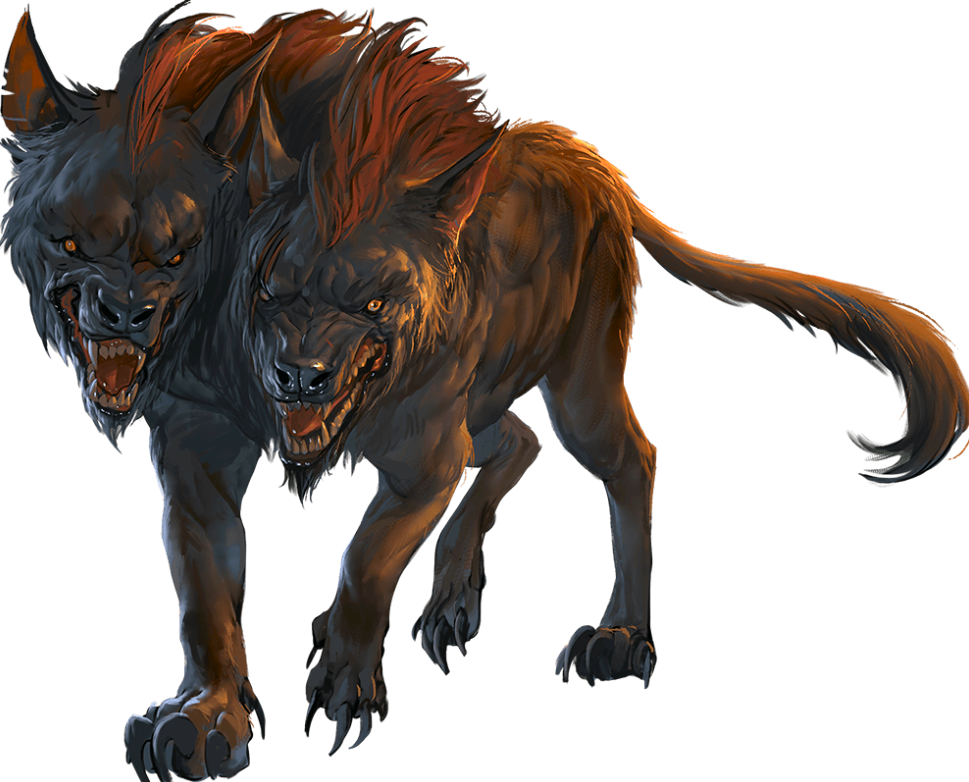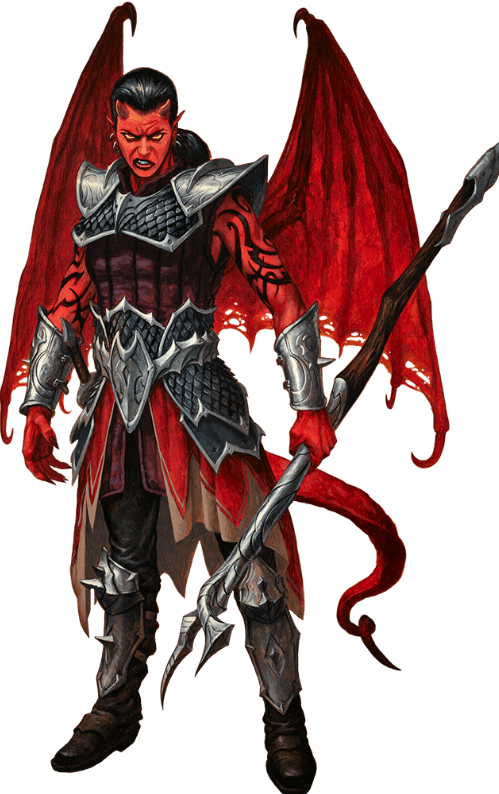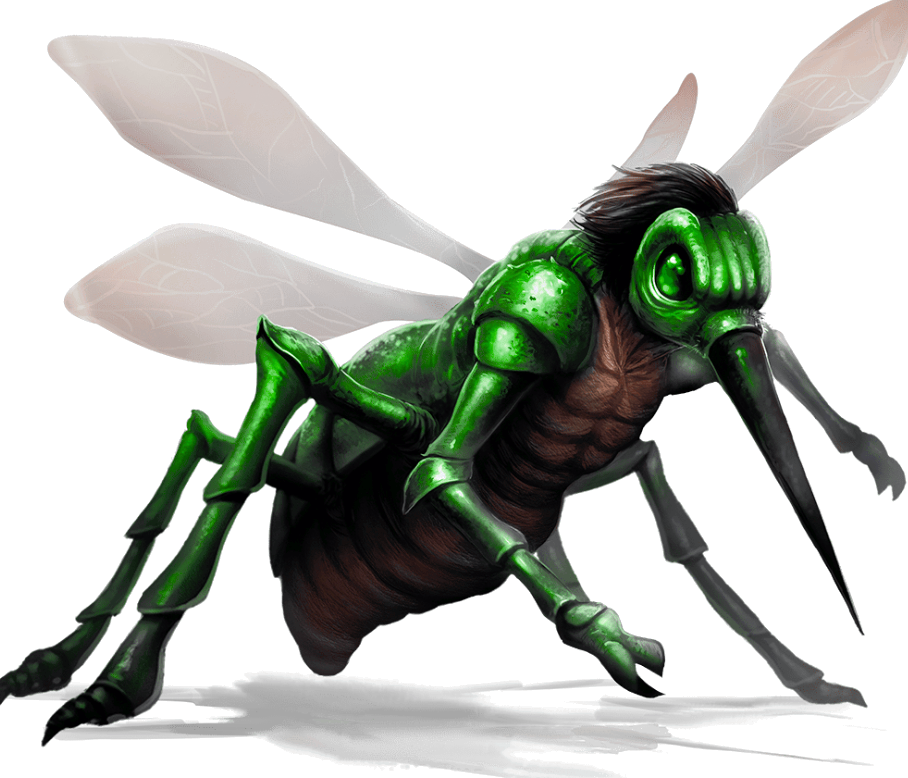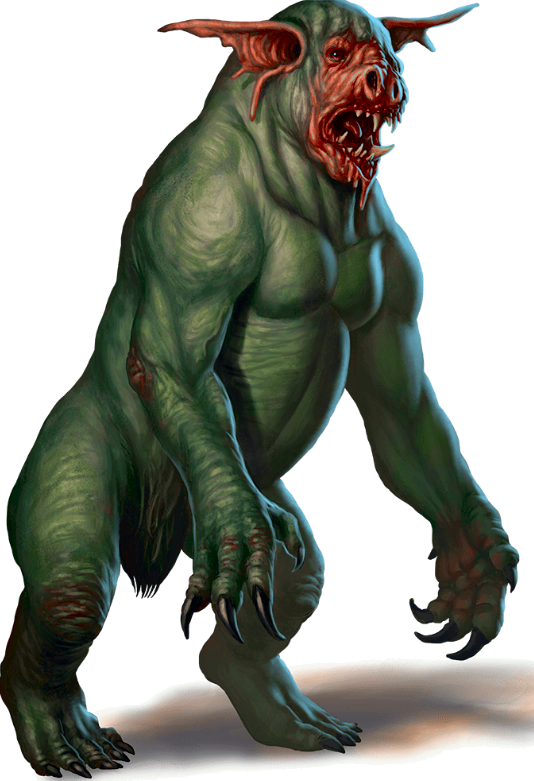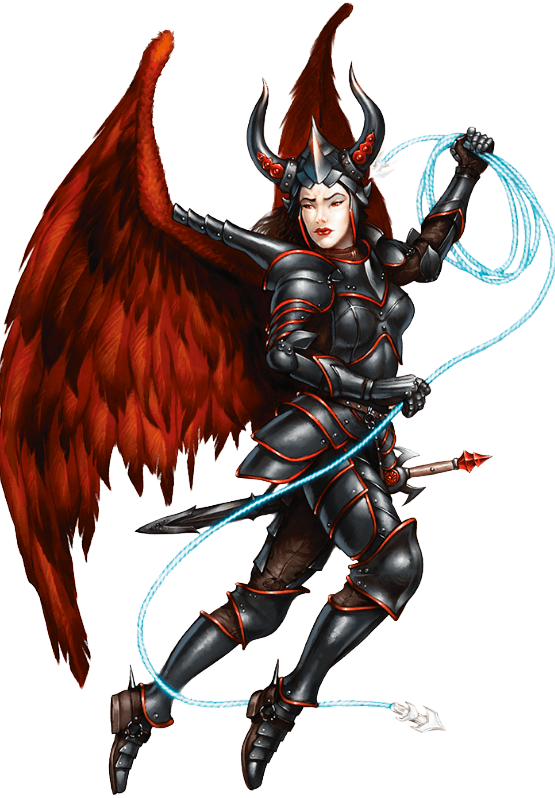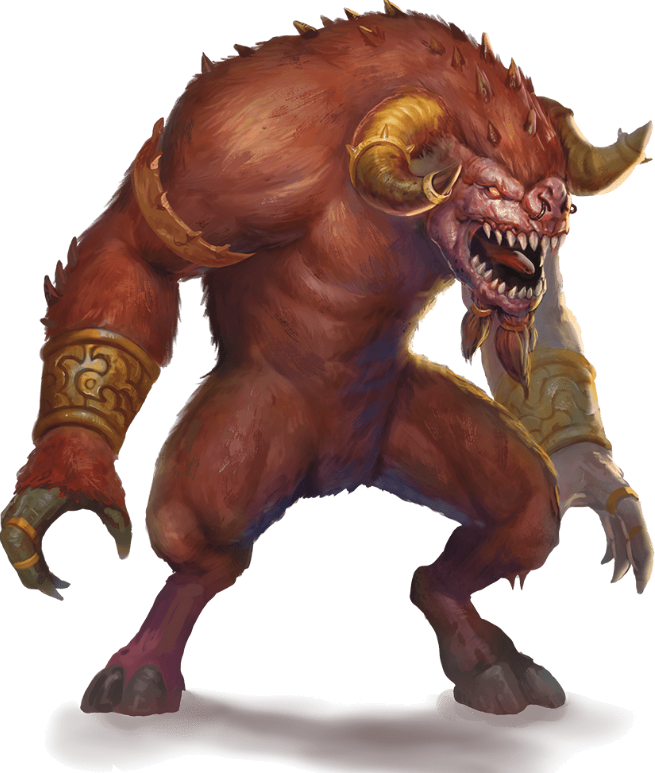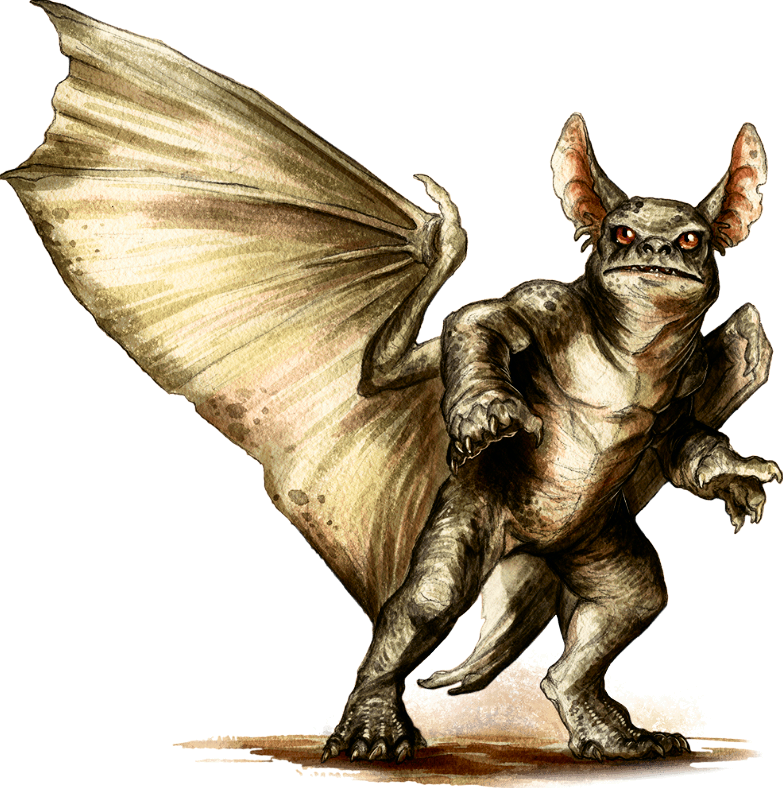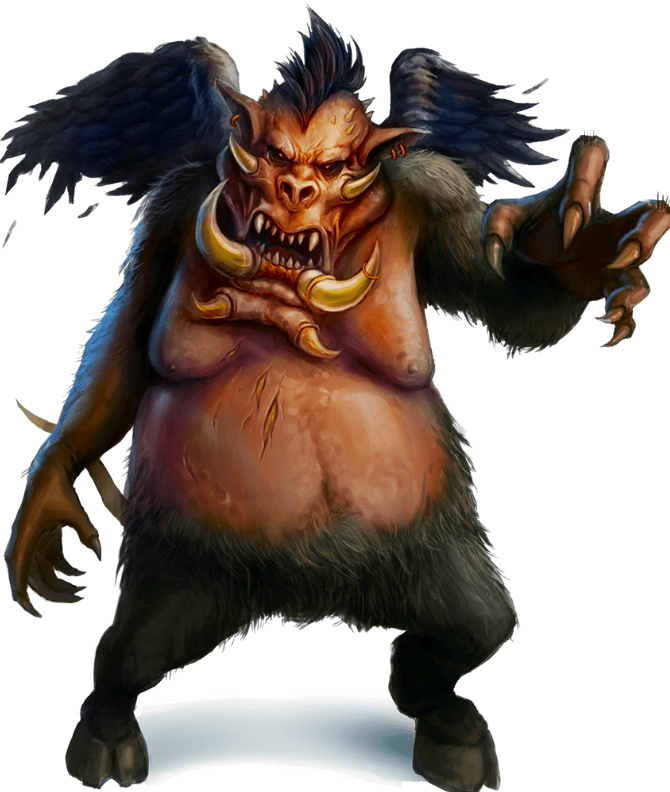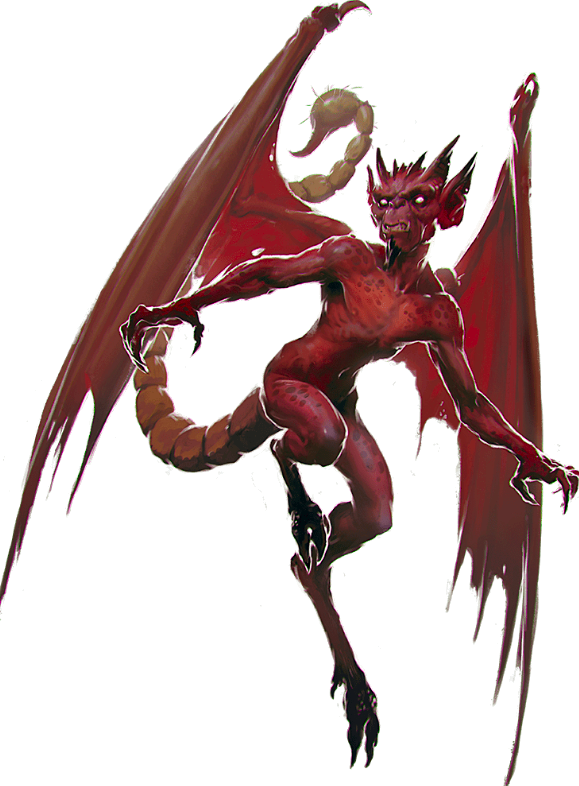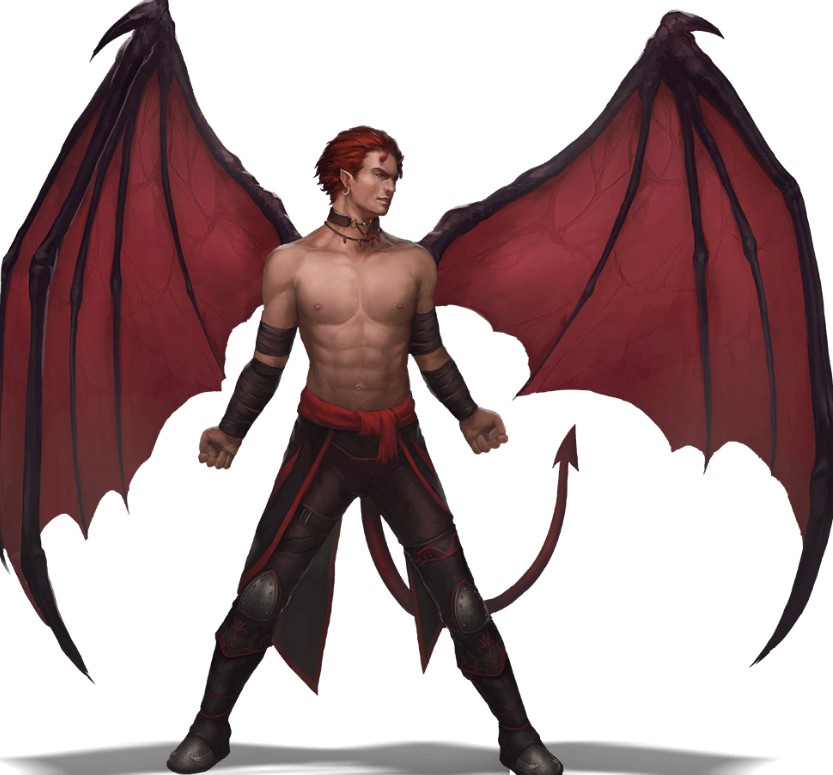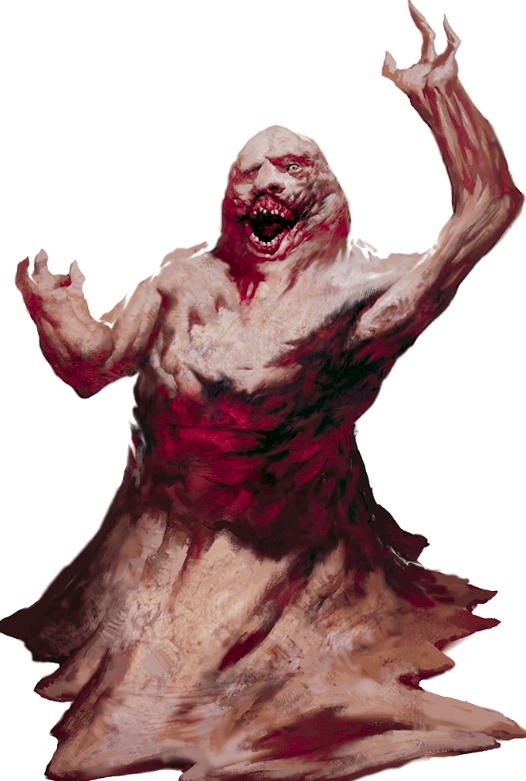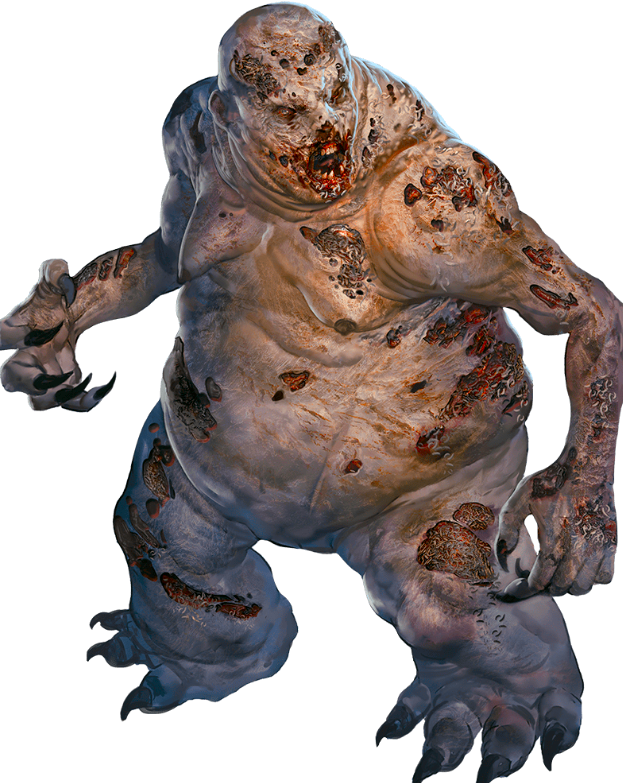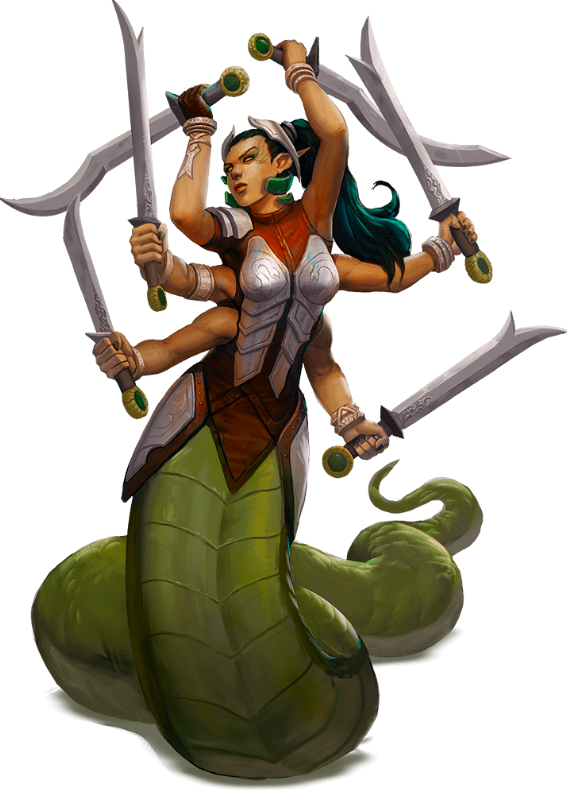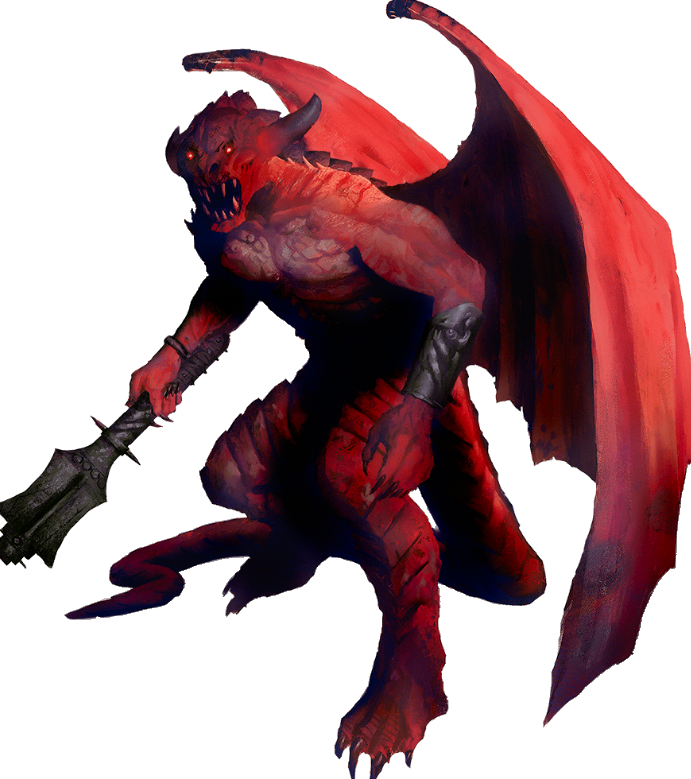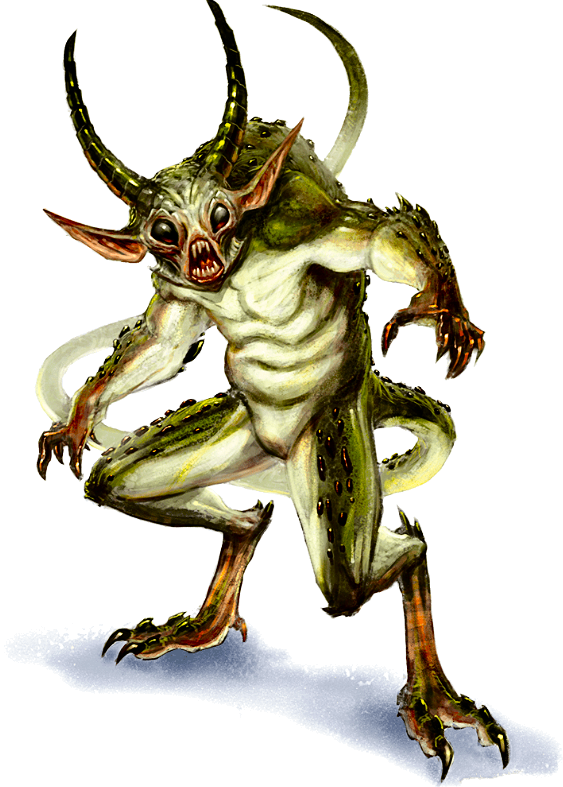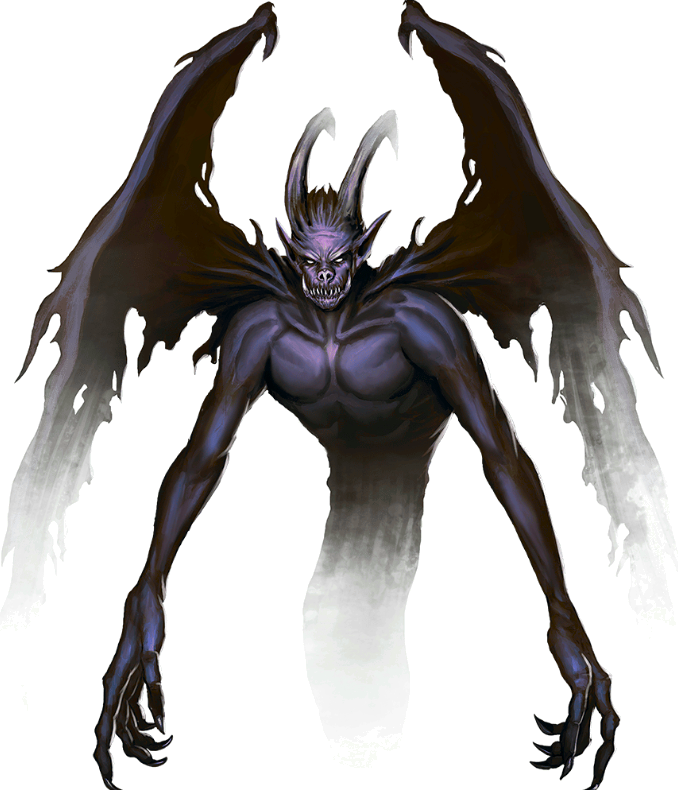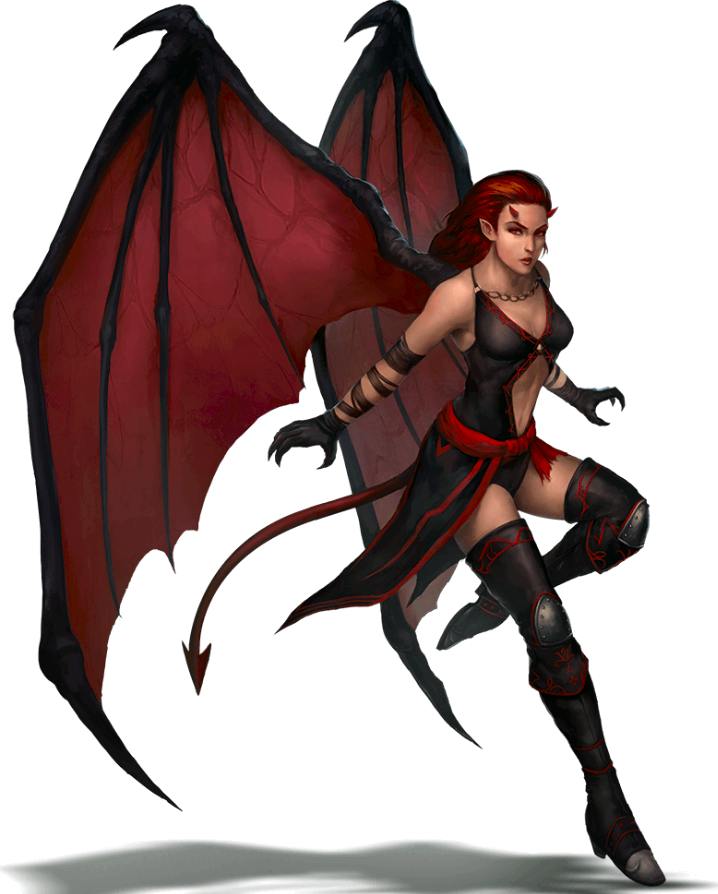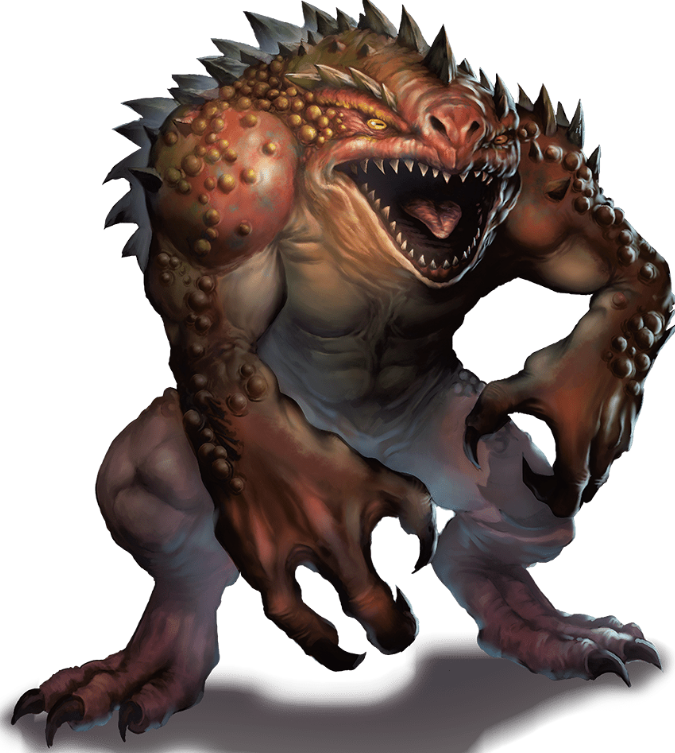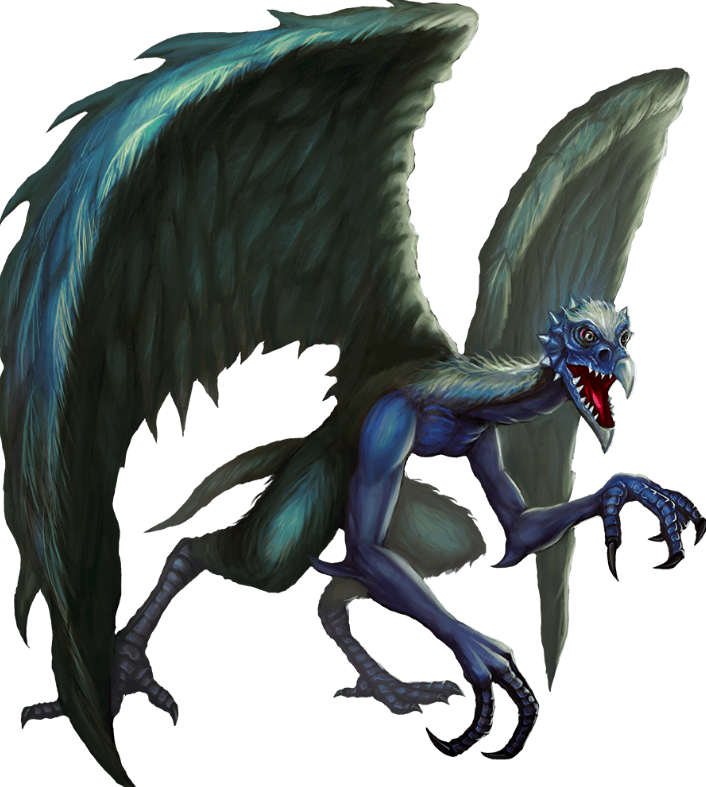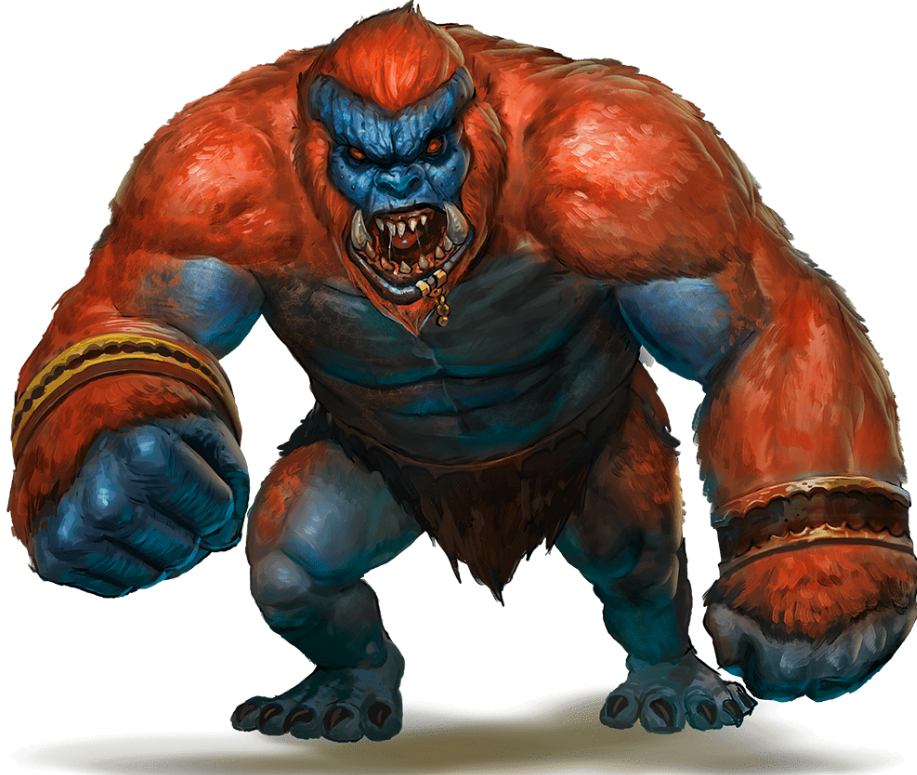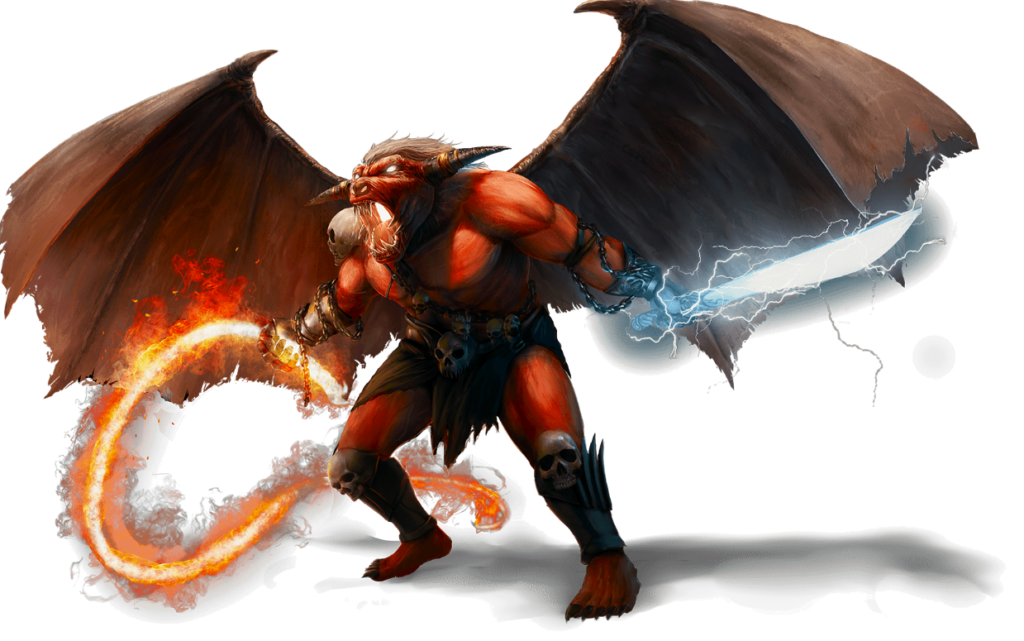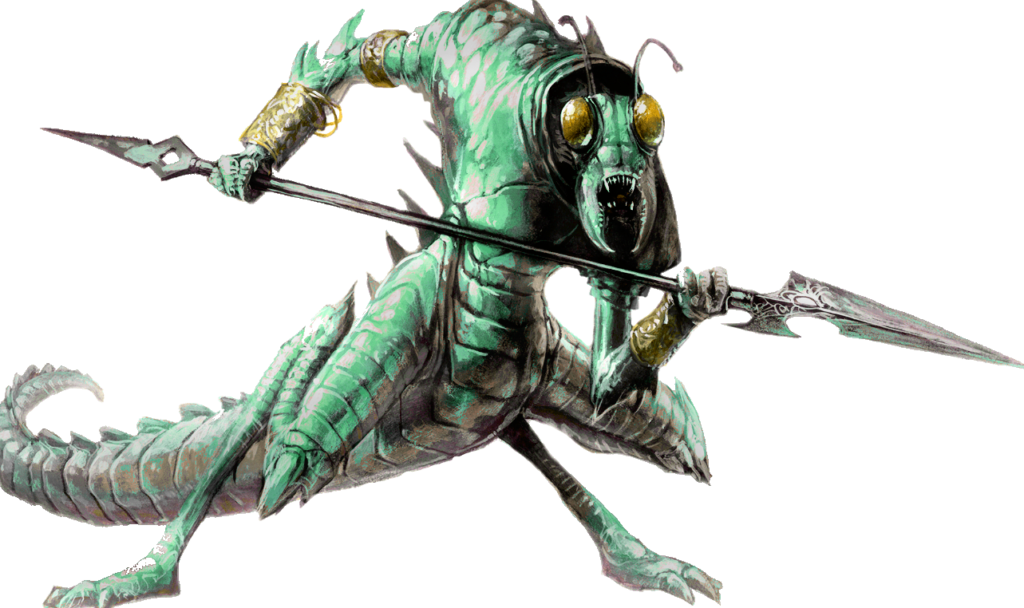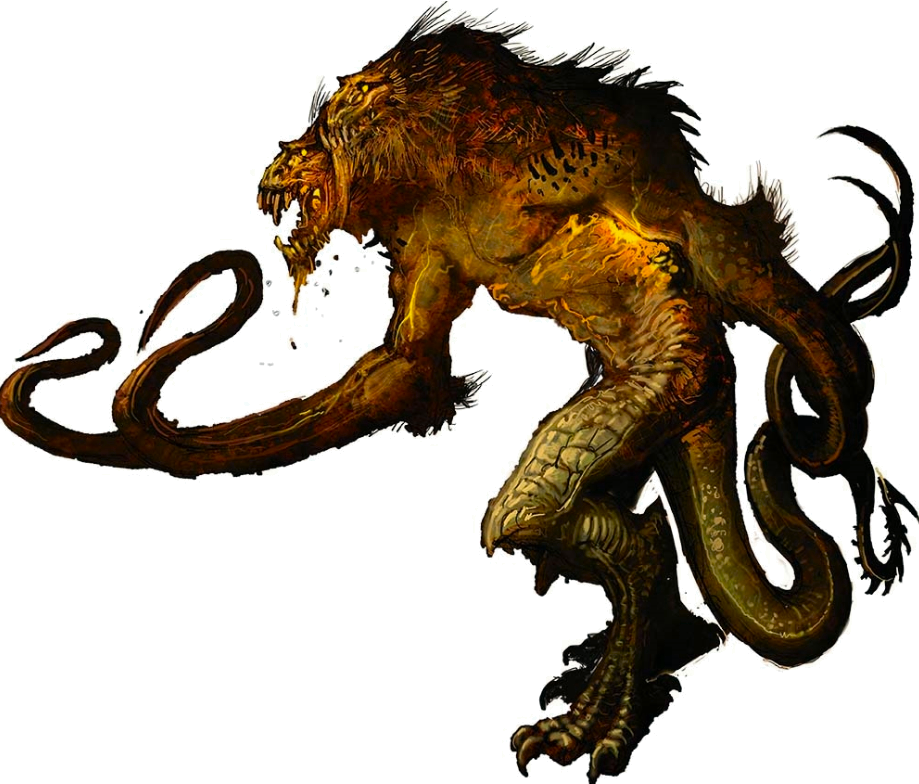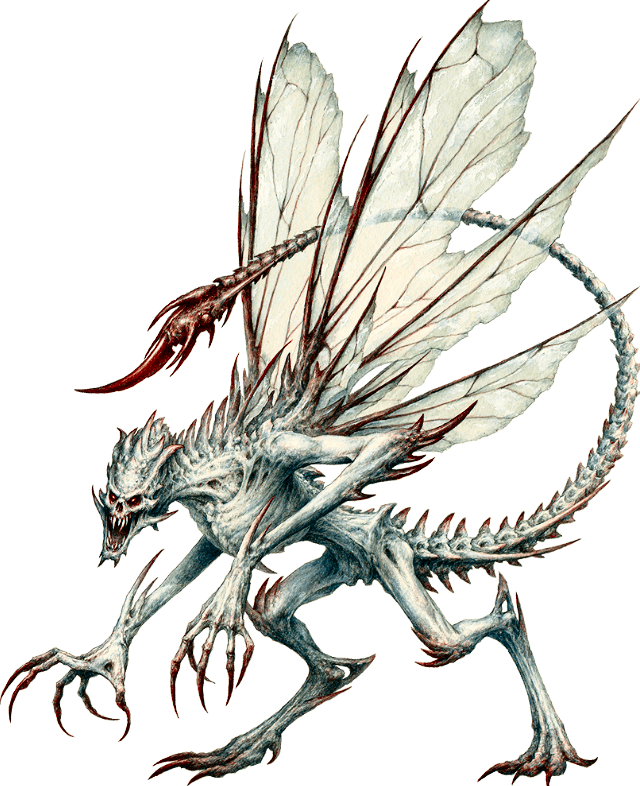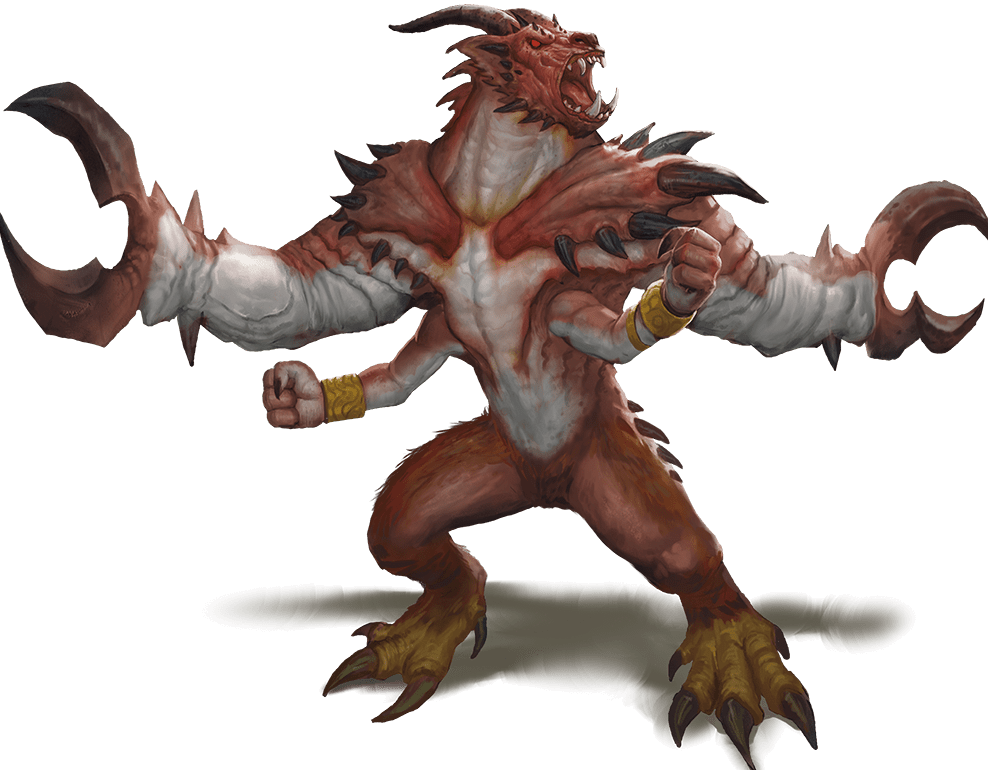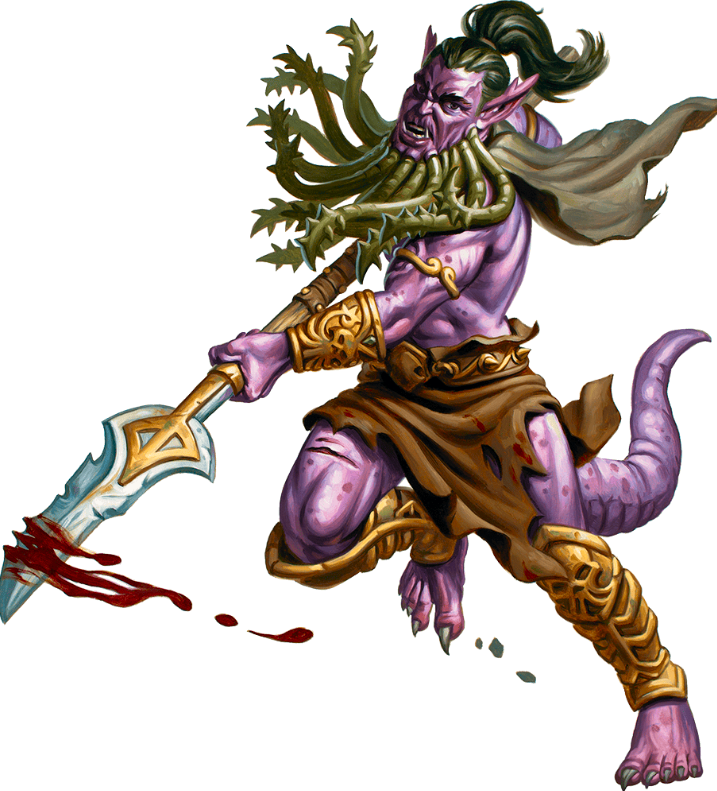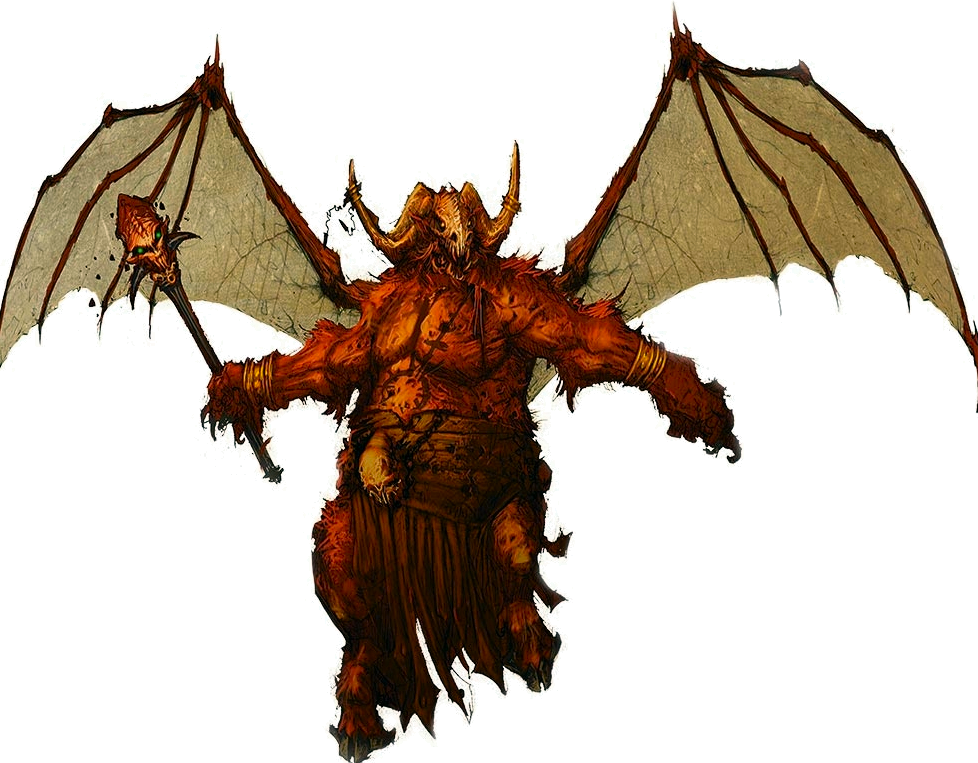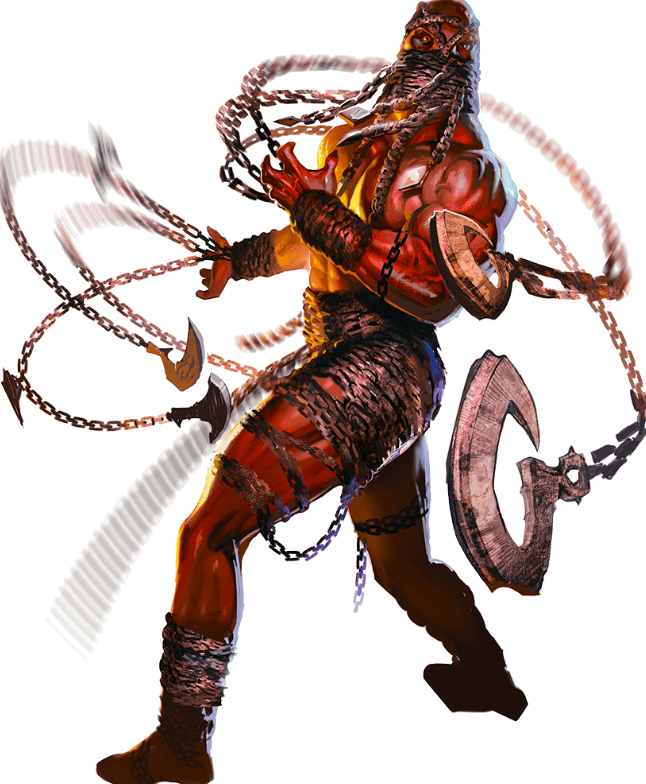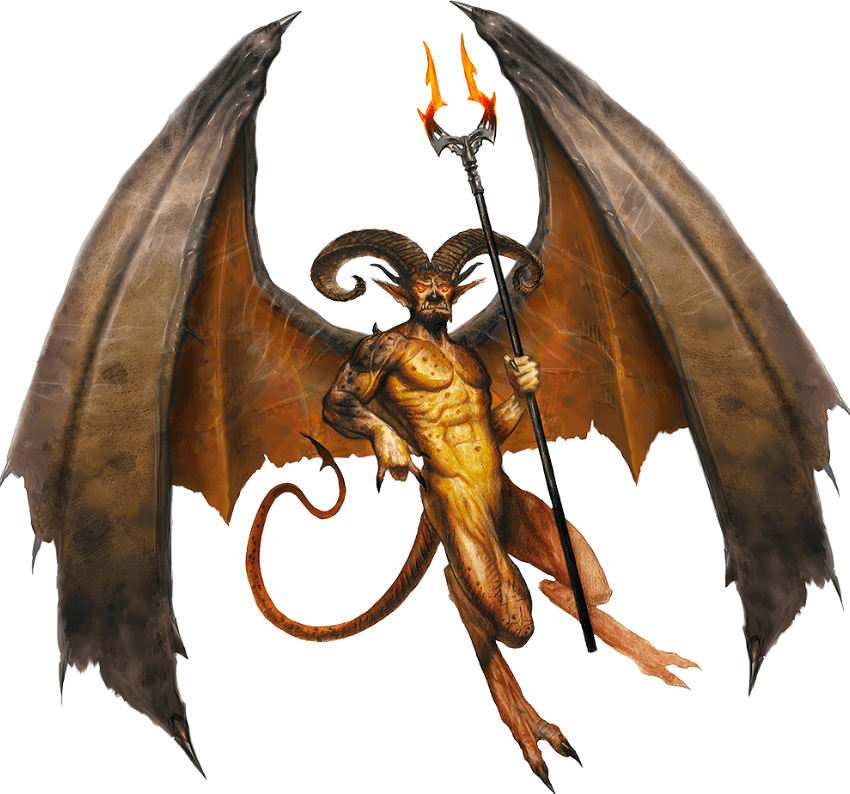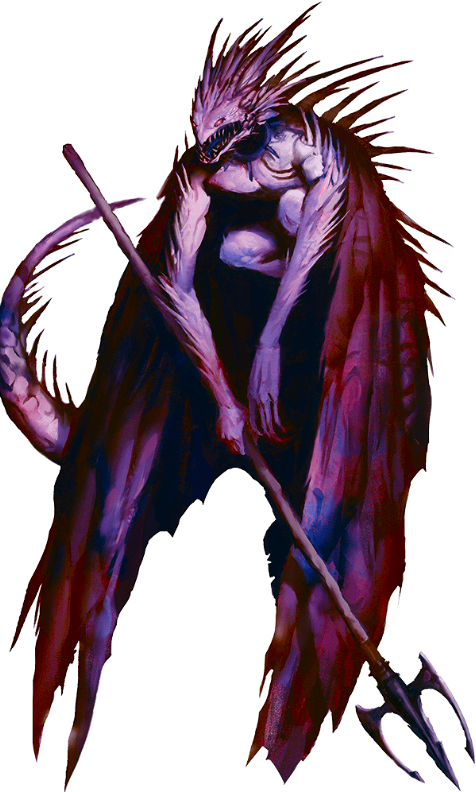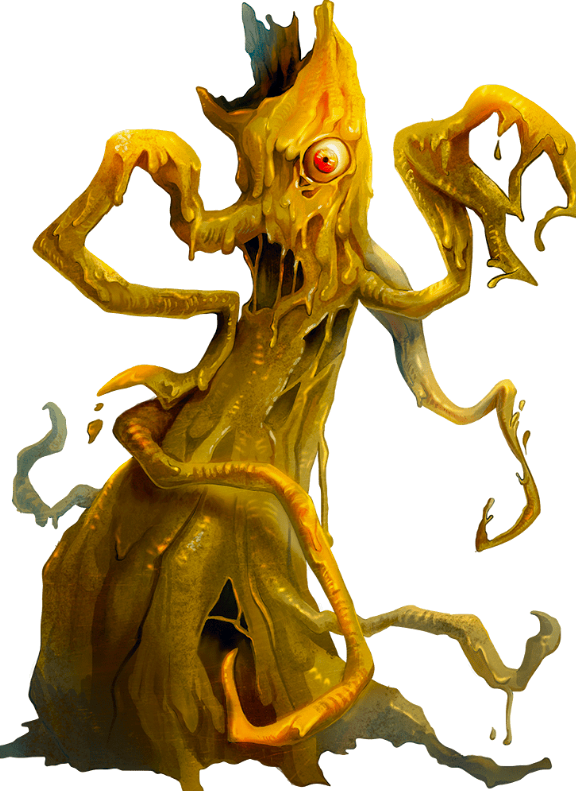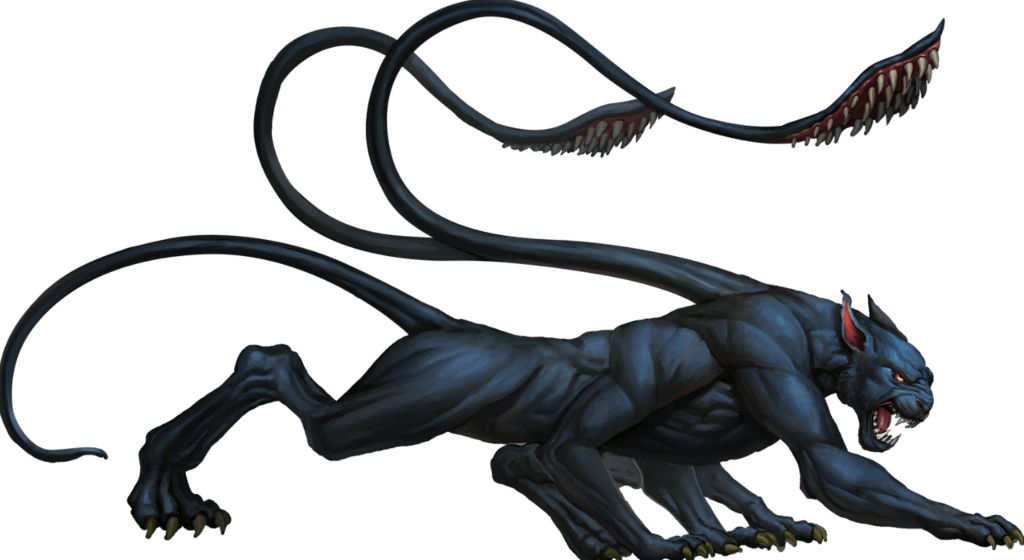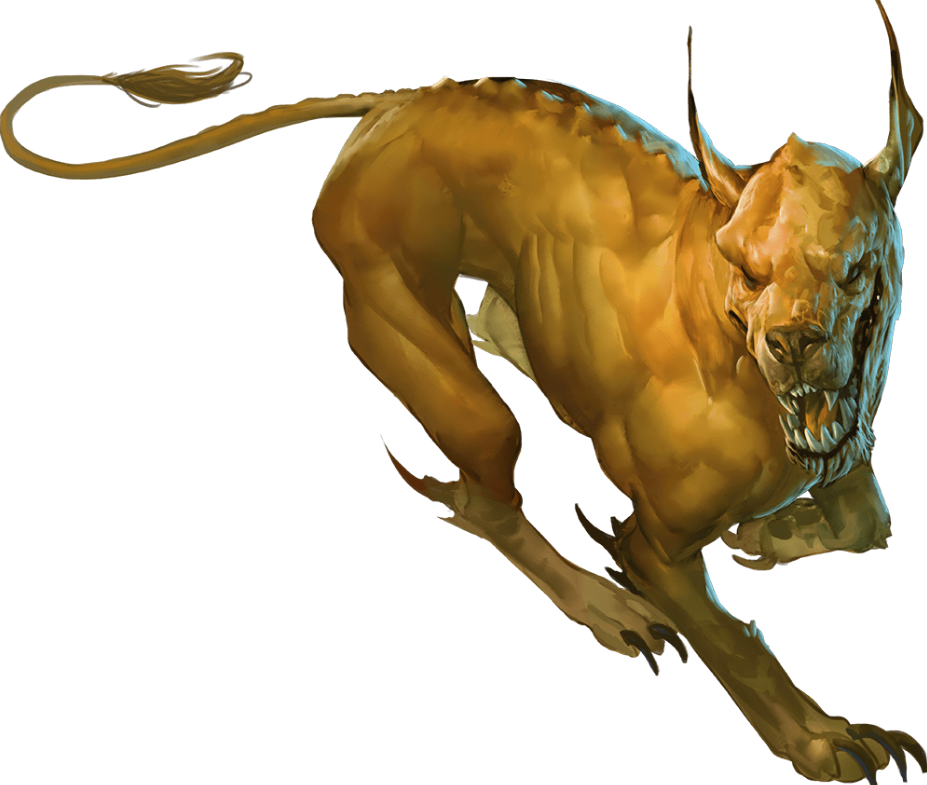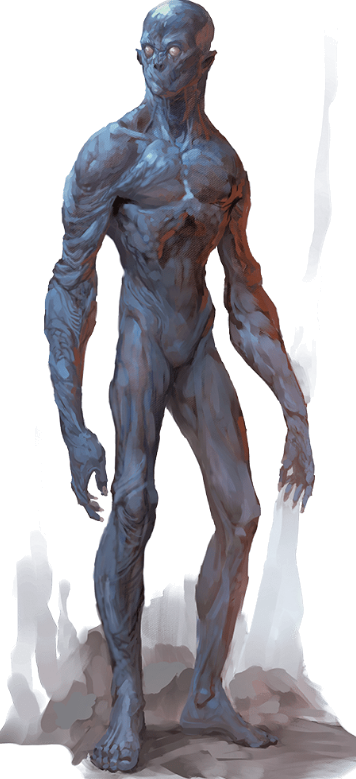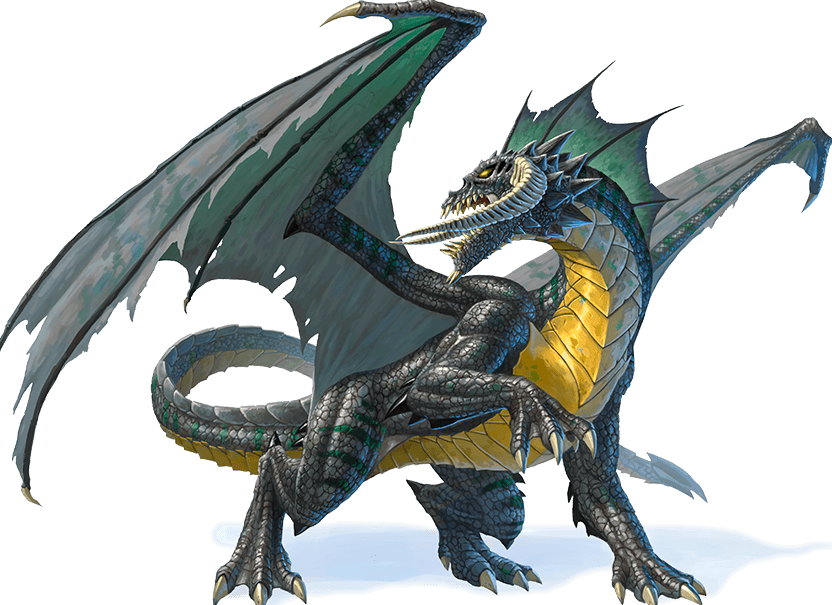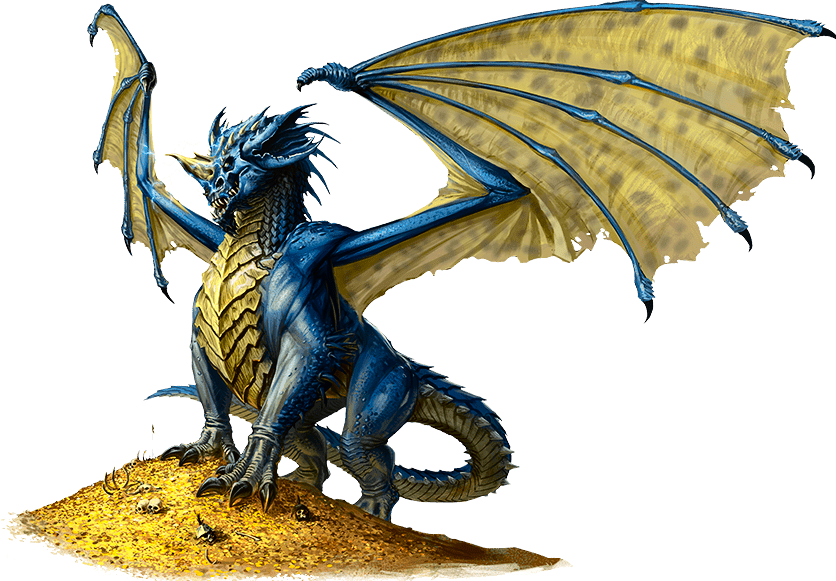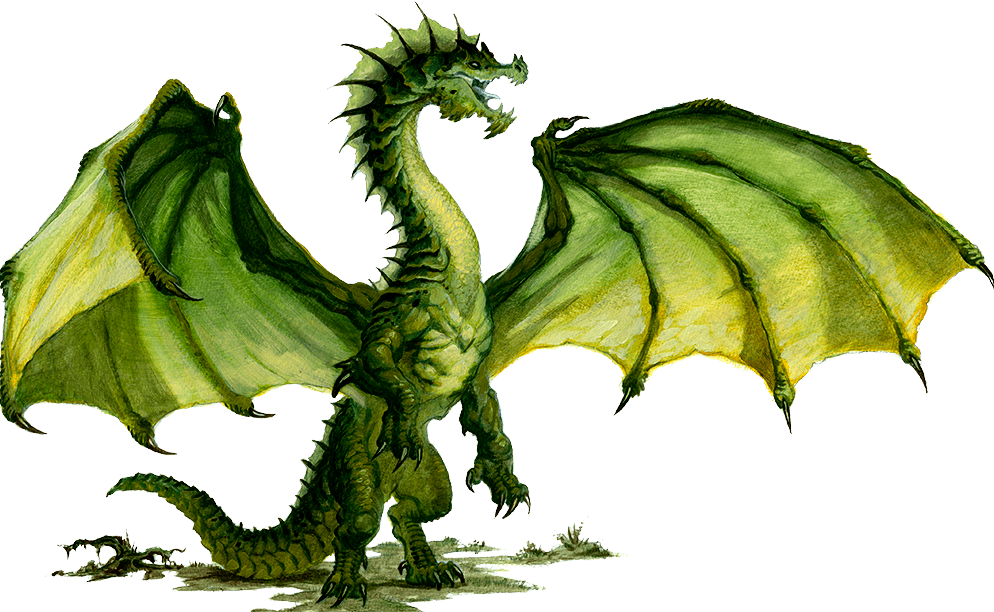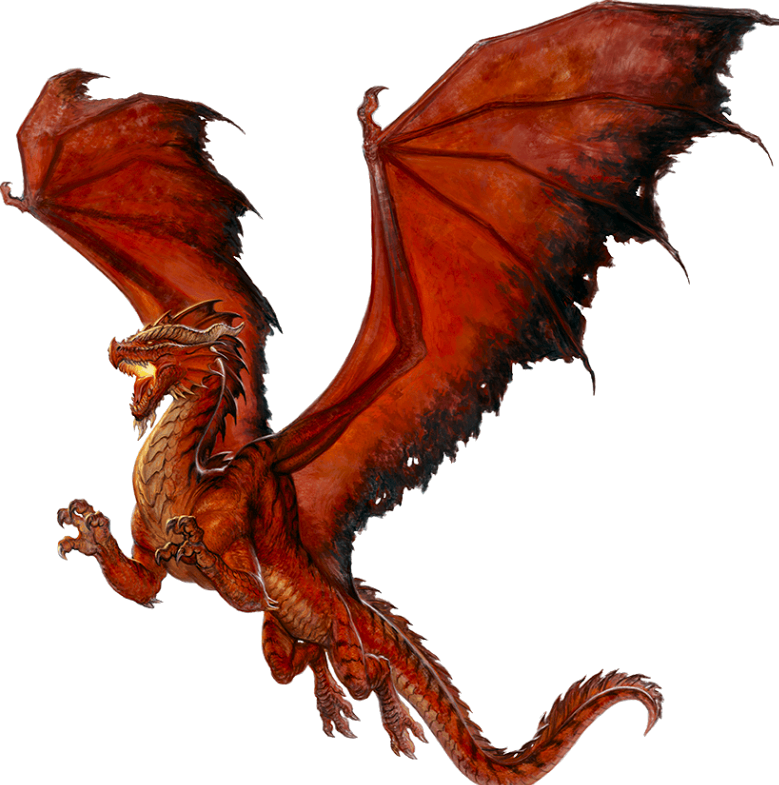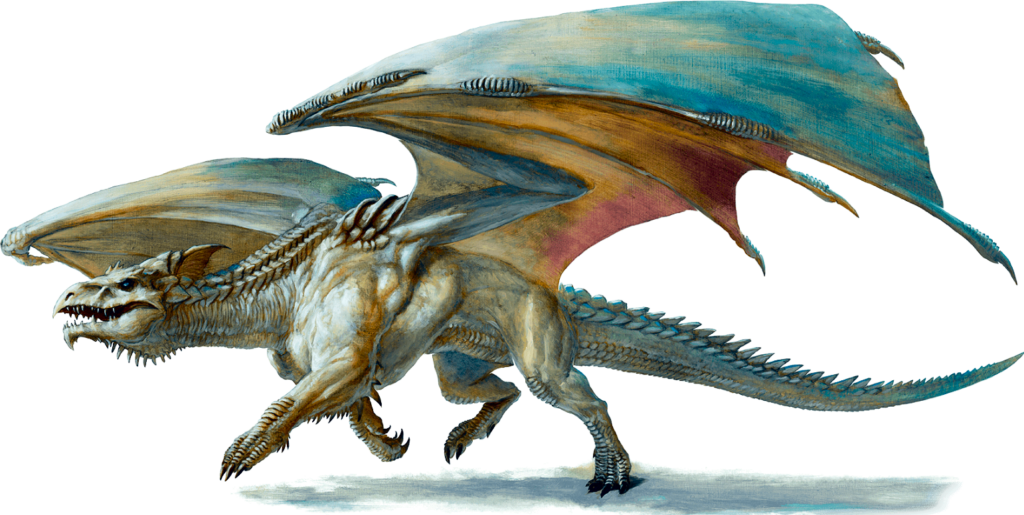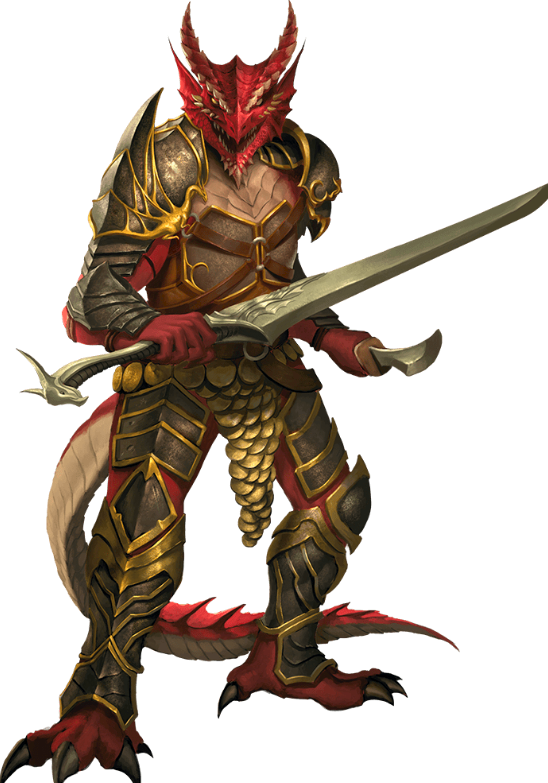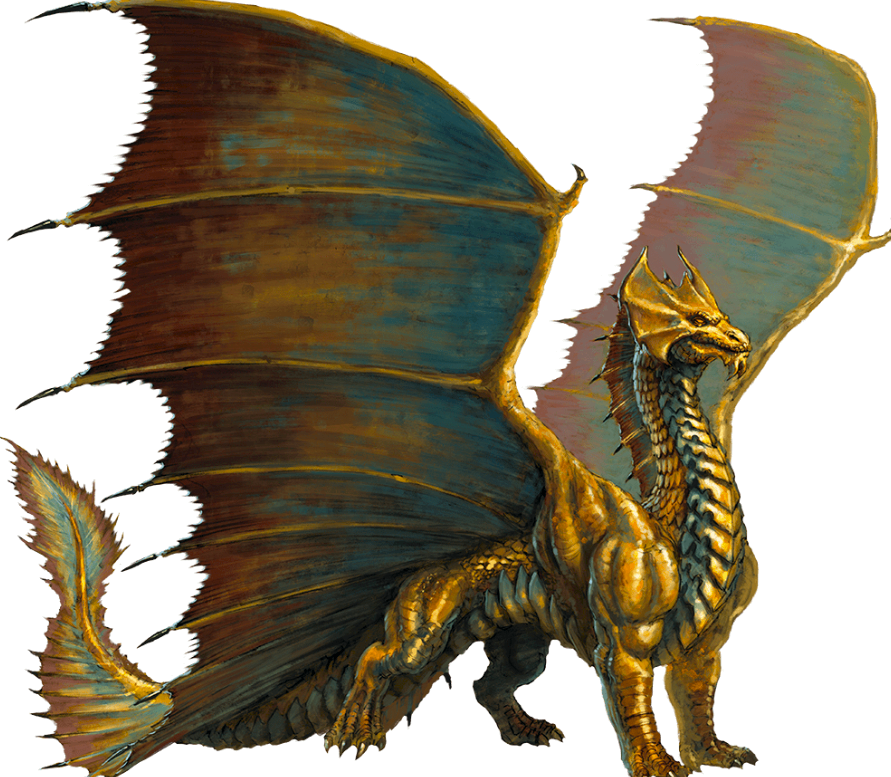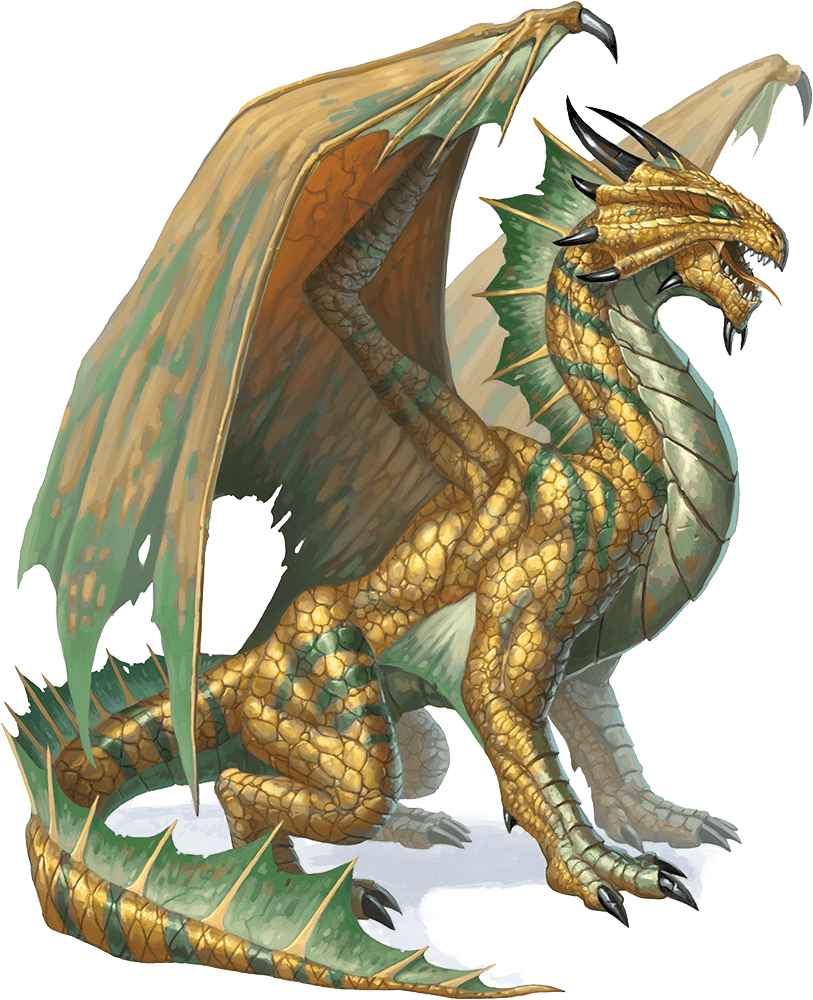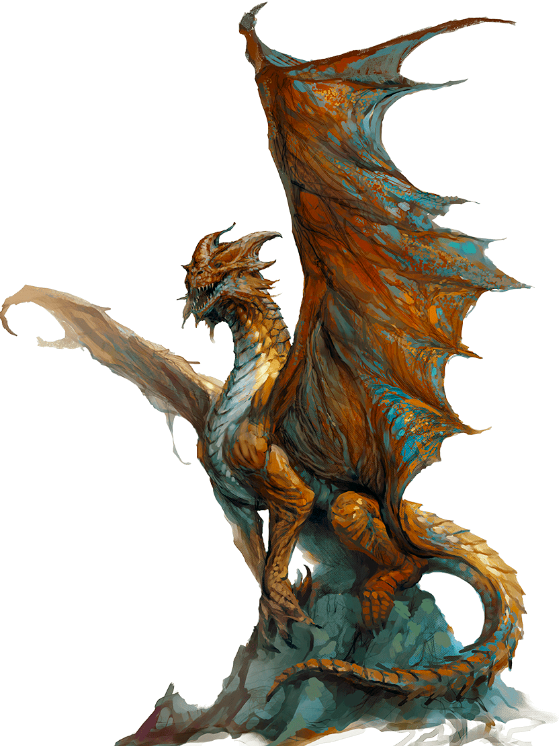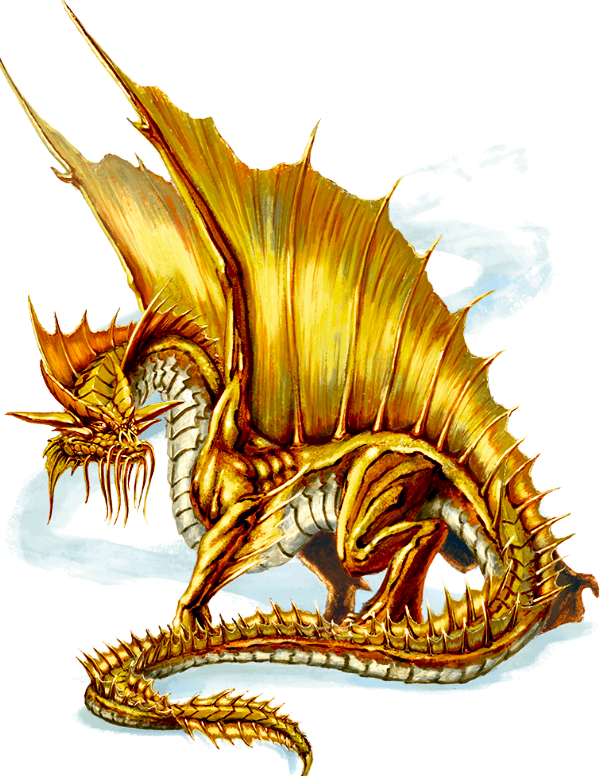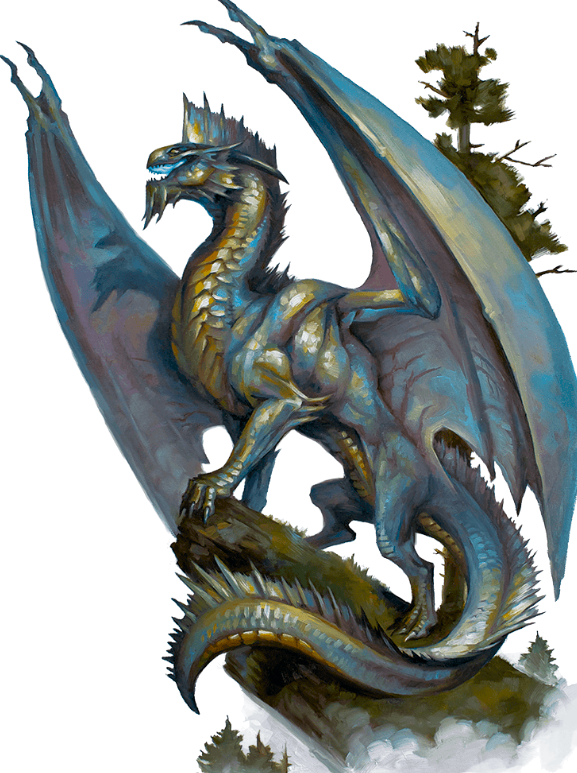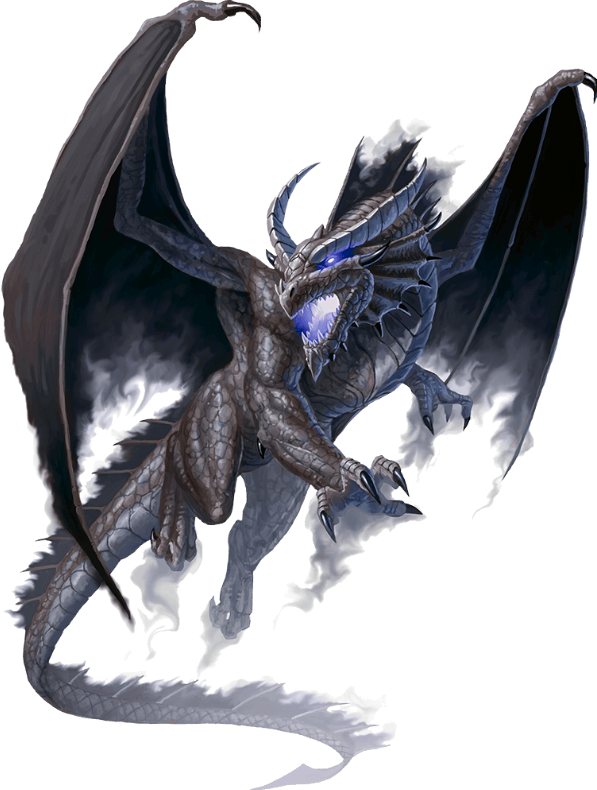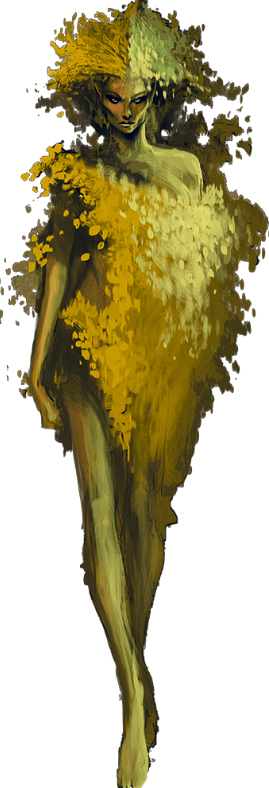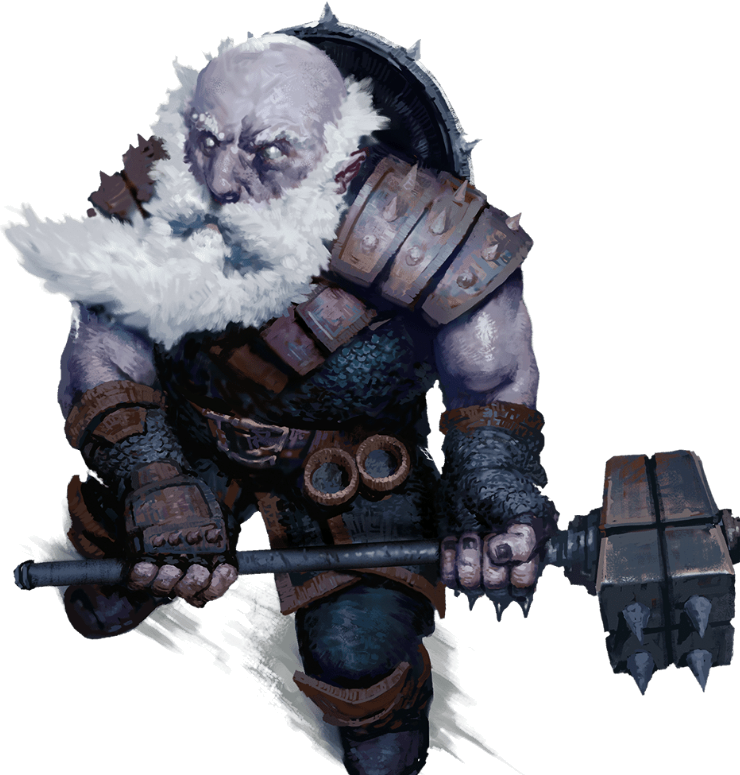Want to help? Consider becoming a Patreon.
There are thousands of creatures that wander the world of Kne’Urth, with new ones being discovered almost daily (usually at the cost of an adventurer’s life). Below are some of the monsters that are known to exist, and some who – right now – are just legends, said to exist.
Aarakocra
According to the legends, the Aarakocra were once at war with the Kenku, who at the time, were still capable of flight. During a massive war between the two on the Plane of Air, a portal had opened up – created by an elf by the name of Porlen Hollowroot, who had done so, seeking help to destroy the orcs on Kne’Urth. The portal opened just beneath the battlefield and Aarakocra and Kenku plummeted from their native Plane onto Kne’Urth – confused, but still at war with one another. All around them, fighting had been going on and these two could not set aside their differences. When the rift was closed – something happened to the Kenku and they lost their ability to fly. The Kenku retreated while the Aarakocra sought a way to return to the Plane of Air. After years of not finding any way to return, the Aarakocra accepted their fate and that they would live here on Kne’Urth. They made their home high in the mountain tops away from civilization. While their hatred of the Kenku has greatly waned over the years (they almost feel sympathy for the flightless bird-kin), they Aarakocra have developed a hatred for the perytons of Kne’Urth who will feed on their kind, devouring their hearts. The Aarakocra will kill – or attempt to kill – any perytons they encounter. The Aarakocra shamans who worshipped Krauzden who felt his death – now ponder what their own fate is – and believe the end of the world rapidly approaches. The Aarakocra speak their own language, but have learned how to speak a broken version of common, having (much to their dismay), encountered several travelers crossing the mountains they now call home.
Aboleth
The true origin of the Aboleth is shrouded in darkness. There is one version that says the Aboleth’s swam in the dark seas, prior to the arrival of the gods, when dinosaurs roamed the world, and scant few primitive human mortals walked the land; then when the gods came, the Aboleth’s existence was made aware by “awakened” mortals and the new people the gods forged in the world who were wiser and knew how to hunt the Aboleth. Another version speaks of how the elf, Porlen Hollowroot, in an attempt to seek help to defeat the orcs, opened a portal to the Plane of Water, and oceans poured out from the rift into the world, and with it, such creatures like the Aboleth spilled into this new world, unsure of where they were and adapted and thrived. There is even a third story, that speaks of the Illithid having performed some kind of experiment on an aquatic creature, which is why the Aboleth has telepathic abilities. Whatever the truth is behind these massive creatures; they’re a horror to behold and terrifying to encounter. They are able to go on land for short periods of time, and anyone near a beach or body of water, should be wary of the potential of an Aboleth appearing.
Angel, Deva
Like all Angels, the Deva angel was created from the flaming sparks on the Forge of Life as Jarisfargen struck hammer to anvil. Among the Angels, the Deva is an angel, often sent by the gods, to pass messages to the faithful (clerics/priests) of the world. They often are there to provide wisdom for those who seek guidance from the gods. The Deva angel will not directly interfere in any way in the lives of mortals (not even providing aid if a Church is burning), for they believe that fate is one of the most important things – and anything they do to directly interfere with that – may cause unpredictable ripples in the fate of mortals. There are some Deva angels, however, who become so attached to the mortals that they’ve interacted with, that they give up their angelic bodies and become mortals. Such engagements often give birth to Aasamir, whose bloodline still has the magical energies that the Deva angel possessed.
Angel, Planetar
Like all Angels, the Planetar angel was created from the flaming sparks on the Forge of Life as Jarisfargen struck hammer to anvil. These angels are often the harbingers of ill omen. While not evil, by any means, they often appear to the faithful, as an indication that ill fortune of great magnitude is coming their way – whether this is a drought or an incredible storm that will bring devastating floods; the Plaentar angel, despite the ill omen it represents, is a welcomed sight to the faithful, as this allows them to try and prepare for whatever might come. Clerics and Priests claim to bare witness of a Planetar angel, lingering in the sky, where disaster strikes, gathering the souls lost in such disasters to ascend. There are some Planetar angels, however, who become so attached to the mortals that they’ve interacted with, that they give up their angelic bodies and become mortals. Such engagements often give birth to Aasamir, whose bloodline still has the magical energies that the angel possessed.
Angel, Solar
Like all Angels, the Solar angel was created from the flaming sparks on the Forge of Life as Jarisfargen struck hammer to anvil. The Solar Angel is the weapon of the deities; they are often called “Battle Angels.” These angels are said, among the faithful, to be beings of sure pure light, goodness and beauty, that they’re virtually impossible to look at directly, when given a vision from them. Solar Angels have been said to appear on large battlefields to clerics and paladins, as an inspiration to them – encouraging them to charge, surging their bodies with magic, and even healing their wounds. Tragically, one of the most well known of these angels was one by the name of Verastin, who during a massive war – had become consumed by the battle and lost his way – becoming the first known “fallen angel.” According to legend, Nifika imprisoned him by shooting an arrow (or throwing a spear, the legend varies here) – and piercing him through the heart and pinning him to the ground. The arrow/spear then grew into a tree and encased him for what should have been all eternity. However, a dark cult, drawn by his power discovered a way to set him free – it merely took luring the dryad assigned to guard him (Danela) – and sacrificing her, which they had successfully done, releasing Verastin into the world. Verastin then took the unicorn assigned to the woods – broke it’s horn and pierced it’s heart – turning the creature into a foul beast known as a Nightmare. There are some Solar angels, however, who become so attached to the mortals that they’ve interacted with, that they give up their angelic bodies and become mortals. Such engagements often give birth to Aasamir, whose bloodline still has the magical energies that the angel possessed.
Animated Armor
Animated armors greatly vary in appearance, depending on the armor in which the spell is cast upon. More often than not, rich families will employ a wizard to enchant several armors that stand among other suits of armor around a large home as “decoration” making the actual animated armor almost impossible to spot from the other decoration suits of armor (without the use of magic) – and more often than not, the “trigger” for these animated armors is either a specific word or phrase, or magic being used in the vicinity of the animated armor. Depending on the wizard who enchanted the armor, the Animated Armor may come with additional defenses and abilities granted by the wizard (usually at a pretty steep cost to the one requesting the armor). The animated armor is often used by powerful wizards as well in the same manner, guarding their homes or wizard towers. The sight of an animated armor can be quite unnerving as it simply looks like a haunted suit of armor.
Animated Sword (Weapon)
Similar to the animated armor, the animated sword isn’t always a sword – it can be any weapon – however, swords tend to be the preference as they can cut and pierce any enemy that they’re ordered to attack. Swords are also the most commonly weapon used as decoration, allowing an animated sword to be hidden among other items. Sometimes, an animated sword may even be disguised in the hands of a suit of armor – or even, an animated armor – where it will then attack on its own. The most dangerous aspect – and why it frequently leaves the hands of an animated armor if it is hidden as such – is the incredible distance the animated sword – more often called a flying sword – can cover. Each time it’s able to move 50′ – making outrunning the animated sword virtually impossible for most people.
Animated Rug (Rug of Smothering)
Another trick of magic is the animated rug (sometimes called the rug of smothering). Rest assured, this rug need not always be a rug. While the most common form is a rug – used as another means of capturing (and potentially killing) would be thieves who might sneak into someone’s home or tower – and without notice step on the rug which then triggers! Animated rugs can be anything from extremely fancy rugs, to tattered rugs; depending on the needs of who has requested this item to be enchanted. As previously stated however, these are not always rugs – they can be curtains, for example – so someone who sneaks in a window, or even looks out of the window and touches the curtains – triggers the curtains to animate. Another deadly aspect – it can also be the form of bed covers. A lover, seeking to trap someone, or end the life of their current lover, may request their bedcover to become animated, and in doing so whomever lays on the bed activates the covers to begin smothering them. It is not an uncommon practice, if someone has hurt any of the followers of Prenah – the perpetrator is lured by a beautiful follower – and asked to lay on the bed – and perish for their crimes. Found in the homes of the rich and often wizards and their towers, these rugs, curtains and bedcovers, can make any thief paranoid.
Ankheg
Dubbed “the terror from beneath” – Ankhegs were once creatures that lived deep in the earth in the Shadow Vale devouring the foolish who wandered about – whether humanoid or animal. However, the increasing population and growth of humanoids in the region (as well as an evolving understanding of Ankhegs and how to counter them) – the Ankhegs eventually moved closer to the surface world, where they discovered large farm lands full of livestock that the Ankhegs can easily prey upon. Ankhegs are incredible predators; while they have no way of seeing their prey before they break through the surface; an Ankheg has learned to “listen” to the ground above them – heavy footfalls typically indicated armored targets, which the Ankheg has learned can be much more difficult. Unless an Ankheg is desperate for food – and their hunger is almost insatiable – they will typically seek out easier prey. A Queen Ankheg can have up to sixteen ankhegs be born; and the Ankhegs will defend their queens, should their layer before discovered, to the death. It’s widely believed that long ago, the Duergar once used Ankhegs as beasts of burden to create their intricate tunnel system before rebelling against their masters.
Azer
Often times called “fiery dwarves” – the Azer hail from the Plane of Fire. Though, short of their appearance (in height and build), there is no known connection between the Azer and dwarves. Oddly enough, on the Plane of Fire, the Azer have another thing in common with dwarves however; they are master crafters and also enjoy leaving deep beneath the mountains, channeling the lava streams on the Plane of Fire to help with their smelting and forging. Because of the sheer heat in which the Azer dwell, they are capable of smelting the durable metal known as adamantine with the greatest of ease. According to Azer lore, there is yet one more thing that bares a connection between them and dwarves – the Azer have a legend that in the heavens, some form of large star struck a part of Jarisfargen’s constellation early before the worlds were completed and a fragment of his constellation crashed on the Plane of Fire – and the shards that erupted from it gave birth to the Azer. While this seems far fetched, on the Plane of Fire, there is an area known as The Eternal Flame; a hole so deep into the Plane of Fire that no one knows how deep it truly goes; some believe this is where the constellation fragment struck the Plane of Fire and that perhaps there’s no evidence of it because Jarisfargen has reclaimed the piece, leaving an odd dimensional hole behind in doing so. The skin of the Azer is bronze in color, and almost looks metallic, however they claim they’re made of stone, and this is how they’re able to endure the intense heat. The hair on their head is made of magical flames and their weapons are often ignited in a similar fashion. The Azer are known to be bitter enemies with the fire genies of the Plane of Fire known as the efreet. The Azer are known to open portals to the Kne’Urth and open trades with the dwarves. Two well known Azer are Amer and his son Krom.
Basilisk
The story of the basilisk is one of legends; according to the most common belief, long before the gods came, there was another god who watched over this violent world and its name was Terrorskew. According to the stories – and some evidence that’s been discovered – it’s believed that the world was once ripe with dinosaurs and a very primitive human race (so primitive that they hadn’t even developed any form of language and were mindless savages). When the gods arrived and saw the world, they took great interest in it – and setting aside all of their differences – banished Terrorskew and reshaped the world, nearly wiping out the entire dinosaur population in doing so. However, a small island remained – commonly called “The Forbidden Island” – where these primitive humans and dinosaurs continued to exist, unaware of the events beyond this large island. This small pocket of dinosaurs and primitive humans allowed Terrorskew to extract his vengeance. It is said he took several dinosaurs and changed them through magic – and unleashed them on the world. One of those was the basilisk, whose most dangerous weapon is its gaze, which is capable of turning someone into stone. Anyone caught in the basilisk’s gaze and unfortunate enough to not look away before locking eyes, is turned to stone – and it requires magic to undo; however, the basilisk often destroys the statue, infused with a hatred for all things, making saving a person almost impossible, short of a Wish spell. Basilisks are clever hunters, similar to crocodiles and alligators, they often keep their bodies submerged in mud or water, making swamps the most common place to find them, before springing forward to surprise their target who will often, reflexively, look at what’s attacking – and thus locking eyes with the basilisk.
Behir
The Behir shares a similar story to the Basilisk. While the legend states that the Basilisk was created by Terrorskew, seeking vengeance against the gods who banished him – the Basilisk was made to destroy the people of the world. The Behir, who has several legs – baring a striking similarity to the Basilisk, and perhaps the reason that people speculate they share a similar origin – is made to destroy more powerful beings. The Behir, many believe, was Terrorskew’s next evolution or next step in seeking vengeance. According to legend, after releasing the basilisks upon the world – Terrorskew next created the behir – and infused it with a strong will and desire to seek to prove itself the most powerful creature in the world. In doing so, the behir began to hunt – and often times – kill dragons – both metallic and chromatic in order – in an effort to assert itself as the most powerful creature. The speed and stealth of the behir already make it a deadly enemy – however, similar to dragons – the behir was also infused with a weapon breath – the most common being a lightning breath – but there have been reports of behir capable of ice, fire, and acid as well. The behir will fight to the death against anything that isn’t another behir – however, it will forego all enemies if a dragon is present and seek to attack and kill the dragon above all else. The behir population sprawled during the time that the dragons were absent from the world.
Beholders
When Grumthak cut his had and bled it over the world, in an attempt to corrupt humans (turning them into orcs) – large droplets of blood that did not land on humans had given birth to something new – a new terror. Similar to how Grumthak has only one eye – a beast emerged from the blood, seething with the same hatred Grumthak had for all – and the same notion of racial superiority – and doused in the arcane magic from the fabric of the blood – the “Eye Tyrant” – more commonly known as the Beholder was born. Though, according to this legend, they were born from the blood of Grumthak that reigned down on the world – Beholders hold no allegiance to anyone – save for themselves – believing themselves superior above all else. Their superiority complex is so extreme that they are xenophobes, and believe that other Beholders are inferior and should be destroyed; this innate distrust is also believed to come from the blood of Grumthak, who felt he had been betrayed by the gods. This paranoia allowed the Beholder to rapidly evolve and it developed ten eye stalks that look in every direction – waiting for an attack or betrayal to come at any moment – but, because of the blood of Grumthak – each of these eyes, including its center eye – is infused with powerful magic. Because of the chaotic method and rippling magic within a beholder; when they sleep – they can sometimes manifest another beholder into reality; when they bleed, they’re known to spawn beholder-like creatures known as Gauth; and in such instances when a Beholder is wounded; if they dream they can create a Death Kiss, which is also a beholder like creature into creation. Even severed eye stalks of a beholder can yield creatures known as Spectators, that are beholder-kin. Despite their lack of trust in everyone and everything, the innate belief that they are a superior being has seen beholders enslave thousands as well as run massive operations, ruthlessly, beneath cities and towns, and in the deepest darkest areas of the land. The most notable Beholder to date is As’zar’vari’tium (sometimes known as “Ninesword”), who gained access to an extremely powerful relic from a dead god; that whispered secrets on how to ascend into godhood. The Beholder’s natural enemy above all else, is the Illithid/Mind Flayers. (Second only to other beholders, naturally…)
Beholder, Spectator
When Grumthak cut his had and bled it over the world, in an attempt to corrupt humans (turning them into orcs) – large droplets of blood that did not land on humans had given birth to something new – a new terror – Beholders. These Beholders are extremely powerful – and very feared beings. Their spherical bodies radiate with so much magic that the slightest thing can spawn another Beholder-like creature. One such instance is that if a Beholder’s eye stalk is severed and left alone, it will eventually begin to regenerate itself; however, rather than developing into a full beholder, the regenerated eye-stalk becomes something known as a Spectator. Spectators lack the intense hatred and magic that Beholders possess and often seek a purpose in their life. Other than the Illithid, whom the Spectators somehow still recall a hatred for, they may find themselves often employed by powerful wizards or large armies with magic users, to convince the Spectator that their destiny is with them; and that they are meant to be watchers and guardians. While the Spectator lacks all the eye tentacles of a Beholder, the four eye stalks it does have, still contain magic; and they have several other natural abilities against magic.
Blight
When Grumthak cut his palm to allow his blood to fall on the land to corrupt humans into orcs; his blood did much more than that. In locations where the blood seeped deep into the soil, plants and trees that rooted there became ill; sprawling from the decaying plants and trees, Blights were born. Blights are corrupt plants that have been “awakened” to sentient life and feel the seething hatred that Grumthak felt, left in his blood. However, the Blight also feel their natural plant and tree order – and now, through this twisted form of fate – despise all living things; as they believing these being who walk the world – even animals – care nothing for the world beneath their feet – the grass they topple over, the ants beneath their boots – and in this twisted sense to seek vengeance, Blights now have a strong hatred for everything. There are three primary types of blights that are known: Needle Blight, Twig Blight, and Vine Blight. Needle Blights are the smallest, and most commonly seen blights. They are about ten to twelve inches tall and their bodies are covered in needles, which they can either use to claw or use as projectile. The Twig Blight stands about anywhere from three to six feet tall, and more humanoid in appearance – and is capable of using small weapons its acquired from previous victims. The vine blight appears almost like a mummy encased in vines, and perhaps the most horrifying to see because of their unnerving appearance, usually standing anywhere from five to eight feet tall. Tragically, where there are blights, they may also be a treant that’s become corrupted due to the tainted soil.
Bugbear
The story goes that bugbears were created from cave bears, by the mad god, Sarenthar. Bugbears resemble their ancient relatives in many ways; with their bodies covered in brown, matted fur; they’re incredibly strong; stand very tall; ruthless; fearless; and crave food frequently. Bugbears thrive on battle and will bully other, smaller race. Bugbears are rarely idle for long, before they will either find an enemy to fight, or fight amongst each other. They despise being bossed around by anyone who isn’t a bugbear, and often will begin formulating plans to murder whomever is at the command. Many evil armies will employ bugbears, knowing how they may turn on them at some point – but the sheer ruthlessness of the bugbears is something that is undeniable, so most who employ their services also assign someone to keep an eye on and spy on the bugbears, to listen and learn when these humanoids may betray them. Bugbears frequently enslave and use goblins and kobolds as servants, but know better than to invoke the fury of hobgoblins, whom bugbears begrudgingly respect. Despite their incredible size, bugbears can be incredibly stealthy and this can be used to infiltrate enemy bases as well as be incredible ambushers.
Bullette
The primary source of food for the Bullette is an ankheg; due to the ankheg’s size, it helps sedate the hunger that lingers in a bullette’s gullet. Following its food source to the surface world, the bullette discovered, much like the ankheg had that there is plenty of food on the surface world, including large animals and plenty of livestock. While the bullette, if given the choice between an elephant and an ankheg; the bullette will always choose the ankheg, because the ankheg is large and will provide plenty of food for the bullette; but also the bullette is well aware that the ankheg hunts in a similar fashion, and would be in direct competition with how a bullette hunts. Unlike ankhegs who have developed patience in their hunting (for example knowing heavy footfalls typically means someone in armor, and thus more difficult) – the bullette has no such qualms of bursting through the soil and attacking anything that it might consider food – even if it’s potentially more powerful than the bullette itself. Farmers dread the sound of the rumbling earth, fearful that it is a bullette coming after their livestock, rather than an actual earthquake. Farmers will frequently go to cities and towns and employee adventurers to sleep in the barn and await the inevitable appearance of a local bullette.
Bullywug
Bullywugs have a tragic story for their origins. According to the legends, hags who have successfully lured children away and entrapped them – often use the innocence of a child to further empower the hag. It’s said that the hag then turns the bodies of these young children into humanoid frogs to serve the hag – and they become Bullywugs. Bullywugs were originally found in the Feywild, typically in swamps, near the homes of the very hags that changed them; but as hags ventured deeper and deeper into Kne’Urth going further and further away from the portals back to the Feywild, hags employed Bullywugs to guards their swamps on Kne’Urth as well – the croaking sounds of the bullywugs acting as an alarm. However, as Bullywugs grew and bred among one another; a female bullywug could lay a thousand eggs, from which bullywug tadpoles would be born. However, due to the harsh environment of the swamps less than twenty five percent of those one thousand survive. Each generation removed from the hags who originally turned their lineage is less and less inclined to serve the hag, until eventually massive populations of bullywugs settled in the swamps across the world, free of any hag’s influence. Bullywugs who have become independent of a hag’s control has this inclination that they need to prove themselves superior to other races (and show that they will never be subservient ever again). Because of this, Bullywugs rarely kill those they capture – but rather, show off that they’re in control and that they were more powerful than the enemies they captured. Independent bullywugs tend to be neutral to everyone (simply seeking to prove their superiority is the only true problem with them), while newly created bullywugs still subservient to hags tend to reflect the same alignment as the hags in which they serve. A well known, and respected bullywug was one who called himself King Battletoad in the Shadow Vale, in which he had helped a group of adventurers (in a round about way, though his version says he was directly involved and led the charge) against the Drow Priestess, Krill’ith Grix’thall, who attempted to ascend and awaken her goddess, the Spider-Queen.
Carrion Crawler
Originating from deep in the Shadow Vale and shadows beneath the world’s surface, the carrion crawler was drawn to the surface by following the blood seeped into the soil through the world – unbeknownst that it had been the blood of Grumthak who had hoped to taint the humans into orcs (and creating rippling effects from his blood touching the ground). On the surface world, the Carrion Crawler thrived for it primarily fed on the corpses of the dead and the surface world was ripe with war between the many races, with large battlefields riddled with corpses to feed on. Carrion crawlers prefer darkness, so they’re frequently found beneath the ground, in caves, or dilapidated buildings or dungeons. In these environments, the carrion crawler is able to cling to ceilings and walls avoiding other dangerous creatures that may be lurking about that it can’t eat (or often prove deadly to carrion crawlers that encounter them; such as oozes and otyughs) – additionally, however, this allows the carrion crawler to lower half of its body and use its tentacles to sting and paralyze a target. Carrion crawlers are devious hunters and only attack against impossible odds if their nest or food source is threatened. An aquatic version of these monsters exist, known as Sea Carrions, and are exactly the same – except their flesh tends to be an ocean blue/green color, and their eyes are a deep green. (Note: The Sea Carrion is not a part of the monster manual, but a homebrew monster I had created for a sea adventure)
Centaur
The Centaurs originated from the Feywild, entering Kne’Urth long ago, in hopes of escaping the chaotic nature that the Feywild represented. Centaurs found that, initially, Kne’Urth provided a nice new start for them as they made their homes running free in the plains. However, it would not be long before the other humanoids of the world would begin to encroach on the areas the Centaur had called home. Nomadic in nature the centaurs frequently moved about, especially at the first sign of trouble. Centaurs are not cowards by any stretch of the imagination – as a matter of fact they’re incredible warriors and honorable people – however, their distrust with all humanoids makes them weary of making any contact with them if at all possible. Some Centaurs, because of their fighting ability and incredible endurance, are called upon by powerful fae to help guard a sacred area. Several Centaurs were called to do just that in the Jade Forest and protect what was known as “The Mother Tree” (the tallest tree known in all of Kne’Urth) at the command of Danela. However, cultists had managed to sneak into the woods and capture the dryad, Danela, and sacrifice her – releasing an ancient fallen angel by the name of Verastin from his prison. The Centaurs of the Jade Forest now actively hunt (and sometimes kill) anyone who enters the woods because of the great betrayal and damage this act has done.
Chimera
These magical beasts were, according to legend, created by Belaros for the sole purpose of hunting down and killing cult members who followed his opposing rulership – followers of Demogorgon and Orcus in hopes of weakening their power and hold over mortals while strengthening his own. However, the magical beasts, in their chaotic state, proved too difficult to control, and upon being released killed and devoured any humanoids it found, including followers of Belaros. That’s the story that many seem to believe and tell. However, wizards who have studied the corpses of the few chimeras that have been killed made another discovery. They believe, eons ago, when Grumthak cut his palm and bled upon the world in hopes of corrupting humans in orcs; his blood upon the world changed many things creating new, foul beasts such as blights and beholders. A scholar of wizards now believe that chimeras originate from the same thing. They believe that a lion that had captured and was feeding on a ram had become the target of a young red dragon who saw an easy, unaware meal in front of it – when the blood rained down. The young red dragon had managed to ensnare the lion, who still had a hold of the ram into its mouth – and the blood of all three beasts mingling with the blood of Grumthak gave way to the first chimera. In order to survive, the Chimera is asexual and will create a nest far away from civilization, where it will produce three to six eggs. The first (or strongest) of the eggs to be born, will devour the other eggs as its first meal. The chimera will protect this survivor until it is capable of flight. The chimera is a deadly beast, because its red dragon side is still able to deliver fiery death; and feeds its need to conquer. The lion side of it makes it a strong predator and believes itself to be the superior hunter, and the ram provides the stubbornness to fight to the death. A chimera will serve someone who is evil and powerful and keeps the chimera fed. The chimera will never reveal where its nest is, regardless of power or evil, and will die before doing so.
Chuul
There is very, very, very little known about the Chuul. Most of what has been learned is from a sole survivor of a ship that had stopped on a remote island in hopes of restocking their supplies; but instead, encountered a race that has been called “Chuul” – because this was the sound they made. These creatures burst out from the dense jungle of the island, and with their tentacles were able to stun and paralyze their targets and quickly drag them into the dense jungles. These creatures, to date, have only ever been seen on this island that has taken the same name as the creatures that live there as “Chuul.” Their appearances, according to the sole survivor (who, by the time he was found, was not of his right mind any longer) resembled what many mages recognized as aboleths – and their appearance, and similar powers with the tentacles has made mages who have studied this story, ponder that if the Chuul were perhaps ancient worshippers of the aboleths. Mages believe that if this is the case, the Chuul undoubtedly serve ancient commands given by the aboleths, whose numbers decreased long ago – still waiting for their ancient masters.
Cloaker
These horrifying creatures were first encountered in the Shadow Stone/Shadow Vale, where they thrived. Cloaks have the ability to remain perfectly still in darkness – and can morph their skin to match the color of shadows and spring forward and surprise targets. They’ve also been known to drape themselves over something, and their leathery skin can give the appearance of being a harmless cloak. Cloakers thrived on feeding on animals, but they were commonly known to feed on dwarves especially. A massive hunting party organized by the Dwarven King to find and kill every cloaker was finally made; which forced the cloakers to seek out new hunting grounds, driving them closer and closer to the surface, until finally many were forced to flee anywhere dwarves tread beneath the stone. On the surface world, cloakers made their homes in caverns, ruins, and ancient dungeons, awaiting the foolish seeking shelter or seeking treasure, unaware that a cloaker is waiting there to make a meal of them. A cloaker worth noting is one that a goblin named Nor’Orn Greenskin had found, that had barely been born and left to die by a Dwarven Hunting party. Nor’Orn Greenskin nursed it back to health and named it “Glider” – and surprisingly the cloaker became a faithful servant to Nor’Orn Greenskin. Together, Nor’Orn Greenskin and Glider helped a group of adventurers defeat a powerful Drow alchemist, Goarus Doomsilk. Note: Attempting to train a cloaker is not recommended…
Cockatrice
The origins of this unusual beast are unknown; but mages who have managed to capture one and study it believe that their origin ties back to when Grumthak bled his palm across the world in an effort to turn humans into orcs; and as a result, unleashed much more chaos as his tainted blood drenched the land. Mages believe that the cockatrice was one of those creatures. Mages believe these once harmless chickens of the world were corrupted and changed by the blood, developing a leathery, lizard like skin. Their eating habits have remained the same, most often eating berries and small plants; but have been observed eating rodents and lizards as well. While the cockatrice tends to avoid conflict, much like its chicken based hereditary nature, if it feels threatened it will attack – and the most dangerous thing about a cockatrice attacking is it’s ability to turn a person’s flesh to stone for up to twenty-four hours should they strike and the infection enters the bloodstream. Thankfully, unlike other creatures known to be able to turn a body to stone, the cockatrice’s stone effect wears off after twenty-four hours, leaving the person who comes free of it, extremely sore for weeks.
Couatl
These majestic winged serpents are believed to be powerful messengers who often bring warnings to mortals. Divine studies do not show any reference to the creation of the Couatl, however, they have appeared more than once to the faithful to provide insight, wisdom and warnings of things to come. They often will approach and ask to pass judgement on others that mortals may have encountered – seeking insight on how mortals view one another. Mages believe that the Couatl were once divine messengers of a long forgotten deity, and now have aligned themselves as new messengers to the gods and other powerful beings. Couatls can not lie, however they can be vague with their answers. Remarkably, the Couatls are capable of speaking every known language on Kne’Urth and have telepathic abilities. It is believed that the Couatl speak these languages by studying mortals and using telepathy to get a better understanding of every person they encounter. The Couatl are capable of casting spells and their minds are completely shielded from being read or detected. A well known Couatl named Slyver has appeared to many and often seen with another majestic creature known as a Ki-Rin named Kalaris.
Cyclops
The exact origin of the Cyclops is unknown; however, Mages who have taken the time to live with a cyclops tribe learned – that according to their stories, they were once proud giants (and by the description given by this “ancient giant lineage” – they appeared to be hill giants at one time) – when their great leader brought them to a lake that it had been “called to” through dreams and visions. When he and the clan drank from it, they were all violently changed over the period of twenty four hours, their eyes merging into a single eye. Mages believe that this lake was deeply infected with the blood of Grumthak, who had cut his hand and bled it across the world in hopes of turning humans in orcs (and in doing, also changed the world in many different ways, impacting thousands of creatures). The behavior of Cyclops clans are similar to hill giants – in that they are extremely simple minded and do not trust magic (but can often be awed by it – even the simplest of spells). Their primitive weapons and clothing also resemble that of the hill giants, and Cyclops are often confused for being a “mishappen” hill giant. The cyclops clans however, hold no deity in high regard, and are completely agnostic. Cyclops do not embrace change easily – even if presented something that would make their life easier – they believe such things would make them weaker and complaisant. Cyclops tend to live in areas devoid of humanoids; either in harsh desert region or high in the mountains away from people. Unlike their hill giant bretheren, the cyclops tend to be peaceful and only attack if threatened. Tragically, due to their simple minds, a cyclops can often be manipulated by an evil being who convinces them that they’re doing good.
Darkmantle
These creatures that thrived in the Shadow Stone/Shadow Vale, were driven out (often being mistaken for cloakers) and many were forced to the surface world where they now dwell in ruins, caverns and dungeons. These creatures use their suction cup tentacles similar to an octopus, to cling to the ceiling. When doing so, they’re virtually impossible to distinguish from the stone ceiling as their skin tone adapts to the color of the stone, providing perfect camouflage. A darkmantle often hides itself among piercers and ropers, in order to scavenge off whatever food they can. When hunting, the darkmantle will drop on its target, often surprising them – and enveloping them within its body and begin crushing and suffocating their intended target. It’s many eyes that go all around their head making surprising a darkmantle virtually impossible and allows it to look in all directions where food might be coming from. Similar to an octopus, the darkmantle is able to emit a magical, inky darkness to hide itself, should it need to flee. The drow have been known to hunt for darkmantle nests and raise them and train them to become traps around their area; feeding them when necessary.
Death Dog
The origin of the Death Dog is said to be tied very closely to the War of the Heavens. Similar to how when Grumthak cut his palm to bleed upon the world to turn humans to orcs; the story goes that Grumthak’s mystical worg named Braw’grin (which translates to Shadow of Death in the orc tongue) was wounded in a battle with Akanda’s celestial bear, Larn and when the blood of Braw’grin dripped down onto the world, the blood either spawned Death Dogs, or dogs, wolves, coyotes, and other canine like animals became infected with the blood, they bodies twisting and turning into Death Dogs. Baring the same hatred for all things, the sole purpose of the Death Dog’s “canine instinct” is to kill any leaving being it encounters and rip its flesh apart. This hatred is even directed to orcs that a Death Dog may encounter. However, strong orc warchiefs have been known to find Death Dog puppies (which is extremely rare, as Death Dogs reach maturity in six months) and train them as powerful look outs. However, the term “trained” is loosely used, as more than once, Death Dogs were known to turn on their “masters” and mutilate them and all others in their path. The Death Dog’s seething hatred and magical blood give it a vicious bite, that if the target is infected, they will rapidly begin feeling ill and weak, and without proper attention may die from the bite.
Demons
There are a wide variety of demons; some of them documented below. Most demons tend to be the souls of vile, evil, people who perished and were judged to go to the Garengrand (“The Fallen Plane”) but some demons are native to the black, fiery Plane of Damnation. For those unfortunate mortal souls who are judged or stolen away by demons, it is here that their souls are often captured, twisted and reformed into some form of demon. Some of the demons listed are souls that were transformed into one form of demon, sent on a mission and failed it; so the demon lords twist them into something else entirely.
Demon, Cambion
In truth the Cambion is a half-fiend. Demon Lords have often sent Incubus and Succubus to the upper planes in hopes of seducing powerful officials and learning (and perhaps swaying) them to acts of evil. Often times, when the Incubus or Succubus engage in sexual pleasures in order to do whatever it is that they’ve been sent to do – if this mating spawns and offspring – a cambion is born. Cambions are often mistaken for tieflings, though in truth they bare some similarities, they are actually quite different. A cambion maintains a telepathic rapport with their demonic parentage (whether it was an incubus or succubus) and is often given messages from these parents. These half-fiends bare the appearance of their mortal parents (often looking exactly like the mortal mother or father) except baring their demonic heritage (with wings, skin tone, horns, fangs and tail). Many warlocks often seek the guidance of Cambions, if they’re willing to make a dark pact, in hopes of gaining favor from a powerful demon from which they can draw their power. Cambions thrive on chaos. One known Cambion infiltrated High Ridge and had murdered a human named Marcus Mapplestone, and used its ability to alter itself and take on his appearance. He then proceeded to invite high profile people to Marcus Mapplestone’s manor – in which he welcomed all the guests. He then went around, meeting the guests one on one, and would use his fiendish charm ability to charm the individual – and make them murder the other guests. The Cambion’s ruse was finally discovered and he was defeated and banished.
Demon, Chasme
The chasme demon was made from the vile souls who thrived on the less fortunate and committed heinous acts in order to survive. Demon Lord will change these souls into this horrible cross between a grotesque fly mixed with stirge. They’re large in size, appearing almost like camel sized flies. The beating of their wings – which is called droning – creates an effect that only demon-kin are immune to; all others suffer lethargy and may even lapse into unconsciousness. Because of this the chasme is often sent in first to weaken enemy forces that have earned favor with demon-lords; before demonic soldiers arrive. Similar to the stirge which the stinger on its mouth resembles, a bite from a chasme can be very deadly; as they strike dealing necrotic magic that drains a person’s life essence. Because of their demonic nature, the Chasme is naturally resistant to magic making it difficult for mages to strike them down from a distance. A recent appearance of chasme had them (along with Vrocks) attacking a desert city known as Drastor. Apparently seeking revenge against adventurers who had killed a Lamia, who had a pack with a demon lord.
Demon, Dretch
The most common form of demon is known as the Dretch. These demons are some of the lowest forms (with only the lemure, truly being lower) – they’re souls that are twisted and made to look like a horrific vision of what their soul represents. Dretches have any form intelligence removed from them; all independent thought is erased, so that they’re only capable of the simplest tasks. Because Dretch are frequently used for menial tasks, they often gather in packs to get work done; and nothing is more horrid sounding then the sounds of Dretch howling together (or moaning together), constant reminders of their self-loathing forms. Because of their inability to think for themselves, and only have primitive thoughts, bathing is not something a Dretch ever considers, and thus, emit what is known as a “fiendish cloud” constantly around them, that other than demons, will find disgusting and could potentially fall ill and die from inhaling this lethal gas they emit around themselves. Because of their primitive nature, a Dretch who feels threatened will attack anything – including creatures larger and more dangerous than them. Dretches, like many who fail their demon lords, are often turned into lemures (which is considered the lowest version of demon). Despite their simple minds, even the Dretch have the sense not to displease their demon-lord masters, for fear of being turned into a lemure.
Demon, Erinyes
Succubus who have gained high enough favor with a demon-lord are often changed into an Erinyes. The Erinyes gains special freedoms that were not available as a succubus. The succubus was always expected to do the demon-lord will (whether that was seducing mortals or seducing other demon lords, or often seducing the demon lord they serve), where as the Erinyes, gains the freedom to be free of those sexual bonds, and rather than thrive on lust, the Erinyes thrives on war. They’re given mystical mounts known as Nightmares, for which they ride upon. These Nightmares allow the Erinyes to pass easily between the planes, where they might be needed. The Erinyes is similar to a Valkyrie where they gather the souls of the damned who have fallen and bring them to their demon lords. An enemy slain by an Erinyes has the unfortunate fate of having their soul absorbed into the Erinyes’ weapon. The Erinyes can also be sent by a demon-lord to track down and murder someone who has broken a pact with the demon-lord. Each Erinyes wears unique armor decorated for the demon-lord in which they serve, baring their demon-lord’s emblem proudly, like a paladin would bare theirs.
Demon, Gorgonar
These demons are said to be the souls of violent minotaur pirates who seek to continue their thieving, murderous ways. The Gorgonar are said to be Minotaurs who forsook their honor in exchange for greed. Demon-lords have often used them to sail across the fiery black seas of Garengrand full of armies to land upon another demon-lord’s region to begin the assault. The problem with Gorgonar is that they rarely do well taking commands from anything that isn’t one of their kind (or, if on Kne’Urth, another minotaur of great power and evil) and at times can, because of their stubborn behavior, revolt against the very armies they are a part of. Some pirating minotaurs will call upon a demon-lord in favor of asking for a Gorgonar be present on their ship if they’re attacking a major city or town.
Demon, Homunculus
The Homunculus is not a “true demon” in that it was some soul transformed by a demon-lord, but rather through mortal means. A ritual that can be used by Mages, though it requires some dark magic, can be used to create this tiny servant. The ritual requires that the Mage create a tiny statue made of clay, no larger than three to five inches in height. The moisture in which it takes to shape the statue must be that of the mage casting the ritual. During the ritual, the mage pulls one of the weakened souls from Garengrand (“The Fallen Plane”) and traps the soul within the statue. Because the ritual requires the Mage’s blood – the process creates a telepathic connection between the Homunculus and the Mage that allows them to communicate with one another telepathically. The ritual also turns the state into flesh. The infusion also changes the soul’s alignment to be that of the Mage’s. It’s worth noting that if a Cleric of Florasena or a Cleric of Dedinsyn help with the ritual – a willing mortal soul from Aftgrand can be summoned into the Homunculus. The appearance of a homunculus depends solely on the statue the mage used. It may appear with wings, may have three arms, may even look like an animal of some kind.
Demon, Hogarax
The demons known as Hogarax are the unfortunate souls who suffered from gluttony to the degree that they purposely allowed others to starve around them. The demon-lords turn them into this vile looking pig type demon. The Hogarax when changed in this form are typically made to devour the corpses of demons lying about on the battlefield, for which they do – in their quest to sedate the hunger that burns in their bellies. If the hogarax is not feed, extensively, they will begin to feed on one another; and if another isn’t present, they will eventually begin to feed on themselves, even to the point of annihilation. Because of this, the hogarax demon is not a common sight in Garengrand except after great battles have been fought.
Demon, Imp
Unlike many demons that dwell in the infernos of Garengrand (“The Fallen Plane”), the Imp is not a soul of a mortal that has been twisted into this form; but rather, Imps are native to the Garengrand Plane and said to come from droplets of blood from the demon-lord, Tyan. While the Dretch is one of the most common “shaped demons”, the Imps out number them in population nearly five thousand to one. Though not a twisted soul, imps do look like humanoid creatures with bat-like wings, picked noses, beady eyes, talons and a barbed tail that’s equipped with a scorpion-like stinger. Imps are used by demon lords to spy on other demons and demon lords, to learn what their enemies plan. Imps are extremely crafty, but also insanely curious (always looking to gather new and unexpected information for their demon lord masters). So even if an imp is given a vital task by their demon lord to complete – an imp can easily be side-tracked if it sees or hears something that could potentially be of great interest to the demon lord they serve. Some mages and warlocks with evil hearts can earn the favor of demon-lords who may send an imp to aid them in their quest. One such wizard named Boris Den (who worked out of the Tower of Westbrook) earned the favor of a demon lord and the assistance of an imp. The Imp had served Boris Den well; until it grew tired of the wizard’s obsession with a young woman whom he had fallen in love with. The imp was said to have tampered with one of the wizard’s experiments, so that when the wizard mixed the potion, it caused a catastrophic explosion killing the wizard, the woman, and the woman’s lover who had come to rescue her. The imp is said to still dwell in the ruins of the tower to this day.
Demon, Incubus
According to legends, the Incubus and Succubus, were the “shadows purged from the light of angels” when Florasena captured the sparks from Jarisfargen’s anvil and as such are native to Garengrand (“The Fallen Plane”). However, both the Incubus and Succubus have one calling – and that is to do the bidding of whatever demon-lord in which they serve. Most frequently, because both the Incubus and Succubus embody perfection in humanoid body and speak with undeniable charismatic charm that is (even to demons and demon lords) almost impossible to resist – they’re often used as sexual being to spy, gather, and manipulate. They’re often sent to the Prime Plane of Kne’Urth to manipulate humanoids and gather information from them.
Demon, Lemure
Any form of demon who has failed a demon-lord enough to garnish it’s fury can find that their fate can be a horrid one – turning them into a lemure. Often times, demons given special missions who fail them can find that their fate is to be transformed into a lemure. A lemure is a mass of flesh, forever damned, to roam around the planes of Garengrand with no hope of every being changed into anything else. The mass of the lemure can collide into another lemure and sometimes merge, causing further suffering as each mind shares the suffering with the other driving it further and further insane. The greatest twist of fate is that lemure are immortal – efforts to try and perish are met with immortality, preventing them from ever being free of their torment and prison. Lemure, should they encounter the living, despise them above all else and will seek to destroy them – and those who encounter a lemure will quickly learn – that “killing” a lemure only puts it to rest for twenty four hours, before the flesh once again begins to bubble and take form and rise again as a lemure. The only known way to destroy a lemure is to submerge its defeated form in a pool of Holy Water. Of course, Holy Water is not widely available in Garengrand.
Demon, Manes
When a tormented, evil soul first arrives in Garengrand, the form they take is a Mane. The body is bloated depending on the amount of sin and evil, their bloated flesh still being devoured by maggots. Manes often strive to prove themselves to the demon-lords who have captured their souls, knowing that a “promotion” would lead to a potential new, and better form. Manes often are told that those who are faithful to the demon-lord will eventually be promoted as an Incubus/Succubus (however, since this is not true – imagine, demon-lords lying… because the Incubus/Succubus is not something crafted from souls, but native to the Garengrand plane). Demon-lords frequently use this deception because they know the vile spirit that makes up a Mane has recent memories of their previous life, and to be able to return to it in the form of the embodiment of beauty and enjoy the sexual pleasures that the Incubus/Succubus do, is something that the demon-lord knows Manes desire and will keep them loyal to the demon-lord in hopes of gaining such favors. Many demon-lords feed on Manes, while others most frequently promote them to ghouls or shadows.
Demon, Marilith
The female souls of Yuan-Ti (Nightmare Callers) and Githyanki who have been loyal to the Serpent Demon Lord, Nebakrau, can find that their soul is transformed in the after life into a powerful Marilith. The Marilith is a ferocious fighter that is often returned to the Prime Material Plane to help faithful Yuan-Ti and Githyanki in an ongoing battle. Because of the very nature in which the soul is transformed – the Marilith’s body is magically resistant to magical attacks, all of its attacks when striking are magical in nature, it has the innate ability to teleport, defend itself, and react every time someone moves around them – making them a horror to fight on a battefield. One thing is known, if the presence of a Marilith is on the battlefield, it is a battle that Nebakrau considers important for the Yuan-Ti/Githyanki to win. The Marilith are exclusively female.
Demon, Pit Fiend
Native to the Garengrand Plane, Pit Fiends are often used as “Generals” in armies that demon-lords amass. It is also not uncommon to have several pit fiends standing guard, always walking with any given demon-lord. With their inflated sense of superiority and entitlement over other demons, pit fiends form a grotesque aristocracy in Garengrand. They will, without hesitation (and often without proof) eviscerate any demon (or demon lord) who stands against them and the demon-lord they serve. Fearless in battle, the Pit Fiend’s armored scales cover its body, its fanged maw drips lethal venom, they are quick to prove their supremacy and have enough arrogance to believe that they will never acknowledge defeat. Other demon-lords know that coaxing a Pit Fiend into battle is easy (simply questioning its superiority) and can leave the demon-lords the Pit Fiend is designated to protect, prone to an attack. This is the true downside to the Pit Fiends, and the demon-lords who rely on them for protection.
Demon, Quasit
Native to the plane of Garengrand, Quasits infest the planes second only to the Imp population. Quasits, like Imps, are often used by both demons and demon-lords (eager to serve either) as spies due to the Quasit’s ability to turn invisible or take the form of animals. Powerful mages of great evil can call upon demons and demon-lords for the favor of a Quasit to act as it’s familiar. Quasits enjoy gathering information (not always to deliver it to anyone, simply because they seek knowledge for themselves, with the idea that they too, can one day become powerful). While a Quasit will follow the commands of a demon or demon-lord, the Quasit is always looking out for itself – and if it find a way to trick someone into granting it freedom from Garengrand, it will gladly betray anyone and anything in order to do so.
Demon, Shadow
When a twisted and evil souls is captured by a demon-lord, they arrive in Garengrand in the form of Manes. Should the mane survive the wars that ravage Garengrand eternally, and serve a demon-lord faithfully – the demon-lord may “promote” the Mane and transform their body into a Shadow Demon. The more vile the soul, the darker the shadow. Manes promoted to Shadow Demons are often expected to do much more for the demon-lord who has promoted them; using them as spies, as their natural ability to blend into the darkness and become virtually invisible, allows them to gather information and potentially assassinate a designated target. The promotion into becoming a Shadow Demon also grants a number of different types of resistances that help the Shadow demon survive. However, the Shadow Demon is susceptible to light – and fears any form of radiant type damage. A shadow demon facing a Paladin of Light, will try to lure the Paladin into a place drenched in shadows to use it to its advantage. Shadow Demons are clever and will flee if they have to.
Demon, Succubus
According to legends, the Incubus and Succubus, were the “shadows purged from the light of angels” when Florasena captured the sparks from Jarisfargen’s anvil and as such are native to Garengrand (“The Fallen Plane”). However, both the Incubus and Succubus have one calling – and that is to do the bidding of whatever demon-lord in which they serve. Most frequently, because both the Incubus and Succubus embody perfection in humanoid body and speak with undeniable charismatic charm that is (even to demons and demon lords) almost impossible to resist – they’re often used as sexual being to spy, gather, and manipulate. They’re often sent to the Prime Plane of Kne’Urth to manipulate humanoids and gather information from them. A succubus who has garnered great favor with a demon-lord can sometimes find that they are promoted to becoming an Erinyes. A noteworthy succubus, who broke free of her demon-lord’s commands is one who adopted the name (and hid) as a Tiefling named Illyanna Darkstorm. When she revealed her true self as Morgan Asland, a succubus, she promised a group of adventurers that she was there to help – and explained how a mortal who had gone back in time to stop the murder of the Dryad, Danela, had to be stopped because if they had succeeded – it would have rippling effects that in short could potentially doom the world. When the heroes returned, successful from their task, Morgan/Illyanna Darkstorm was nowhere to be found.
Demon, Toatari
The toatari demons are said to be the spirits of Banderhobbs who have failed a mission given to them by the hag – and the hag shunts their spirits into Garengrand as punishment. Here, the spirit is reborn as a toatari – still maintaining a toad-like appearance. Having always been subservient – the toatari always seek out a demon-lord in which they can serve. Their primary source of food in Garengrand is feeding on small imps, which remind them of how toads fed on flies. This helps keep the imp population, which is the largest form of demon population in Garengrand down. Most demon-lords only keep toatari as pets and as such, the toatari are highly susceptible to mortals who seek the help of a demon.
Demon, Vrock
Vrocks are native to the Garengrand plane – said to come from the tattered wings of the demon-lord, Tyan. Vrocks are one of the most common demons to seek out mortals to worship them. Vrocks rely on mortals in order to propegate, according to most mages. It is believed that Vrocks will often open portals to those who are desperate and promise them power (which they can’t always deliver on; but getting the mortal to agree to the Vrock’s terms is the most important thing). When the soul of the being who has agreed to the Vrock’s terms perishes; the soul, bypasses all form of judgement, and goes directly to the Vrock – and allows these odd, vulture like, asexual beings to lay eggs that hatch in the form of the mortal’s soul now as a baby Vrock. It’s unclear if this information is truly accurate; but one thing is clear – Vrocks do indeed thrive on being worshipped by mortals. Many smaller cults will begin with worshipping a Vrock. It is worth noting that a Vrock’s favorite meal is the taste of halfling flesh. Vrocks have also been known to serve hags, if it also helps the Vrock’s cause. If one can locate a Vrock’s nest, they’re bound to find a wild collection of shiny bobbles (some of it may be junk, some of it of value; but Vrocks love shiny things and often demand these things from those who call on or worship these vulture demons).
Demon Lords
When Grumthak used a portal to enter Aftgrand and poison the Life Tree, for which the gods of Aftgrand used for their immortality – the gods in an effort to secure their realm – sealed off all access to Aftgrand – and in doing so, trapped many Empyreans on Kne’Urth.
Demon Lords are said to be the equivalent of Empyreans who, furious with the gods, for severing their ties to Aftgrand turned to darkness and began serving the Circle of Shade – and as such, were welcomed into Garengrand – where once again, they attained their immortality. These Empyreans however, found that being in Garengrand corrupted them further and further, mutating them – creating reflections of the monsters they were inside. All plans to find a way to eventually return to Aftgrand was tossed aside as suspicion and deception among the Empyreans in Garengrand grew – even as each of them continued to change. Now, forever changed by the darkness of Garengrand black flames, the fallen Empyreans no longer resemble the beautiful selves they once possessed, but rather the darkest corners of their souls reign supreme – once, some of the most beautiful beings to exist, they are now the ugliest and most fearsome to behold – and they adopted the title of “demon lords” as they garnered armies of demons to fight other demon-lords. A demon-lord’s power (and their health) is directly influenced by the amount of mortal worshippers they can attain, and so they frequently barter with humans to gain their favor (and their souls) including Warlocks who may turn to a demon-lord in their search for arcane magic. There is speculation that the gods of light sensed darkness in each of these Empyreans and knew that this change would come; there is also a belief that the Gods of Shade had hoped to use the Empyreans as a way to learn about Aftgrand and its defenses; but after the Empyreans became demon-lords and their constant war with one another, has kept the Gods of Shade too busy trying to keep their own plane of existence from falling apart from the incessant fighting among the demon-lords.
Demon Lord, Barigura
Formerly an Empyrean in Aftgrand that commanded armies for the gods of light; Barigura has been transformed into a horrific beast who thrives on destruction and mutilation of his enemies. He demands his followers to seek out those who follow the gods of light and sacrifice them in horrific manners. The more horrific the sacrifice, the more innocent the person, the more faithful to the gods of light, the more pleasure it brings Barigura and the more blessings he will bring to his followers. He resembles a giant baboon towering at over thirty feet tall, his matted, orange-red fur is stained with eternal blood and reeks of the scent of blood. His fangs constantly contain rotting flesh trapped between his teeth and his breath is rancid – enough so that it can, if inhaled, killed a being. His strength is unparalleled that even the gods of light believe it may surpass theirs. In the planes of Garengrand he is most frequently battling the demon-lord, Orcus, who has – according to legend – been the only person to defeat Barigura in hand to hand combat (though, with Orcus, undoubtedly powerful magic was used to tilt the odds in his favor).
Demon Lord, Belaros
Belaros was an Empyrean who tended to the children of the Empyrean before they were cut off from Aftgrand. When this tie was severed and Belaros found himself trapped in the mortal plane, his fury for all things living crept into the darkest part of his soul and began to twist the Empyrean he once was. Belaros is one of the most common demon lords that warlocks and witches will turn to. He promises them endless power, and frequently can deliver on his promise. The cost, rather than their soul is something else – the soul of their first child. This allows Belaros to easily corrupt the young soul and use them as an anchor. Belaros believes that if he can gain enough “anchors” in the world – he will be able to complete a ritual he’s learned of – that will open the gates to Aftgrand wide open – and allow him, and the army of demons he has amassed to march into the plane of the Gods of Light, and bring their destruction. Cults who follow Belaros and accept his offer often cherish the children born as a part of this pact as “Chosen Ones” and will guard them from harm at all costs. Any who harm Belaros’ chosen anchors will soon find that the demon-lord will seek out vengeance against them – by sending wave after wave of demons. It may not be immediate – for Belaros is careful not to thin out his ranks too quickly – but the time for vengeance will come.
Demon Lord, Borktor
Borktor was an Empyrean who was a spy for the Circle of Light. Trapped on Kne’Urth when the portal closed, Borktor grew furious. Once he ventured into the realm of Garengrand like the other Empyreans, he became corrupt. He relied on the same tactics he’d used as an Empyrean – using lies, deceit and trickery where he could. Rather than engage in conflicts himself, he relied on the imps and and quasit he gathered as spies to fetch information for him. He would then, in turn, tell opposing forces what the others planned (sometimes exaggerating the plans and stories, as it fit his needs). Borktor has then used the infighting between the demon-lords to his benefit – using his skills as a spy – to play both sides as long as he can. In one such instance, he had aligned himself with the demon-lord Chintul as the demon-lord fought and learned that Chintul had immense volumes of knowledge in magics long forgotten. Borktor convinced Chintul to teach him some of this magic – which he then immediately returned to his own domain within Garengrand and used that knowledge to create another demon-lord from the flesh of a pit fiend, by the name of Deszar who would be a powerful warrior and fight for Borktor. However, his inexperience proved to his undoing as the demon-lord, Deszar, broke free of the hold that Borktor had – and instead, gained power and amassed an army of demons of its own. Deszar despises Borktor and frequently marches his demons against the deceptive demon-lord.
Demon Lord, Chintul
Chintul had been an Empyrean who was in charge of gathering and maintaining knowledge. He had been on Kne’Urth collecting information about the world, the impact of the gods, the effects of Grumthak’s blood on the world, when the portal to Aftgrand had sealed trapping him and many other Empyreans on Kne’Urth. Chintul had been studying the presence of aboleths in the world – and an interesting race of humanoids known as “Chuul” that existed on an island. Chintul theorized that prior to the arrival of the gods, that the island was once a much larger continent – and some form of catastrophic event unfolded that reduced a large area into a small island. Because this had been the last thing he’d been studying, when he along with several other Empyreans agreed to enter Garengrand – his form mutated to resemble the very last thing he’d been observing. It’s said that Chintul has access to ancient magic, perhaps learned by the studying of aboleths. An old tale mentioned by bards, late at night around campfires is that Chintul was never an Empyrean – but was an aboleth in disguise seeking for a way to find a weakness in the Circle of Light to exact their revenge on the arrival of the gods that sundered their world. Almost everyone simply accept this story as the fairy tale that it is. Many of Chintul’s followers, oddly enough, tend to be vile pirates who call on him to keep them safe and their fortunes lucrative; in exchange, Chintul demands these pirates to pillage and burn every town they leave from if it is not a pirate town. Chintul is one of the few demon-lords who does not seek to battle the other demon-lords, but rather observe and watch – perhaps plotting some scheme.
Demon Lord, Demogorgon
When twin Empyrean brothers, Armagon and Emogon discovered that the portal to Aftgrand had sealed trapping them on Kne’Urth; they both agreed to enter Garengrand in hopes of regaining their immortality and finding a way back to Aftgrand. However, like the other Empyrean – both brothers found themselves changed. As mistrust grew and infighting began, Borktor whispered to Belaros, how the twins had decided that they were more powerful and would destroy Belaros and demand that his army would follow him. Belaros, believing the lie, set out and managed to successfully murder Armagon before his immortality had set in. Emogon found his brother slain and absorbed his essence into him and in that moment involved into the dreaded Demogorgon as he began calling himself (in relation to the combination of a “demon” and “gorgon”). Having absorbed his brother’s essence, Demogorgon’s power doubled. He could change his form to stand anywhere from eighteen feet tall to a towering eighty feet tall. His head transformed into large baboon like heads, and he discovered the second head had the mind and personality of his slain brother. His arms developed into giant-snake like appendages and his lower torso resembled some massive reptile with enormous bird-like claws for feet. Seeking vengeance against Belaros, he managed to defeat Belaros – but spared him – only after Belaros promised servitude to Demogorgon. Demogorgon is now bent on making the other demon-lords bow to him and call him the “Prince of Demons.” Demogorgon fights with all other demon-lords (except Belaros – other than when Belaros tries another trick – only to be defeated again by Demogorgon). Demogorgon is the only demon-lord who doesn’t require followers, his power mutated by the combination of his slain brother being a part of him. Despite not requiring followers and worshippers, Demogorgon’s reputation has earned him many mortal followers.
Demon Lord, Deszar
Made from the bones of a slain pit fiend that Borktor collected and with the magic he’d learned from Chintul, Borktor had tried to create a new, powerful demon to serve him as the fighter he refused to be, and so Deszar was created. Deszar is one of the few demon-lords who was not formerly an Empyrean. Made of bones of hundreds of demons and a pit fiend, Deszar’s appearance looks gaunt and skeletal – and truly horrifying to behind. Bones oddly placed together create a unique appearance with bones jaunting out his spine, wrist, and back. While Deszar was designed to be Borktor’s tool – the essence of the pit fiend from which he was forged – and the superiority complex he contained as pit fiend – allowed Deszar to break free of Borktor’s command – and eventually ascend into becoming a demon-lord himself, amassing his own armies. His most common target to attack, with no surprise, is Borktor whom he hates with all of his unholy essence. The depths of Deszar’s cruelty is potentially unmatched among the demon-lords when he captures demons in service to other demon-lords. Most wizards who seek to become liches may turn to Deszar for guidance; for which he is all too happy to help them with (gathering their souls should they perish and driving them insane through insomnia by providing horrible visages in their dreams).
Demon Lord, Glabrezu
Glabrezu was an Empyrean who was responsible for monitoring magic in the realm of Kne’Urth. As mages, warlocks and sorcerers studied the ways to manipulate the natural, magical energies of Glabrezu, he had been responsible for ensuring that the magic learned would never be a threat to the gods. He primarily lived on Kne’Urth studying this magic, only returning to Aftgard to replenish the magical energies there, that allowed him to maintain his immortality. When the portal was closed and he found himself trapped on Kne’Urth, he – along with several other Empyrean – fearful of losing their immortality – agreed to go to Garengrand. It was here, he was counted on to manipulate the magics – as dark as they were in Garengrand – in hopes of reopening a portal to Aftgrand. As he studied harder and harder, he realized he needed more hands to do all the things he needed done – and his body began to change and adapt – growing arms and taking on a demonic form as a result (just like other Empyrean who became corrupted by the dark magics of the Garengrand plane). Soon, his paranoia (similar to the other Empyreans damned here) felt that the others only used him for his knowledge of magic and he became furious. His followers tend to be warlocks who make a pact with him in hopes of learning some of the magic he had gathered. In exchange he often demands his followers to sacrifice magical items through a ritual that allows him to absorb its magical properties making him stronger and stronger.
Demon Lord, Kryton
Kryton was and Empyrean who was once responsible for overlooking the landscape of Kne’Urth. It was said when a violent eruption of a volcano triggered, Kryton was there to observe the totality of the damage and report it back to the gods. He observed all of these natural disasters and always returned to the gods with news of what he’d seen, how the people endured (or suffered) and how the land scape had changed. When he, along with several other Empyrean entered Garengrand – he was one of the last to be changed. It was said that he took on the same duty he had always had – he observed Garengrand and watched the landscape – he did not partake in the wars, always observing how the constant battles changed the landscape. It was not until an elf by the name Porlen Hollowroot had done something so horrific – that it changed the very landscape of Kne’Urth itself – destroying an entire forest (Ilyx) and replacing with a barren wasteland. The humans who had survived this purge – which Kryton learned was apparently from Nifika herself – he heard their cries for help and answered. As the people called and began to worship him for his efforts in helping – the power he felt is what finally tilted the scale and began his corruption. Initially he demanded that his followers provide animal sacrifice – which, in such a barren wasteland was difficult. This escalated to demanding human sacrifices. In the land known as “The Broken Lands” – Kyrton’s name is well known as an unforgiving demon-lord with a long history.
Demon Lord, Orcus
The true name of the Empyrean who now calls himself “Orcus” has long been lost. According to the legends, the Empyrean was formerly a servant of Dedinsyn, the god of Death and that he would venture to Kne’Urth and calm those who were dying and fearful, that their souls would ascend to Aftgard if they were worthy. He had been on such a mission at the time that the portal closed and sealed him, and many other Empyrean from returning to Aftgrand. When he and the others entered Garengrand – he was one of the first to allow the corruption to flow through him and become what he is now. His servitude to Dedinsyn was not forgotten – and he soon became “Lord of the Undead.” Rather than solely amass demons around him – the Empyrean whose name has been lost – dubbed himself as Orcus (meaning the dark birth – orc meaning ‘the dark’). He used his dark powers to reach out to those who were dying or feared death and had magic at their disposal and where he once comforted them – he now invoked uncontrollable fear. He even manipulated one of Florasena’s daughter, who had the gift of life – and murdered her – stealing her presence for himself. He used this to gain control of the undead throughout the world to the fury of Florasena and Dedinsyn who saw this bolt act as an act of war and a complete corruption of the balance. The only one to content against Orcus’ rising power is Demogorgon himself; and the two are bitter enemies. Orcus’ followers tend to be necromancers who call on him and his ability to invoke “false living” into the dead.
Demon Lord, Sakataran
The word “Saka Taran” translate to Child of the Goddess. Unlike the other Empyreans who willingly went to Garengrand after being trapped on Kne’Urth – Sakataran was the son of goddess Prentora and another Immortal. Born an Immortal and no status, Sakataran could earn no worshippers or followers. When he saw the trapped Empyreans who entered Garengrand change into demon-lords, he grew envious of their ability to earn followers by granting them powers. Forsaking his place in Aftgrand – Sakataran ventured into Garengrand and welcomed the corruption. The being that he was began to twist and change him – and where his mother, a goddess of pain through pleasure pounded through his blood – it changed to become pain through torture. His body soon reflected it as his body became a living weapon unto itself – with chained hooks. He thrived on flaying the flesh of demons – and soon, as he had hoped, he earned a name that reached Kne’Urth – and twisted souls with evil in their hearts – soon called on him. Murderers who thrived on predatory needs are Sakataran’s primary followers. He developed a strong hatred for Orcus, who commanded the undead – and whom, Sakataran himself – nor his followers – could truly ever inflict harm upon. Unlike the fallen Empyreans, Sakataran does not require worshippers (he just enjoys them) and does not grow stronger or weaker based on the amount of worshippers he has. Both Paladins of Prenah and Prentora are asked to find and wipe out an existence of Sakataran’s followers.
Demon Lord, Tyan
Unlike the fallen Empyreans, Tyan is actually native to the Garengrand plane and is said to be the “father of all Vrocks.” The legend states that Tyan created Vrock’s by cutting pieces of his wings off – and using the dark magics of Garengrand to make Vrocks. It’s also believed that the blood of Tyan, when he uses his prong on his flesh – will bleed out and generate imps. He is one of the oldest demon-lords to be documented, found in ancient texts and referenced throughout history. The only sacrifice he demands – is a blood sacrifice of some kind (whether it be animal or humanoid, he does not care) on the nights of the Hollowing. In doing so, his followers create a path for his demons to enter the world and seek to harvest new born souls. He has frequently been challenged by the fallen Empyreans who have become demon-lords only to be driven back. The only ones not to attack him are Demogorgon and Orcus – perhaps because both realize this ancient demon-lord possesses great powers – or that they are plotting and watching – waiting for the right moment to strike. Regardless, Tyan has no concerns.
Demon Lord, Vareese
Vareese was one of the Empyreans who willing entered into Garengrand to restore his immortality and seek a way back to Aftgrand. Prior to being severed from Aftgrand, Vareese was in charge of the flora and fauna both in Aftgrand and Kne’Urth. He would document new flora and fauna that appeared in the world – discovering new ones that grew deep beneath the mountains. He had been exploring the Shadow Vale when the portal to Aftgrand had sealed trapping him and his fellow Empyreans. Inside the fiery, black flames of Garengrand – Vareese was no different – and succumbed to the necrotic magics that would change his body. His body developed protective thorns – but his once passion for flora and fauna had developed into hate. He demands that his followers seek out beautiful landmarks and destroy them. One thing that Vareese does that the other demon-lords don’t commonly do is – anyone who called upon Vareese – and fails to pay their debt to him – he calls upon his followers, rather than other demons, to track down the individually – then wildly disfigure them when they’re captured – leaving them alive, to walk the world devoid of any external beauty.
Demon Lord, Yagaraz
The demon-lord Yagaraz is different in that it was neither an Empyrean, deity or even a native to the realm of Garengrand. The story goes that Grumthak, with the help of Skortaurian had poisoned the “Life Tree” of Aftgard – the very tree that generates the magical energies that grant the gods their immortality. Thankfully, Ellaros, the good of nature and roots – sensed the Life Tree’s immediate illness and rushed to the Life Tree – and saw that the infection had already taken place in a part of the tree. Ellaros was able to save the Life Tree by removing the infected portion and discarding it. It was this fragment of the Life Tree that continued to grow and find its roots thriving in Garengrand. Because of its origin – Yagaraz requires no followers in order to become stronger – however, the more evil mortals commit, the wider spread its roots in Garengrand. The phrase “the root of all evil” is a literal reference to Yagaraz. His one eye, is a symbol of the infection from Grumthak’s work.
Displacer Beast
Originating from deep in the Shadow Stone/Shadow Vale, these predatory hunters are lethal anywhere there is shadow. In the cover of darkness, their stealth makes them virtually impossible to hear, and their dark fur seems to blend and meld with the shadows naturally. By the time most people see the Displacer Beast, it is already too late. Appearing as a panther with six legs, and two massive tentacles that come out from its back – which then end in appendages that are lined with razor sharp-like teeth. The Displacer Beast either uses this as a form of attack; a defensive measure to keep people away; or to ensnare and pull a victim towards its gaping, hungry mouth. A survivor of the island of Chuul recalled being chased by Displacer Beasts – and it’s speculated that someone had probably found Displacer Beast kittens in the Shadow Vale and was smuggling them – and shipwrecked on Chuul, where the dark, jungles allowed the Displacer Beasts to flourish there as well. For unknown reasons, the Displacer Beast and the Blink Dog are natural enemies and will attempt to kill one another on sight. Note: Artic versions of the Displacer Beast exist that are completely white, and rather than using shadow for stealth, they use snow. It was first spotted in Kruezadune, in the Astral Plane. They may exist on Kne’Urth in artic regions as well and may have been smuggled into the Astral Plane at some point. Note: The artic version is a homebrew.
Dog, Blink
Blink Dogs originated from the Feywild. Similar to many fey, the Blink Dog earned its name due to its ability to “blink” between spots. Many others call this “Misty Stepping.” Blink Dogs tend to be larger than average dogs (often times equaling the size of large wolves when fully grown). As pups, Blink Dogs are extremely mischievous as they learn to use and control their ability to “blink.” Because of this ability training a blink dog to be obedient can be a lesson in patience – because there’s virtually nowhere the blink dog can’t go once it sees a place and is within distance of blinking to it. For example, if a blink dog knows its food is in a shed and put in a cage within distance of the shed, the Blink Dog will simply “blink” to the shed and begin eating if that’s what it wants to do. Blink Dogs are often used by Wood and Wild Elves who have entered and returned from the Feywild. Blink dogs have two natural enemies – the first, which is the highest among its natural enemies is the Death Dog. It is believed that Blink Dogs can sense the taint of Grumthak in Death Dogs and know he was an enemy of the Elven Goddess, Nifika. A blink dog is almost impossible to control if it sees or picks up the scent of a Death Dog. Another natural enemy of the Blink Dog is the Displacer Beast – however, the origins of the hatred between the two remains a mystery.
Doppleganger
There are several stories that circulate in regards to the origin of the Doppleganger. One states that they were a race that was banished from the Feywild into Kne’Urth – and uncertain of how to find their place in the world, they used what little magic still remained and learned to adapt the form of others as a manner of surviving. Two other stories center around Razataun, the god of slime. One version of that story explains that Razataun, desperate to earn followers, allowed several of his chosen who had transitioned into their slime forms to reassert a humanoid form in hopes of recruiting new followers. However, the innate desire to be one – made the Dopplegangers slay people and impersonate them. Another story says that a branch of followers from Razataun broke free and wanted to return to their normal life – but could not change back. They simply became these people who could assume any form – and that’s how they tried to find their place back in the world. Sadly, no historical record exists – even among the Dopplegangers – to know their true origin any longer. It is is believed that Dopplegangers have infiltrated thousands of cities and may hold positions in high power impersonating people. Not all Dopplegangers kill the people they impersonate – more often then not, they use their forms to trick and lure their designated targets – and then abduct them, to continue to get information from them that they might need to keep their ruse going.
Dragons, Chromatic.
According to legends and clerics, the Chromatic Dragons came about during a battle between Florasena and Thyamat. Thyamat had tried to steal the world of Kne’Urth away from Florasena and make it a reflection of her darkness and the ensuring battle between the Goddess of Life against the Goddess of Doom, resulted Florasena’s life giving blood spilling onto Thyamat’s chromatic scales – and the blood merged with those scales, and from them sprang the Chromatic Order of Dragons – all a reflection of Thyamat: Black Dragons, Blue Dragons, Green Dragons, Red Dragons and White Dragons.
Dragon (Chromatic), Black
Of the chromatic dragons, it is said that the Black Dragon is the cruelest among them. These ancient beasts live in dense swamps and jungles, where they very lands seems to be against any who would dare seek to approach the Black Dragon’s lair. A clear indication that a Black Dragon may has made its lair in this area is that much of the wild life in the area has either cleared out or been devoured – so the swamps and jungles tend to be devoid of the sounds of wildlife, giving the Black Dragon a means to listen to any unusual sounds (such as heavy footfalls and trudging of the swamp) to know someone or something is in their territory. The Black Dragon’s breath is a weapon that emits powerful acid damage. Like other Chromatic Dragons, they thrive on treasure and enjoy having their egos stroked – and a Black Dragon will often kill someone or something just because it wants what the other person has, without even knowing or understanding what it is. Black Dragons will use their environment in their favor – the swamps and dense jungles making it difficult for humanoids to traverse; while the Black Dragon can take to the sky and rain down its horrid acid breath on any threat it detects. Like all Dragons, an Ancient Black Dragon emits something known as Dragon Fear – and those caught in it crumble to their knees in fear; even the bravest of warriors have fallen to this – to which the Black Dragon usually then uses its breath taking down incapacitated targets.
Dragon (Chromatic), Blue
While the Black Dragon is often viewed the most cruel, the red dragon the most feared, the green dragon greedy, and the white dragon the weakest – the blue dragon, without a doubt is one of the smartest – and most clever – of the Chromatic Dragons. These majestic and dreadful dragons live in the harshest of environments, preferring to live in inhospitable deserts as their primary lair. These desert conditions make anyone venturing near the Dragon’s lair very easy to see; and the inhospitable conditions of the desert often weak anyone who may come seeking to harm the blue dragon. The arid desert also provides no protection and cover from anyone who has drawn the ire of the Blue Dragon – and the desert dunes will tire out anyone trying to flee. Anyone about to suffer from the wrath of a blue dragon’s lightning breath will often hear the crackling of electricity coming from the dragon’s mouth – and more often than not, that is the final sound they hear. Like all Dragons, an Ancient Blue Dragon emits something known as Dragon Fear – and those caught in it crumble to their knees in fear; even the bravest of warriors have fallen to this – to which the Blue Dragon usually then uses its breath taking down incapacitated targets.
Dragon (Chromatic), Green
While the Black Dragon enjoys to be physically cruel to those who dare approaching it; the Green Dragon enjoys to be mentally cruel – like a cat playing with a wounded mouse. Green Dragons thrive on attempting to corrupt those who are good – offering them a task to complete in exchange for some treasure – then confirming the task(s) are complete should they return with the use of magic, or sometimes, following in the sky. Green Dragons will even often honor the deal, providing the corrupted individual with gold knowing that the money will undoubtedly corrupt them further. Green Dragons tend to make their homes in forests – and sometimes swamps, which often make them clash with their Black Dragon brethren. However, they tend to favor forests as their longer legs allow them to typically walk freely once they’re older so that the treetops brush against their chest – and their necks can crane around and look at any disturbances in the forest (from people potentially fleeing from them). A forest devoid of wildlife and sound is a good indication that a cruel green dragon has made these woods their home. Surface Ettercaps often make their homes in the fringes of a forest that a green dragon has claimed for its own. The Green Dragon’s breath weapon is one of gas, choking its victims caught in the rancid cone. Like all Dragons, an Ancient Green Dragon emits something known as Dragon Fear – and those caught in it crumble to their knees in fear; even the bravest of warriors have fallen to this – to which the Green Dragon usually then uses its breath taking down incapacitated targets. One Green Dragon to note, is an Ancient Green Dragon named Emereth – and believed to perhaps be the oldest living dragon. So old and powerful is she that she has broken her ties with Tyhamat and reigns chaos on the world on her own. She’s is evil beyond words – seeking to kill and destroy for the sheer pleasure of it. Every few years, she will rise from her hibernation and continue her devastating killing spree. Other Green Dragons encounter claim to be the daughters of Emereth; though it’s never been proven.
Dragon (Chromatic), Red
The most feared of all the dragons – for everyone says that there is no Chromatic dragon more powerful than the Red Dragon. The intense heat in which the red dragon emits can cause arrows that are shot at it to burn to ash before ever reaching its dense, scaley hide; and those who come into melee will feel the intense heat that will make them avert their gaze or feel as if the moisture within their bodies is being pulled from the eye sockets. Red Dragons take great pleasure in causing destruction and particularly love to see buildings burning and admire their handwork as people scramble to put out the fires. Despite their incredible egos, Red Dragons are the most common dragon seen with Dragonriders of Tyhamat. Despite their immense size when they reach adulthood and their egos, they will put it aside and take commands from a mortal, if that mortal has any connection to its goddess, Tyhamat. Red Dragons are loyal to their Dragonriders (unless given instruction otherwise from Tyhamat herself) and will, in many cases, die defending their Dragonrider. Red Dragons tend to favor nesting near – or within the crevices of a volcano, knowing the intense heat will keep everyone away from them. Any foolish who venture too close will have to climb to escape – and most will either be burned by the dragon’s breath or yanked off the wall and thrown into the lava below. Like all Dragons, an Ancient Red Dragon emits something known as Dragon Fear – and those caught in it crumble to their knees in fear; even the bravest of warriors have fallen to this – to which the Red Dragon usually then uses its breath taking down incapacitated targets.
Dragon (Chromatic), White
Often called the “weakest” of the Chromatic Dragons, this reputation has also made the White Dragon one of the most dangerous – and unpredictable – of the Chromatic Dragons. Many White Dragons, in an effort to cast away this reputation about the Chromatic Dragon Order as being the “weakest” of the Chromatic Dragons will often make these White Dragons do things that would otherwise be considered entirely too dangerous, simply to prove they are not the weak dragons that others may perceive them to be. There have been White Dragons who dared venture where even Red Dragons claimed it would be too foolish to go – and some returned. This constant need to prove themselves to the other Dragonkin has made them reckless and daring; but it also has made them the one most likely to plot something against their fellow dragon-kin who disrespect them. White Dragons favor extremely high mountain tops full of snow to blend into – and also use the clouds as cover, should they sense anyone approaching – they will use cloud cover, and then often trigger landslides against approaching enemies. They also make their homes on frozen tundra where they will use the sleek ice to their advantage as well. Like all Dragons, an Ancient White Dragon emits something known as Dragon Fear – and those caught in it crumble to their knees in fear; even the bravest of warriors have fallen to this – to which the White Dragon usually then uses its breath taking down incapacitated targets.
Dragon, Half
All of the Half-Dragons are of the Chromatic Order. Tyhamat, without the permission (for why must a goddess seek permission?) of her Dragons (Black, Blue, Green, Red and White) – will sometimes “bless” one (or more of their eggs) to be born as a Half-Dragon. Tyhamat captures the souls of (typically past Dragon Riders of Tyhamat’s Order) and imbues them into a Chromatic Dragon Egg and merges their souls. The result is something that has a strong resemblance to the Dragonborn – except Half-Dragons share more traits with their Dragon parentage. Half Dragons tend to become generals or other high ranking positions within Tyhamat’s armies (The Cult of the Five). Several Half Dragon were known to be Clerics who (claimed) to gain direct messages from Tyhamat herself. Half Dragons possesses the same breath weapon as their parent – and there is a story that claims that when Tyhamat has won the war – and she has claimed Kne’Urth for herself – she will bless all of her Half Dragons to “ascend to proper Dragons.”
Dragon, Metallic
The Metallic Dragons were made when Florasena called on Jarisfargen to forge dragons made of metal to combat the Chromatic Dragons that had been born due to a battle between Florasena and Tyhamat in which Florasena’s blood had been spilled onto Tyhamat’s scales during a battle, giving birth to the Chromatic Dragons that were a reflection of Tyhamat herself. Jarisfargen was said to have gathered “celestial metals” and forged the Metallic Dragons to combat the Chromatic Dragons.
Dragon (Metallic), Brass
Brass Dragons love treasure – but not gold and silver – but rather items, such as spell books, swords, wands and the like – things that the Brass Dragon can study and learn from; and it may not be about learning a new spell, but rather learning the origin of where a blade was made, or the purpose of a specific magic wand. Brass Dragons are extremely inquisitive, especially if there is some form of history to be learned. This intense hunger for knowledge possessed by the majority of Brass Dragons also makes them the most talkative. They’re curious about humans, elves, and dwarves and all the folk of the world – and their lives, their history, and all the most minute details they might learn. Their interest in the humanoids in the world has also made them some of the most helpful. A Brass Dragon might part with an item they’ve acquired if the Brass Dragon believes those before them are both good in heart and mean to use the item for the cause of good. Brass Dragons, perhaps for their love of lore and history, are renowned for their perfect memory. Brass Dragons usually home in hot, arid, places and rarely keep their treasure in their lair – preferring to bury it (and due to their incredible memory, can easily recall where the treasures are buried). A Brass Dragon, unlike many dragons, has two weapon breath choices – one being a sleeping gas (if they wish to subdue someone for further questioning) and another bringing a fiery death to those that upset a Brass Dragon.
Dragon (Metallic), Bronze
The Bronze Dragon is a solitary dragon, and unlike the Brass Dragon, does not enjoy the company of humanoids; but because it tends to live along the coast shores, Bronze Dragons have been known to fly above ships, determining the type of people the crew are (whether their intentions are good or evil, based on their reaction to spotting a Bronze Dragon), and have been known to destroy masts of ships for those whom the Bronze Dragon believes to be of evil intent, while batting its wings furiously to fill the masts of those whom the dragon believes to be good. A Bronze Dragon can hold its breath for hours, and while not rapid swimmers, this allows them to explore sunken ships and gather treasure which they will take back to their lair and examine. Bronze Dragons, like most of the metallic dragons, possesses two breath weapons – it’s primary being lightning and the secondary being a repulsion breath.
Dragon (Metallic), Copper
Said to be the “bard of the dragons of light” – Copper Dragons are known as the “Bards of the Dragons of Light.” They have a terrible sense of humor – and often will entertain humanoids whom they’ve been watching with their jokes. Copper Dragons love overly fantastic tales and songs that tell of epic heroes and epic battles – even if they’re absolutely fictional. Copper Dragons have been known to express their displeasure if someone doesn’t seem to enjoy their own jokes and often off key singing. While Copper Dragons are extremely intelligent – a Copper Dragon telling a story can often get so wrapped up in their story telling that they stumble all over the details – often fast forwarding, then going back, then pausing, then telling a slightly different version of the story then they had just told a moment ago. The problem is, while Copper Dragons have an incredible memory, they are all too excited to share their stories and songs and get flustered very easily if they find a willing audience. Copper Dragons also love good pranks – and if they encounter people whom they believe to be evil (sometimes, if they’re really bored, good aligned people may be targeted as well, but with less harm) – Copper Dragons will prank them – swearing to give them a powerful relic – when in truth, it’s cursed or will polymorph the target into a sheep when it’s equipped or touched. Copper Dragons prefer life in the hills and rocky terrains, and because they may sometimes be found near halflings, some suspect this is why they live there – to hear all the bad jokes and silly stories that halflings often feel the need to share. Their primary breath weapon is acid, and their second is a breath that will slow down targets who fail to get out of its way.
Dragon (Metallic), Gold
Gold Dragons thrive on interaction with humanoids; but, they often do it while polymorphed as a humanoid. They do not often reveal that they are dragons, instead taking positions where they can offer people guidance. Oftentimes, this includes taking on, for example a human form, who is a cleric – and gets a position within a temple to offer those who come seeking advice. One well known Gold Dragon, whose true name has yet to be revealed, took human form as a Master of the Path of Enlightenment – a terrible climb up a mountain, where at the top since a Monk Monastery. In his human form he has taken on the name of Shujin Gorudo. Something else of interest to note is this particular Gold Dragon has also been known to work with two other celestial beings; Slyver, a Couatl and Kalaris, a Ki-Rin. Gold Dragons have been known to take on the form of peasants begging for money to test the goodness of heart of people, to see who would give to those less fortunate. Those that do, the Gold Dragon often blesses their home by bringing thousands of gold pieces from its own treasure and leaving it in their home as a form of thanks. While Gold Dragons do not try to meddle directly, physically, in the affairs of humanoids; they are more than happy to provide wisdom and insight (sometimes it’s vague, for the Gold Dragon believes that the good of heart must also be tested both physically and mentally to ensure the enemy can not get advantage over any weakness). The only times a Gold Dragon may get directly involved is if it’s aware of the presence of an evil dragon nearby. Because of how Gold Dragons appear all across the world, they tend to lair in one spot (which can be different for every gold dragon), but only visit once every few years. A Gold Dragon has two breath weapons; the primary being fire, while the second is a weakening death-like breath.
Dragon (Metallic), Silver
The Silver Dragon, in many ways, is like the gold dragon. It enjoys the company of mortals, however, unlike the silver dragon it’s not often as subtle. Silver Dragons are known to polymorph into various humanoids and walk among them and join them in battles and song, in their humanoid forms. Similar to Copper Dragons, Silver Dragons love a good story (but often lack the sense of humor that Copper Dragons do). They prefer to hear stories of heroes and great battles won by the heroes. If a Silver Dragon learns of a group of heroes on a quest for good, it may take up human form and join them on their quest – even going as far as offering a powerful weapon, in exchange for some favor that the Silver Dragon knows they already intend to do. They’re said to be the most friendly of the metallic dragons, genuinely caring for the people – and sometimes, maintaining their polymorphed form because they’ve fallen in love with a humanoid and go on to have a family with them (which, then has a chance of resulting in a Silver Dragonborn – which often times, reveals the truth of the polymorphed dragon). The Silver Dragon usually makes their lairs around frozen caves or deep, frozen lakes; but rarely visit their lairs, preferring instead, the company of humanoids and observing their fragile lives and helping where they can. A silver dragon has two weapon breaths – the first being cold, a second, a paralyzing breath.
Dragon, Shadow
Long ago, supposedly when the Elves first came to the world; and Orcs manifested from humans thanks to Grumthak’s blood spilling across the world; an elf by the name of Ashen’Var, became obsessed with destroying the Orcs and wiping them from the world. In his obsession, he had gone to such extremes in his effort, that he managed to trick all the dragons of the world at the time (Chromatic and Metallic) into entering a dimension – where he was able to imprison them. Through an Orb he called a ‘Dragon Sphere’ – he was able to siphon the intense magic that dragons possess into his body – and begin eviscerating Orcs all across the world. While he had decimated the Orc population, being mortal, it took a heavy toll on him and he was forced to rest – this rest lasted for almost one thousand years, where the magic coursing in his body kept him alive – but had turned his skin grey (he earned a name “Ashen Elf”). He began collecting relics to siphon those powers to regain his strength which he’d lost during the slumber in hopes of being strong enough to siphon from the Dragon Sphere again and continue his quest. He was defeated by adventurers who found the Dragon Sphere and shattered it releasing all the dragons from their prison back into the world – the feedback of magic nearly destroyed him – but he was defeated and killed shortly after. Shadow Dragons are dragons who had been completely siphoned of their magic – and their life – released into the world as shadow versions of themselves. With a hatred for all things magic (they bare as reminders of what these dragons once possessed) they seek out all magic items, and all beings, especially those who use magic; and in their hopes to try and recover who they once were, end up destroying them – because in truth, they can never be who they once were – and as they realize this, their hatred for all things increases a thousand fold. Shadow Dragons possess a unique dragon breath called Shadow Breath which causes intense necrotic damage to any who can not find shelter from its deadly touch.
Dryad
According to the legends, Dryads are said to be the “daughters” of Nifika, goddess of magic and elves. It is said that she broke off a branch from the Tree of Life in Aftgrand and placed a leaf from the branch in each forest and granted it life – which then took on the form of women who appear as female elves. Because these leaves were molded from Nifika herself, there are no male Dryads. These Dryads when they first came to the world had one mission – to defend the woods in which they were assigned using their magic and their charm, which was a special gift given by Nifika, that allows a Dryad to charm any target that views her beauty. Because Dryads were only female, they would often either lure or seduce men of good heart who traveled through the woods in order to bare child; which were always born as female dryads. As the centuries passed, the bloodline of the Dryad became diluted with mortal blood; and each generation of Dryad became more and more curious about the world. However, they never left their post, taking over for their mother who returns to the ground to become a part of the very woods she was destined to protect. Many Dryads who protect large forests – or a forest that is of great importance may have a Unicorn assigned to the woods as well. One of the most well known dryads was Danela, who was assigned to guard the “Mother Tree” which in truth, was a prison to a fallen angel named Versatin. Cultists captured Danela and sacrificed her, releasing the fallen angel who burst from the wooden prison – murdering the unicorn assigned to Danela, Starhorn, and turning it into a hellish stallion known as a Nightmare.
Dwarf, Duergar
The true origin of the Duergar is unknown; however, there is a story that’s been told for ages that explains that a band of Mountain Dwarves who had been battling a Fire Giant near their realm had gone down to dispatch this Fire Giant and be rid of him; however, the ensuring battle closed off their route back home trapping them in depths they normally do not travel. These dwarves, when the cave in was finally removed, had been completely changed. It’s unclear if these Dwarves were exposed to some form of gases that changed them, or if something more horrific happened, such as the Illithid had captured them and tested on them. The Mountain Dwarves had believed their brethren had been killed in their attempt to be rid of the Fire Giant. However, after hundreds of years cut off from the Mountain Dwarves, one thing was clear – the Duergar despised their brethren, the Mountain Dwarves, as well as all others. The Duergar adapted to living in the darkest regions of the Shadow Vale where light rarely shined; and when it did, it was dim, glimmering, from various plants. They learned to adapt and use magic. They also had no problem enslaving those they encountered to make them work in violent slave mines.

